
 ROME AND ROMANIA,
ROME AND ROMANIA,27 BC-1453 AD

 ROME AND ROMANIA,
ROME AND ROMANIA,
Caught in that sensual music all neglect
Monuments of unageing intellect.William Butler Yeats (1865–1939), "Sailing to Byzantium"

 the so-called Byzantine Empires; Princes, Kings, and
Tsars of Numidia, Judaea, Bulgaria, Serbia, Wallachia, & Moldavia; and the
Sultâns of Rûm
the so-called Byzantine Empires; Princes, Kings, and
Tsars of Numidia, Judaea, Bulgaria, Serbia, Wallachia, & Moldavia; and the
Sultâns of Rûm

Rome casts a long shadow. I am writing in the Latin alphabet. I am
using the Roman calendar,  with its names of the months. I use Roman names for the planets in
the sky, which also get applied to the days of the week. Sentences I write
contain borrowed Latin words with some frequency [e.g. sententia,
continêre, Latinus, frequentia, for example --
exempli gratia]. Nietzsche said, "The Romans were
indeed the strong and noble, just as those stronger and nobler hitherto on earth
never existed, never themselves would have been dreamt" ("Die Römer waren ja
die Starken und Vornehmen, wie sie stärker und vornehmer bisher auf Erden nie
dagewesen, selbst niemals geträumt worden sind" [Zur Genealogie der
Moral, Reclam, 1988, p.42]). But this is just the problem. What Nietzsche
admired was unapologetic power, conquest, and domination. This no longer seems
so admirable, and the Empire founded by Julius Caesar and Augustus, as a form of
government, does not look like an advance in the course of human progress. Even
to Machiavelli, the despotism
of Caesar was a grave retrogression in comparison to the Roman Republic. While a thoughtful
Emperor, like Marcus Aurelius, expressed ideals adopted from Stoic cosmopolitanism, the
unity and universality of Rome soon expressed itself as the unity and
universality of a state religion, Christianity, whose intrinsic
exclusivism and intolerance became characteristic of the Middle Ages. This is
also no longer to be regarded
as admirable. Nevertheless, the very success of Rome makes us, like it or not,
her heirs, in countless matters great and small (like monogamy, which has no
Biblical basis). Indeed, the Romans were rather more successful than is usually
thought. The corpus of Roman law, let alone Greek literature, was not preserved
at
with its names of the months. I use Roman names for the planets in
the sky, which also get applied to the days of the week. Sentences I write
contain borrowed Latin words with some frequency [e.g. sententia,
continêre, Latinus, frequentia, for example --
exempli gratia]. Nietzsche said, "The Romans were
indeed the strong and noble, just as those stronger and nobler hitherto on earth
never existed, never themselves would have been dreamt" ("Die Römer waren ja
die Starken und Vornehmen, wie sie stärker und vornehmer bisher auf Erden nie
dagewesen, selbst niemals geträumt worden sind" [Zur Genealogie der
Moral, Reclam, 1988, p.42]). But this is just the problem. What Nietzsche
admired was unapologetic power, conquest, and domination. This no longer seems
so admirable, and the Empire founded by Julius Caesar and Augustus, as a form of
government, does not look like an advance in the course of human progress. Even
to Machiavelli, the despotism
of Caesar was a grave retrogression in comparison to the Roman Republic. While a thoughtful
Emperor, like Marcus Aurelius, expressed ideals adopted from Stoic cosmopolitanism, the
unity and universality of Rome soon expressed itself as the unity and
universality of a state religion, Christianity, whose intrinsic
exclusivism and intolerance became characteristic of the Middle Ages. This is
also no longer to be regarded
as admirable. Nevertheless, the very success of Rome makes us, like it or not,
her heirs, in countless matters great and small (like monogamy, which has no
Biblical basis). Indeed, the Romans were rather more successful than is usually
thought. The corpus of Roman law, let alone Greek literature, was not preserved
at  Rome, but at Constantinople, Roma Nova. What most
people would probably regard as an obscure footnote to Mediaeval history, the
Byzantine Empire, was in fact still the Roman Empire, known to Western
Europeans, "Latins" or "Franks" at the time,
Rome, but at Constantinople, Roma Nova. What most
people would probably regard as an obscure footnote to Mediaeval history, the
Byzantine Empire, was in fact still the Roman Empire, known to Western
Europeans, "Latins" or "Franks" at the time,  as Romania, already the name of the Empire in
Late Antiquity. In the Middle Ages, the Greeks used their own word for "Greeks,"
Hellênes, to mean the ancient pagan Greeks, as the word is used in
the New Testament. They were themselves always Romans, Rhômaîoi.
The Latin conquest of Constantinople in 1204, and then refugees from the fall of
the City to the Ottomans in
1453, rather crudely, but effectively, brought the heritage of the Roman East
back into the hitherto poorer Mediaeval civilization of the West.
as Romania, already the name of the Empire in
Late Antiquity. In the Middle Ages, the Greeks used their own word for "Greeks,"
Hellênes, to mean the ancient pagan Greeks, as the word is used in
the New Testament. They were themselves always Romans, Rhômaîoi.
The Latin conquest of Constantinople in 1204, and then refugees from the fall of
the City to the Ottomans in
1453, rather crudely, but effectively, brought the heritage of the Roman East
back into the hitherto poorer Mediaeval civilization of the West.
This is getting to be a large text file (276.2K), and with older internet
connections it may take a long time to load, especially because of all the maps
and genealogical charts, which are large graphic files. There is also an audio
file (827.1K), if anyone wants music (the "Dance of the Knights" from the ballet
Romeo and Juliet by Sergei Prokofiev -- I think this evokes the
ponderous, ominous, and majestic character of the Empire). Despite that overall
size, Romania.htm has not been broken up, so as to preserve and emphasize the
continuity of the history of Rome and Romania from Augustus all
the way to Constantine XI. It is a long story -- Gibbon's version is now
published in three large volumes [The Modern Library], and he only began with
the Antonines.
Discussion of the period covered by this page, with sources on Roman and
"Byzantine" history, upon which the actual tables and genealogies are based, may
be found in "Decadence, Rome and
Romania, the Emperors Who Weren't, and Other Reflections on Roman History."
One Roman source not mentioned there is the handy Who Was Who In The Roman
World, edited by Diana Bowder [1980, Washington Square Press, Pocket Books,
1984]. That was the first book I ever saw that organized Roman Emperors into
logical dynastic or event centered groups. Other sources are given here at the
points where they are used. This page is continued and supplemented by the
material in "Successors of Rome:
Scotia", "Successors of Rome:
Germania", "Successors of
Rome: Francia", "Successors
of Rome: The Periphery of Francia", "Successors of Rome: Russia", "The Ottoman Sultâns", and "Modern Romania". Related
earlier history may be found at "Historical Background to Greek
Philosophy" and "Hellenistic Monarchs",
and the "Consuls of the Roman
Republic".
Note that Greek words and names are not phonetically transliterated but are
actually Latinized in both spelling and morphology. Thus, the name that
could be transliterated from Greek as "Doukas," is written "Ducas." The epithet
of Basil II, "Bulgaroktonos," "Bulgar Slayer," is rendered "Bulgaroctonus." This
is contrary to increasing usage but is, as Warren Threadgold says [A History
of the Byzantine State and Society, Stanford University Press, 1997, p.
xxi], what the Romans would have done themselves when writing in the Latin
alphabet. Since the Latin alphabet is used here, and since the Roman Empire
originally used Latin as its universal language, never forgotten in Greek
Romania, that is the practice here. Exceptions would be for Greek words that
simply have Latin translations. Thus, Greek Rhômaioi, "Romans,"
corresponds to Latin Romani (not "Rhomaeoe"). A kind of exception to this
would be when the Greek word is part of a compound. For instance Tsar Kalojan of
Bulgaria was called the
"Roman Killer," Rhômaioktonos. This would Latinize as
Rhomaeoctonus.
The maps are originally those of Tony Belmonte, edited to eliminate
references to "Byzantium" and with corrections and additions. Tony's historical
atlas (with Tony) disappeared from the Web. It was painstakingly reassembled by
Jack Lupic, but then his site has disappeared also. Corrections and additions
are based on The Penguin Atlas of Ancient History (Colin McEvedy, 1967),
The Penguin Atlas of Medieval History (Colin McEvedy, 1961), The New
Penguin Atlas of Medieval History (Colin McEvedy, 1992), The Anchor Atlas
of World History, Volume I (Hermann Kinder, Werner Hilgemann, Ernest A.
Menze, and Harald and Ruth Bukor, 1974), and various prose histories. My
graphics programs do not seem to be quite as sophisticated as Tony's, so maps I
have modified may not look as professionally done as his originals.
Edward Gibbon (1737-1794), The Decline and Fall of the Roman
Empire, Volume I, Modern Library, p.1 The "First Empire" is what often would be considered the entire
history of the "Roman Empire." It is definitely the end of the Ancient World. If
"Rome" means paganism, bizarre Imperial sex crimes, and the Pax Romana,
then this would indeed be it. A later Empire that is Christian, more somberly
moralistic, and more beset with war, sounds like a different civilization, which
it is, and isn't. That the earlier civilization didn't "fall" but merely became
transformed is a truth that both academic and popular opinion still hasn't quite
come to terms with. If the decadence of pagan religion and despotic emperors was
going to be the cause of the "fall" of Rome, then it certainly should have
fallen in the Crisis of
the Third Century. That it didn't would seem almost like a disappointment to
many. But the greatest of the 3rd century Emperors, like Aurelian, don't get
popular books, movies, and BBC television epics made about them. They begin to
pass into a kind of historical blind spot. The Pax Romana seems real
enough in certain places, but there were not many reigns without some major
military action. As long as these were remote from Rome, people would have
thought of it as peace. Once Aurelian rebuilt the walls around Rome, things had
obviously changed.
Index
 I. First Empire, "Rome," 27 BC-284 AD
I. First Empire, "Rome," 27 BC-284 AD
 II. Second Empire, Early "Romania," 284 AD-610 AD
II. Second Empire, Early "Romania," 284 AD-610 AD
 III. Third Empire, Middle "Romania," Early "Byzantium,"
610 AD-1059 AD
III. Third Empire, Middle "Romania," Early "Byzantium,"
610 AD-1059 AD
 IV. Fourth Empire, Late "Romania/Byzantium," 1059 AD-1453
AD
IV. Fourth Empire, Late "Romania/Byzantium," 1059 AD-1453
AD
 V. Fifth Empire, Ottomans, Islamic Byzantium, 1453
AD-1922 AD, 469 years
V. Fifth Empire, Ottomans, Islamic Byzantium, 1453
AD-1922 AD, 469 years
Sources
 I. FIRST EMPIRE, "ROME," 27 BC-284 AD, 310 years
I. FIRST EMPIRE, "ROME," 27 BC-284 AD, 310 years
In the second century of the Christian era, the
Empire of Rome comprehended the fairest part of the earth, and the most
civilised portion of mankind. The frontiers of that extensive monarchy were
guarded by ancient renown and disciplined valour. The gentle but powerful
influence of laws and manners had gradually cemented the union of the
provinces. Their peaceful inhabitants enjoyed and abused the advantages of
wealth and luxury.... During a happy period (A.D. 98-180) of more than fourscore years,
the public administration was conducted by the virtue and abilities of Nerva,
Trajan, Hadrian, and the two Antonines.
| 1. JULIO-CLAUDIANS | |
|---|---|
| Augustus C. (Octavius) Julius Caesar Octavianus Augustus |
27 BC-14 AD |
| defeat of Varus by Arminius, destruction of three legions,
abandonment of Germany, 9 AD | |
| Tiberius I Ti. Claudius Nero |
14-37 |
| Caligula C. (Julius) Caesar (Germanicus) |
37-41 |
| Claudius I Ti. Claudius Drusus |
41-54 |
| Invasion of Britain, 43 | |
| Nero (L. Domitius Ahenobarbus) Nero Claudius Drusus |
54-68 |
| non-dynastic | |
| Galba Ser. Sulpicius Galba |
68-69 |
| Otho M. Salvius Otho |
69 |
| Vitellius A. Vitellius |
69 |
 guilty pleasure, and not-so-guilty pleasure. Whatever these emperors
were actually like, this approach began with the Romans themselves, with
Suetonius's list of Tiberius's sexual perversions, lovingly reproduced in Bob
Guccione's movie Caligula (1979, 1991). Whether Tiberius was really
guilty of anything of the sort is anyone's guess, but we don't hear much in the
way of such accusations about subsequent Emperors, except for a select few, like
Caracalla and Elagabalus. Meanwhile, Augustus had secured the Rhine-Danube
frontier, and Claudius conquered most of Britain. Augustus originally wanted an
Elbe-Danube frontier, but his forces were caught in a catastrophic ambush and
destroyed. The Romans gave up on the Elbe permanently. Only Charlemagne, by the
conquest of Saxony, would secure what Augustus had wanted. The shadow of the Republic persisted during this
period, as Augustus adapted Republican forms to his own concentration of
absolute power, and someone like Claudius could still dream of restoring the
Republic. The year 69 pretty much ended these dreams, since the first
free-for-all scramble for the throne revealed that the army, and only the army,
would determine who would be Emperor. Strangely enough, despite the occasional
anarchy, this would be a source of strength for the Empire, since it always did
the best with successful soldiers at its head. Unsuccessful soldiers faced the
most merciless reality check (whether killed by the enemy or by their own
troops); but purely civilian Emperors, like Honorius, could endure
one disaster after another without their rule necessarily being endangered.
guilty pleasure, and not-so-guilty pleasure. Whatever these emperors
were actually like, this approach began with the Romans themselves, with
Suetonius's list of Tiberius's sexual perversions, lovingly reproduced in Bob
Guccione's movie Caligula (1979, 1991). Whether Tiberius was really
guilty of anything of the sort is anyone's guess, but we don't hear much in the
way of such accusations about subsequent Emperors, except for a select few, like
Caracalla and Elagabalus. Meanwhile, Augustus had secured the Rhine-Danube
frontier, and Claudius conquered most of Britain. Augustus originally wanted an
Elbe-Danube frontier, but his forces were caught in a catastrophic ambush and
destroyed. The Romans gave up on the Elbe permanently. Only Charlemagne, by the
conquest of Saxony, would secure what Augustus had wanted. The shadow of the Republic persisted during this
period, as Augustus adapted Republican forms to his own concentration of
absolute power, and someone like Claudius could still dream of restoring the
Republic. The year 69 pretty much ended these dreams, since the first
free-for-all scramble for the throne revealed that the army, and only the army,
would determine who would be Emperor. Strangely enough, despite the occasional
anarchy, this would be a source of strength for the Empire, since it always did
the best with successful soldiers at its head. Unsuccessful soldiers faced the
most merciless reality check (whether killed by the enemy or by their own
troops); but purely civilian Emperors, like Honorius, could endure
one disaster after another without their rule necessarily being endangered.
The office of the Roman Consuls, and dating by them, continues under the Empire until Justinian. They can be examined on a popup page.
The abbreviations used in the full names of the Emperors can be found
elsewhere with the discussion of the tria nomina. Emperors
are commonly known by particular parts of their names, or by nicknames, e.g.
Caligula, "little boot," or Caracalla, "little hood" -- both names given them as
children in the army camps of their fathers (Germanicus and Septimius Severus,
respectively).
The family of the Julio-Claudians seems like one of the most complicated in
history. This chart eliminates 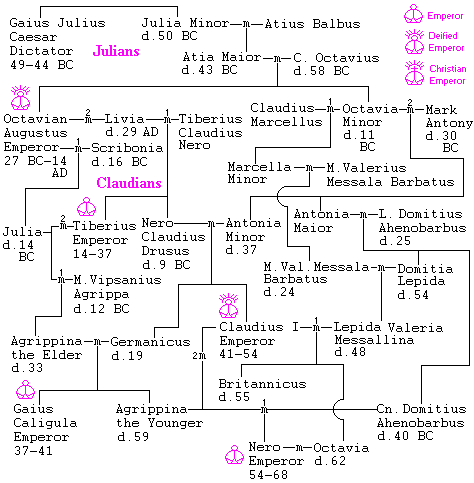 many people in the family to focus on the descent and relation of the
Emperors. Caligula and Nero are descendants of Augustus, through his daughter
Julia (from his first marriage); but Claudius and Nero are also descendants of
Mark Antony, who of course committed suicide, shortly before Cleopatra, rather
than be captured after his defeat by Augustus.
many people in the family to focus on the descent and relation of the
Emperors. Caligula and Nero are descendants of Augustus, through his daughter
Julia (from his first marriage); but Claudius and Nero are also descendants of
Mark Antony, who of course committed suicide, shortly before Cleopatra, rather
than be captured after his defeat by Augustus.
The use of crowns to indicate the emperors is at this point anachronistic,
but it is convenient. The crown for Christian Roman Emperors, which of course
will not occur until Constantine, is shown with a nimbus, like deified earlier
Emperors, because they are always portrayed with halos, like Saints, and are
said to be the "Equal of the Apostles."
| 4. KINGS OF NUMIDIA | |
|---|---|
| Masinissa | c.215-149 |
| Gulussa & Mastanabal |
149-c.145 |
| Micipsa | 149-118 |
| Adherbal & Hiempsal I |
118-116 |
| Jugurtha | 118-105 |
| War with Romans, 112-106 | |
| Gauda | 105-? |
| Hiempsal II | c.88-c.50 |
| Juba I | c.50-46 |
| Juba II | c.30 BC-c.22 AD |
| Ptolemy | c.22 AD-40 |
| Roman Province | |
| 5. LEADERS & KINGS OF JUDAEA | |
|---|---|
| Hasmoneans | |
| Judas Maccabaeus | 167-161 |
| Jerusalem Occupied, 164 | |
| Jonathan | 161-143 |
| Simon | 142-135 |
| John Hyrcanus I | 135-105 |
| Aristobulus | 104-103 |
| Alexander Jannaeus | 103-76 |
| Salome Alexandra | 76-67 |
| Aristobulus II | 67-63 |
| Pompey captures Jerusalem, 63 | |
| Hyrcanus II | 63-40 |
| Antigonus | 40-37 |
| Herodians | |
| Herod I the Great | King, 37-4 BC |
| Archelaus | Ethnarch, 4 BC-6 AD |
| Herod II Antipas | Tetrarch, 4 BC-39 AD |
| Philip | Tetrarch, 4 BC-37 AD |
| Herod Agrippa I | King, 37-44 |
| Agrippa II | King, 50/53-100? |
| Jewish Revolt & War, 66-73: Destruction of Jerusalem, 70 AD; Fall of Masada, 73; Revolt of Bar Kokhba, 132-135 | |
The hard won independence of Judaea fell within a century to Rome, which for
a time, as elsewhere, tolerated a fiction of local rule -- the Herodian dynasty
owed its power entirely to Roman favor. This did not mollify the Messianic
hotheads, who inevitably sparked a rebellion that led to the final destruction
of the Temple, the end, in a sense, of ancient Judaism, massacres and mass
suicides, as at Masada, and the increasing Diaspora of Jews into the Roman
world. Out of this also came the story of a peaceful Messiah, who had been
executed and resurrected, whose cult eventually overwhelmed Rome itself,
transforming Hellenistic Romanism into a culture of both Athens and Jerusalem.
Jews themselves derived little enough benefit from this transformation, since
Pauline Christianity had repudiated the ritual requirements of the Law and the
new religion became increasingly estranged from the old. Once the new religion
became the State Religion of Rome, the rigor with which Judaism had rejected the
old gods now became public policy, to their own disability. Christianity never
had the provision found in Islam, however grudging, for the toleration, within
limits, of kindred religionists. The fate of Jews in Christendom thus became a
matter of local preference, though no less an authority than St. Augustine said
that Jews should be tolerated so that the Biblical prophecies of the Coming of
Christ would be preserved by a disinterested, or even hostile, source.
Augustine, interestingly, did not doubt that Jews could be trusted to faithfully
preserve the Hebrew text of the Bible -- as they did.
The genealogy of the Hasmonaeans is from The Complete World of The Dead
Sea Scrolls (Philip R. Davies, George J. Brooke, & Phillip R. Callaway,
Thames & Hudson Ltd., 2002, p.42). The incestuous marriages of the children
and grandchildren of Herod the Great, perhaps typical of a Hellenistic dynasty,
like the Ptolemies, were
very hard to understand. 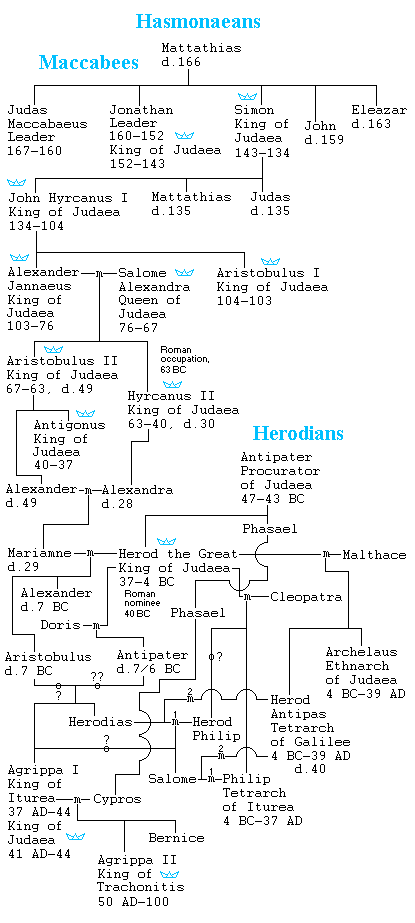 The chart in my edition of Josephus (The Jewish War, Penguin
Classics, 1960, p.410) did not make things very clear, but then my colleague Don
Smith helped straighten things out for me. There seems to be some question about
the parentage of Herodias and Agrippa I -- with Davies, Brooke, & Callaway
going for Aristobulus. Aristobulus and his brother Alexander, descendants of the
Hasmonaeans through their mother, were both executed by Herod.
The chart in my edition of Josephus (The Jewish War, Penguin
Classics, 1960, p.410) did not make things very clear, but then my colleague Don
Smith helped straighten things out for me. There seems to be some question about
the parentage of Herodias and Agrippa I -- with Davies, Brooke, & Callaway
going for Aristobulus. Aristobulus and his brother Alexander, descendants of the
Hasmonaeans through their mother, were both executed by Herod.
Since Mediaeval Jews shared in the continuing trade and commercial culture of
the Middle East, and were often its only representatives in impoverished and
ruralized Latin Europe, they became fatefully associated in European eyes with
the commercial and financial practices that Europeans at once needed, wanted,
misunderstood, and resented.  A similar problem later occurred all over again in Eastern Europe,
where the Kings of Poland were eager to bring in a more sophisticated
population, unwelcome in Western Europe, to develop the country and strengthen
the throne. Such resentments in time found theoretical expression in Marx's view
that the Jews embodied the archetype of grasping and exploitive capitalism. This
made them class enemies, but that was soon enough converted into race
enemies when Marxism mutated into Fascism and Naziism. Jews who thought they had
escaped the class and race animus in the Soviet Union soon came to be suspected,
purged, and, increasingly, murdered by Stalin, while Hitler, of course, decided
to kill them all. This helped promote the idea, not surprisingly, that all Jews
should return to Palestine and found a Jewish State, which is what happened.
After 2000 years, however, the Zionists found that they didn't have a lot in
common with the modern Arabic speaking population of the place they returned to
-- rather than learn Arabic, they even decided to revive Hebrew, which was
already dying out as a spoken language in the days of the Hasmoneans, and which
some Jews refused to speak as being a sacred language (they still speak
Yiddish). After fifty years, this conflict between Israel and Arab
Palestinians has still not been resolved.
A similar problem later occurred all over again in Eastern Europe,
where the Kings of Poland were eager to bring in a more sophisticated
population, unwelcome in Western Europe, to develop the country and strengthen
the throne. Such resentments in time found theoretical expression in Marx's view
that the Jews embodied the archetype of grasping and exploitive capitalism. This
made them class enemies, but that was soon enough converted into race
enemies when Marxism mutated into Fascism and Naziism. Jews who thought they had
escaped the class and race animus in the Soviet Union soon came to be suspected,
purged, and, increasingly, murdered by Stalin, while Hitler, of course, decided
to kill them all. This helped promote the idea, not surprisingly, that all Jews
should return to Palestine and found a Jewish State, which is what happened.
After 2000 years, however, the Zionists found that they didn't have a lot in
common with the modern Arabic speaking population of the place they returned to
-- rather than learn Arabic, they even decided to revive Hebrew, which was
already dying out as a spoken language in the days of the Hasmoneans, and which
some Jews refused to speak as being a sacred language (they still speak
Yiddish). After fifty years, this conflict between Israel and Arab
Palestinians has still not been resolved.
By some estimates, e.g. Paul Johnson in his A History of the Jews [HarperPerennial, 1988], Jews constituted as much as 10% of the population of the Roman Empire. I am not familiar with the basis of this estimate, but I am familiar with the difficulty of estimating Roman population at all. I find so high a figure inherently improbable. Judaea, although the "land of milk and honey" in the Bible, is a pretty barren place. This is not going to support a large population, especially on the basis of ancient agriculture. That there should be as many Jews there as, for instance, Egyptians is impossible. Of course, a large part of the estimate is based on the Diaspora population. Even in the time of the Ptolemies, Alexandria already had a very large Jewish population. But that is a key point: the Diaspora population is mostly going to be urban; but the urban population of the Roman Empire is unlikely to have been more than 20% of the whole. Even today, 85% of the population of Tanzania, whose growth was ruined by the socialism of its post-independence government, is still in agriculture. If the population of the Empire was as much as 20% urban, and Jews were 10% of the population, then Jews would have to constitute nearly half of the population of every city, especially including Rome itself (which may have had a population of over a million people at one point -- it could only be fed by surplus grain from North Africa and Egypt). That is nothing like the impression we get from the records, where so large a group in Rome would be felt on a constant basis. So this "10%" seems like a gravely inflated figure, though we may never have a really accurate one.
When Jerusalem fell to Titus, the Temple and most of the city were demolished. The furniture and sacred vessels of the Temple, including, Josephus says, the red curtains of the Inner Sanctuary, were carried off to Rome -- portrayed on the Arch of Titus (through which mediaeval Jews refused to walk). They remained there until 455, when the Vandals sacked the city and removed their loot to Carthage. When Belisarius overthrew the Vandals for Justinian in 533 and found the items from the Temple in Carthage, they were sent back to Constantinople. There they disappear from history. There is no reason not to think that they were safely kept, along with all the rest of the Classical heritage, at Constantinople, at least until the looting of the city by the Fourth Crusade in 1204. At that point many treasures were carried off, largely to Venice. There is no mention, however, except for the fabulous stories about the Templars, of anything, generally or specifically, from the Temple in Jerusalem being found by the Crusaders, and nothing of the sort has ever subsequently been noticed kept at Venice or elsewhere. The great Menôrâh of the Temple, described in detail by Josephus and shown on the Arch, is certainly not something to be easily overlooked. We are thus left with a considerable mystery, and it is a little surprising that there are not, at least, legends about the fate of the Temple items.
Since it has previously been noted
that the Ark of the Covenant, despite Raiders of the Lost Ark (1981), was
not carried off to Tanis, one might wonder what subsequently happened to it.
Although Josephus speaks of Titus taking away "the Law," he describes nothing
like the Ark. Later, Mediaeval sources (e.g. Mirabilia Urbis Romae,
c.1143, The Marvels of Rome, Italica Press, New York, 1986, p.29) speak
of the Ark having been in Rome, but this was long, long after the fact. It must
not be forgotten, however, that the Temple had once before been destroyed, by Nebuchadnezzar, in 587 BC.
It is not clear that anything of the Temple survived, and so the Ark could well
have been destroyed then -- or concealed on the Temple Mount, where the Templars
supposedly found it.

The maps here begin with Rome at its height under Trajan. The traditional
notion that Trajan marched all the way down to the Persian Gulf now seems open
to question, but he certainly annexed a good part of Mesopotamia, as well as
Armenia and Dacia. These, as it happened, were all the most organized states on
the borders of Rome, excepting only Kush. The Pax
Romana thus was often a matter of war on the frontiers in order to preserve
the peace within. But when Hadrian withdrew from some of Trajan's conquests, he
was then troubled by the revolt of Bar Kochba in Judaea.
| 7. FLAVIANS & ANTONINES | |
|---|---|
| Vespasian T. Flavius Vespasianus |
69-79 |
| Jewish Revolt & War, 66-73: Destruction of Jerusalem, 70 AD; Fall of Masada, 73 | |
| Titus T. Flavius Vespasianus |
79-81 |
| Eruption of Mt. Vesuvius, 79; Colosseum dedicated, 80 | |
| Domitian T. Flavius Domitianus |
81-96 |
| Nerva M. Cocceius Nerva |
96-98 |
| Trajan M. Ulpius Traianus |
97-117 |
| Dacia conquered, 101-106; Nabataean Petra annexed, 106; Armenia & Mesopotamia annexed, 114; Jewish Revolt, 115-117 | |
| Hadrian P. Aelius Hadrianus |
117-138 |
| Bar Kochba's Revolt in Judaea, 132-135 | |
| Antoninus Pius T. Aurelius Fulvus Boionius Arrius Antoninus |
138-161 |
| Lucius Verus L. Aurelius Verus |
161-169 |
| Parthian War, 162-168 | |
| Marcus Aurelius M. Aurelius Antoninus |
161-180 |
| German War, 168-175 | |
| Commodus M. Aurelius Commodus Antoninus |
177-192 |
| non-dynastic | |
| Pertinax P. Helvius Pertinax |
193 |
| Didius Julianus M. Didius Severus Julianus |
193 |
| buys throne from Praetorian Guard for 25,000 sesterces per man | |
| Niger C. Pescennius Niger Justus |
in Syria, 193-194 |
| Clodius Albinus Decimus Clodius Albinus |
in Britain & Gaul, 193-197 |
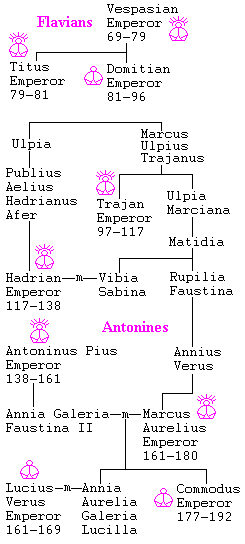 He was succeeded by a fraternity of soldiers who adopted each other
to secure competent and peaceful succession. The "Five Good Emperors" (in
boldface) became the ideal of generations, all the way to Gibbon, for peaceful
and benevolent government. Trajan was the first Emperor born in the provinces
(Spain) and briefly, with his Mesopotamian campaign, expanded the Empire to its
greatest extent. In the Middle Ages, Trajan had such a powerful reputation for
goodness that the story began to circulate that God had brought him back to life
just so he could convert to Christianity. Dante even includes that in the
Divine Comedy. Antoninus Pius became the only Roman Emperor in 1500 years
to be called "the Pious," but we really know precious little about his reign,
which is only covered by the poor Historia Augusta. This may simply
illustrate the principle that goodness and peace (the height of the "Pax
Romana") is boring. The peace ended under Marcus Aurelius, the closest thing to
a "philosopher king" until Thomas Jefferson, but also a very competent general,
who smashed a major German invasion across the Danube, while consoling himself
with Stoicism for the
miseries of war, plague, and personal loss. Marcus's only real failure was to
leave the Empire to his worthless son, Commodus -- dying in a place of modern
note, Vienna
(Vindobona). Hereditary succession, although eventually stabilized in
Constantinople, would prove a dangerous principle at many moments in Roman
history. The incompetence and viciousness of Commodus then set off his
assassination and the second great free-for-all fight for the throne, in 193.
This was not without its comic aspect, when the Praetorian Guard killed the
disciplinarian Pertinax and literally put the throne up for sale. The wealthy
Didius Julianus made the best bid but had no other ability to secure his rule.
He was murdered as Septimius Severus, a notably humorless man, approached Rome
-- and then also abolished the Guard.
He was succeeded by a fraternity of soldiers who adopted each other
to secure competent and peaceful succession. The "Five Good Emperors" (in
boldface) became the ideal of generations, all the way to Gibbon, for peaceful
and benevolent government. Trajan was the first Emperor born in the provinces
(Spain) and briefly, with his Mesopotamian campaign, expanded the Empire to its
greatest extent. In the Middle Ages, Trajan had such a powerful reputation for
goodness that the story began to circulate that God had brought him back to life
just so he could convert to Christianity. Dante even includes that in the
Divine Comedy. Antoninus Pius became the only Roman Emperor in 1500 years
to be called "the Pious," but we really know precious little about his reign,
which is only covered by the poor Historia Augusta. This may simply
illustrate the principle that goodness and peace (the height of the "Pax
Romana") is boring. The peace ended under Marcus Aurelius, the closest thing to
a "philosopher king" until Thomas Jefferson, but also a very competent general,
who smashed a major German invasion across the Danube, while consoling himself
with Stoicism for the
miseries of war, plague, and personal loss. Marcus's only real failure was to
leave the Empire to his worthless son, Commodus -- dying in a place of modern
note, Vienna
(Vindobona). Hereditary succession, although eventually stabilized in
Constantinople, would prove a dangerous principle at many moments in Roman
history. The incompetence and viciousness of Commodus then set off his
assassination and the second great free-for-all fight for the throne, in 193.
This was not without its comic aspect, when the Praetorian Guard killed the
disciplinarian Pertinax and literally put the throne up for sale. The wealthy
Didius Julianus made the best bid but had no other ability to secure his rule.
He was murdered as Septimius Severus, a notably humorless man, approached Rome
-- and then also abolished the Guard.
| 8. SEVERANS | |
|---|---|
| Septimius Severus L. Septimius Severus |
193-211 |
| prohibition of conversions to Judaism or Christianity, 202 | |
| Caracalla M. Aurelius (Septimius Bassianus) Antoninus |
198-217 |
| Geta P. Lucius Septimius Geta |
209-211 |
| Roman Citizenship to all free persons, 212 | |
| Macrinus M. Opellius Macrinus |
217-218 |
| Diadumenian M. Oppellius Diadumenianus |
218 |
| Elagabalus M. Aurelius Antoninus |
218-222 |
| Alexander Severus M. Aurelius Alexander |
222-235 |
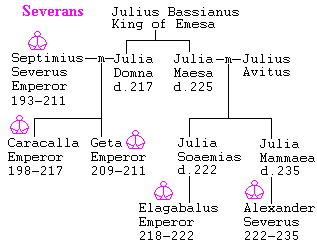 This set off another brief free-for-all, until loyalty to the
Severan family prevailed. The "family," however, turned out to be the entirely
matrilineal creation of Severus' sister-in-law, Julia Maesa, who brought her two
grandsons, entirely unrelated to Severus, to the throne. The bizarre Elagabalus
(sometimes "Heliogabalus"), styling himself the god of his grandmother's Syrian solar cult (and
engaging gladiators in combats more amorous and carnal than Commodus had
contemplated), and then the amiable and reasonably effective Alexander thus
wrapped up the dynasty. Alexander was killed after the overdue reality check of
battle, against the newly aggressive Persians. He was not that bad,
but evidently not good enough for his own troops, who killed him and his mother
-- that his mother was along with him on a military campaign probably seemed no
better to the soldiers than it does now. Septimius Severus himself was one of
the two Roman Emperors (Constantius Chlorus was
the other) to die (a natural death) at York (Eboracum) in Britain.
This set off another brief free-for-all, until loyalty to the
Severan family prevailed. The "family," however, turned out to be the entirely
matrilineal creation of Severus' sister-in-law, Julia Maesa, who brought her two
grandsons, entirely unrelated to Severus, to the throne. The bizarre Elagabalus
(sometimes "Heliogabalus"), styling himself the god of his grandmother's Syrian solar cult (and
engaging gladiators in combats more amorous and carnal than Commodus had
contemplated), and then the amiable and reasonably effective Alexander thus
wrapped up the dynasty. Alexander was killed after the overdue reality check of
battle, against the newly aggressive Persians. He was not that bad,
but evidently not good enough for his own troops, who killed him and his mother
-- that his mother was along with him on a military campaign probably seemed no
better to the soldiers than it does now. Septimius Severus himself was one of
the two Roman Emperors (Constantius Chlorus was
the other) to die (a natural death) at York (Eboracum) in Britain.
A bit of an intellectual revival took place at the court of
Septimius Severus. This has been called the "Second Sophistic" and was largely
due to the interests of Julia Domna. In a history of the sophists written at the
time, by Philostratus, he says that Julia attracted a circle of mathematicians
and philosophers. However, this actually meant something more like "astrologers
and sophists," and the revival was more of a retrospective on ancient philosophy
than a movement that contributed much original or of interest to it.
Nevertheless, such an inspiration and preoccupation has been compared to similar
concerns in the Renaissance. A
characteristic of the Second Sophistic, which we see in the earlier historian,
philosopher, and official (he repelled the Alans from Cappadocia) Arrian of
Nicomedia (c.87-c.145 AD, Consul 129), is the movement to write in Attic Greek, rather than
in the Koiné of the Hellenistic Period. This is usually dismissed as an
affectation and a frivolity. Perhaps it was, but it is also directly comparable
to the concern of Renaissance writers to restore the "purity" of Ciceronian
Latin over the received Mediaeval Latin that had survived to their time.
Renaissance writers are rarely belabored for affectation because of this. Attic
Greek and Ciceronian Latin, indeed, are languages we do not want forgotten --
while they are in greater danger in our time than ever before: a
Shakespeare with "little Latin and less Greek" is a scholar of Classics compared
to most graduates of modern universities.
B. CRISIS OF THE THIRD CENTURY, 235-284, 49 Years

This map looks like it should be from the Fifth
Century. The Goths, not yet divided, are here, but they come in part
by boat, which we will not see with them later. The Franks here duplicate the
later course of the Vandals, through Gaul,
Spain, and North Africa, but without the same effects. Later, the Franks will not be a principal
invader but will be the ultimate beneficiary of the invasions. The Alemanni also will be
less active later, remaining in Germany and leaving their name as the word for
"German" in Romance languages. Rome is weakened by revolt in the West and a
Palyrmene takeover in the East. But in this era Roman institutions prove
resilient enough to restore the status quo ante (with troubling strategic
withdrawals). But the Germans remain across the Rhine and Danube, growing in
numbers and sophistication. One might even say that all this was a dress
rehearsal for the later invasions. In the theater, if the dress rehearsal goes
poorly, the opening will go well. This is what happened.
The Gallic Empire of Postumus began under Gallienus. Postumus, of course,
probably would rather have overthrown the Emperor, but he was not able to defeat
him and was otherwise involved with fighting Germans. In best Third Century
tradition, he was killed by his troops. This form of succession continued until
Tetricus and his son surrendered to Aurelian, on condition of their peaceful
retirement. This episode echoes the attempt of the usurper Constantine in the
Fifth Century, though that failed to suppress the Germans in that era and merely
served to absorb the attention of Roman forces that could have been better used,
in conjunction with those of Constantine himself, against the common enemy. The
Palmyrene Empire had a very different origin and course. Odaenath, the King of
Palmyra (c.260-266), was a Roman ally. After the capture of Valerian, he
actually defeated and expelled the victorious Persians. This earned him Roman
gratitude and titles, like Dux Romanorum. It also left him as the de
facto ruler of the East. Odaenath was murdered and succeeded by his wife
Zenobia, who then joins Cleopatra and Boudicca (Boadicea), if not Dido, in the
ranks of the conspicuous and romantic female enemies of Rome. This grew
gradually, as Roman weakness tempted Zenobia's ambition. When she moved into
Egypt and Asia Minor in 269-270, trouble was definitely brewing, but it was her
proclamation of her son Vaballathus as Emperor that brought Aurelian out against
her. She was exhibited in Aurelian's Triumph but then allowed to live out her
life on a pension in Rome. Palmyra became a Roman outpost. Today, its ruins are
extensive, beautiful, and evocative, out in the emptiness of the Syrian desert,
next to the Oasis and the small modern city. The Oasis gave the city its
importance as an essential link in the caravan short-cut across the desert from
Mesopotamia to Syria. Even greater enemies of Rome have far less to show for
themselves today.
| Maximinus I Thrax C. Julius Verus Maximinus |
235-238 | SONS, BROTHERS, etc. | |
|---|---|---|---|
| Gordian I Africanus M. Antonius Gordianus Sempronianus |
238 | Gordian II M. Antonius Gordianus Sempronianus |
238 |
| Balbinus & Pupiens D. Caelius Calvinus Balbinus & M. Clodius Pupienus Maximus |
238 | ||
| Gordian III M. Antonius Gordianus |
238-244 | ||
| Philip I the Arab M. Julius Philippus |
244-249 | Philip II M. Julius Severus Philippus |
247-249 |
| Decius C. Messius Quintus Decius |
249-251 | Herennius Q. Herennius Etruscus Messius Decius |
251 |
| Hostilian C. Valens Hostilianus Gallus |
251 | ||
| Trebonianus Gallus C. Vibius Trebonianus Gallus |
251-253 | Volusian C. Vibius Afinius Gallus Veldumnianus Volusianus |
253 |
| Aemilian M. Aemilius Aemilianus |
253 | ||
| Valerian I P. Licinius Valerianus |
253-260 | Valerian II P. Licinius Cornelius Valerianus |
Caesar, 253-258 |
| Saloninus P. Licinius Cornelius Saloninus Valerianus |
255-259 | ||
| Gallienus P. Licinius Egnatius Gallienus |
253-268 | ||
| German invasions, 257; defeated and captured by the Sassanid Shâh Shapur I, 260 | |||
| Postumus M. Cassianius Latinius Postumus |
in Gaul, 259-268 | ||
| invasion by the Goths, 267 | |||
| Claudius II Gothicus M. Aurelius Claudius |
268-270 | Quintillus M. Aurelius Quintillus |
270 |
| Defeat of Goths, 269 | |||
| Victorianus M. Piavonius Victorinus |
in Gaul, 268-270 | ||
| Tetricus I C. Pius Esuvius Tetricus |
in Gaul, 270-273 |
Tetricus II C. Pius Esuvius Tetricus |
270-273 |
| Zenobia Septimia Zenobia |
Palmyra, 267-272 |
Vaballathus L. Julius Aurelius Septimius Vaballathus Athenodorus |
270-273 |
| Aurelian L. Domitius Aurelianus |
270-275 | ||
| Withdrawal from Dacia, 271 | |||
| Tacitus M. Claudius Tacitus |
275-276 | Florian M. Annius Florianus |
276 |
| Probus M. Aurelius Probus |
276-282 | ||
| Carus M. Aurelius Carus |
282-283 | Numerian M. Aurelius Numerianus |
283-284 |
| Carinus M. Aurelius Carinus |
283-285 | ||
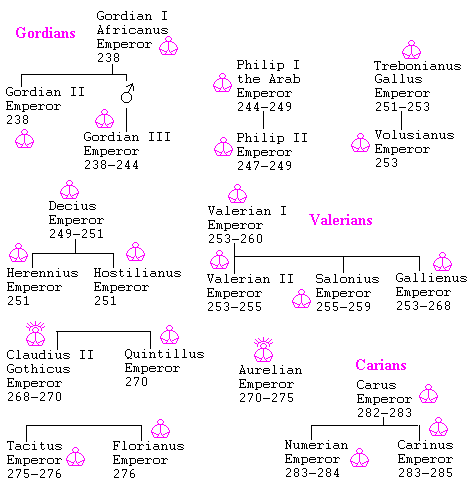 Not much in the way of dynasties in this period. Many Emperors, of
course, wanted to associate their sons with them to arrange for their
succession; but in the violent ends of most Emperors, the sons usually died with
them. Gordian III, Gallienus, and Carinus are the principal exceptions, ruling
in their own right after the death of fathers or, with Gordian, uncle and
grandfather.
Not much in the way of dynasties in this period. Many Emperors, of
course, wanted to associate their sons with them to arrange for their
succession; but in the violent ends of most Emperors, the sons usually died with
them. Gordian III, Gallienus, and Carinus are the principal exceptions, ruling
in their own right after the death of fathers or, with Gordian, uncle and
grandfather.
The invasions and political troubles of the Third Century shook the religious
and philosophical certainties upon which Rome had previously thrived. Exotic
religious cults, like Mithraism and Christianity, now began to exert wide
appeal; and a profound shift occurred in philosophy. We no longer hear much of
Stoics or Epicureans, but whole new perspectives and concerns are ushered in by
the mystical Egyptian Plotinus (d.270), who
even enjoyed some Imperial patronage under Gordian III, Philip the Arab, and
Gallienus. He makes the Second Sophistic look superficial indeed. With his
return to the epistemology and metaphysics of Plato and Aristotle, Plotinus, as
such the founder of Neoplatonism, picks up the mainstream of development of the
Western philosophical tradition, which had somewhat detoured in the Hellenistic Period through
revivals of Presocratic doctrine (Heraclitus for the Stoics, Atomism for the
Epicureans). Plotinus's student, disciple, Boswell, and editor Porphyry
(d.>300), who enjoyed patronage from Aurelian, promoted Neoplatonic
principles, wrote an introduction to Aristotle's logical works, the
Isagoge, which became an indispensable text in the Middle Ages, and even
began organizing the defense of traditional religion in his Against the
Christians -- though the Neoplatonic version of traditional religion now
looks much more of a piece with Christian sensibilities than with things like
the peculiar and archaic practices examined by Frazer in The Golden
Bough. The cultural and intellectual sea change of the period, soon followed
by Diocletian's reforms and then Constantine, usher in the distinctive world of
Late Antiquity. Classicists start to become nervous and irritable.
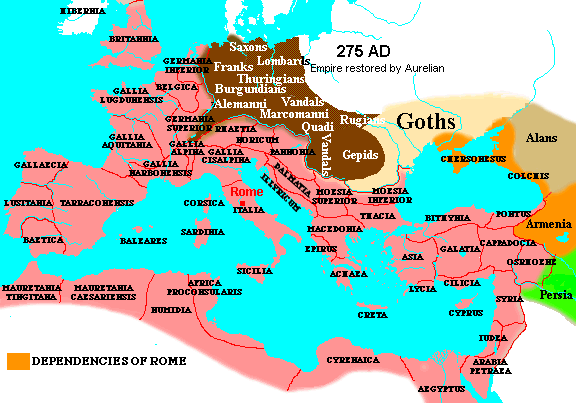
275
AD
 II. SECOND EMPIRE, EARLY "ROMANIA," 284 AD-610 AD, Era of Diocletian
1-327, 326 years
II. SECOND EMPIRE, EARLY "ROMANIA," 284 AD-610 AD, Era of Diocletian
1-327, 326 years
| L'altro che segue, con le leggi e
meco, sotto buona intenzion che fé mal frutto, per cedre al pastor si fece greco: | The next who follows, with the laws and me, with a good intention which bore bad fruit, made himself Greek, to cede to the Pastor. |
| ora conosce come il mal dedutto dal suo bene operar non li è nocivo, avvegna che sia 'l mondo indi distrutto. |
Now he knows how the evil derived from his good action does not harm him, though the world should be destroyed thereby. |
The "Second Empire" is a period of transformation whose beginning and end seem worlds apart. Even at the beginning, however, Classicists find themselves becoming uncomfortable, in large part because they are now rubbing shoulders with Byzantinists, Mediaevalists, and, worse, historians of religion and, gasp, even of the Church. In the Middle Ages, this was regarded as a triumphant period, when the Roman Empire was redeemed and ennobled with its conversion to and transformation by Christianity -- becoming a "Romania" whose name is now not even familiar as the name of the Roman Empire. In Modern thought, this construction tends to be reversed, with the superstition and dogmatism of Christianity dragging the Classical World down into the Dark Ages. At the same time, however, there is still a strong attraction to the idea of blaming the collapse of the Empire on the characteristics of pagan Roman society -- slavery, the Games, sexual license, corruption, etc. Since this is more or less the Christian critique of pagan society, we have the curious case of critics maintaining the perspective of Christian moralism even while rejecting Christianity as the appropriate response. This not entirely coherent approach also results in the doublethink of moral satisfaction with the "fall" of the (Western) Empire in 476 while carefully ignoring the survival and resurgence of the Empire in the East. The truth, as it happens, is one of continuity. The very same institutions, both Roman and Christian in sum and detail, that failed in the West in the face of the German threat, did just fine in the East, long outlasting, and in two dramatic cases defeating, the German successor kingdoms. What neither Trajan nor Constantine nor Justinian could have anticipated were the blows that would fall next.
A. "DOMINATE," 284-379, 95 years
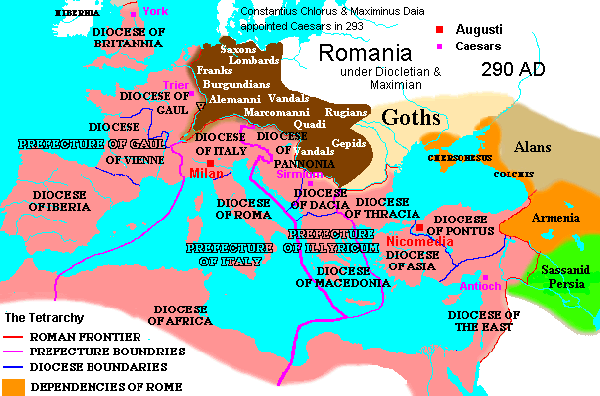
290
AD
| 1. TETRARCHS | ||
|---|---|---|
| Diocletian C. Aurelius Valerius Diocletianus |
Augustus 284-305, 286-305 East |
retired 305, died 311 or 313 |
| Maximian M. Aurelius Valerius Maximianus |
Augustus 286-305 West | Usurper 306-308, 310 West |
| Constantius I Chlorus Fl. Valerius Constantius |
Caesar 293-305 West | Augustus 305-306 West |
| Galerius C. Galerius Valerius Maximianus |
Caesar 293-305 East | Augustus 305-311 East |
| Maximinus II Daia Galerius Valerius Maximinus |
Caesar 305-309 East | Augustus 309-313 East |
| Severus Fl. Valerius Severus |
Caesar 305-306 West | Augustus 306-307 West |
| Constantine I the Great Fl. Valerius Constantinus |
Caesar 306-307 West, 308-309 West |
Augustus 307-308 West, 309-337 West, 324-337 East |
| [Maxentius M. Aurelius Valerius Maxentius] |
Usurper 306-312, Italy | |
| Licinius Valerius Licinianus Licinius |
Augustus 308-324 East | |
| [Domitius Alexander] | Usurper 308-311, Africa | |
In 305 Diocletian actually retired from office, going to live at his
retirement villa (more like city) at Split (Spalatum) near Solin (Salonae) in
Dalmatia (now Croatia) -- see J.J.
Wilkes, Diocletian's Palace, Split: Residence of a Retired Roman
Emperor [Oxbow Books, Oxford, 1986, 1993]. This may have been at the urging
of Galerius, who was eager for full power, and was taken with ill grace by
Maximian, who tried to return to power twice and was finally killed. By 308,
with Severus killed by Maximian's son Maxentius and Constantine proclaimed
Augustus by his troops, Diocletian was called to a conference at
Carnuntum on the Danube in Upper (Superior) Pannonia (just down the river
from modern Vienna, Roman Vindobona). Diocletian was even offered the throne,
but declined it -- saying he would rather grow vegetables. The result of the
conference was the demotion of Constantine to Caesar (again), the appointment of
Lincinius as Augustus, the second retirement of Maximian, and the declaration of
Maxentius as an outlaw. A noteworthy act at the conference was the dedication of
an altar to the god Mithras, as the fautor imperii, "protector of the
Empire." Mithraism considered Mithras to be a sun god, associated and
assimilated with Sol Invictus, the "Unconquered Sun," whose cult existed
independently of Mithras and had been promoted since Aurelian. Mithraism,
although popular in the Army (only men were initiated), was not an Imperial or
prestige cult, until this dedication, Deo Soli Invicto Mithrae, "to the
god Mithras the Unconquered Sun." We might see this as one of the last acts in
the development of state paganism, before Constantine becomes a patron of
Christianity and gods like Mithras disappear.
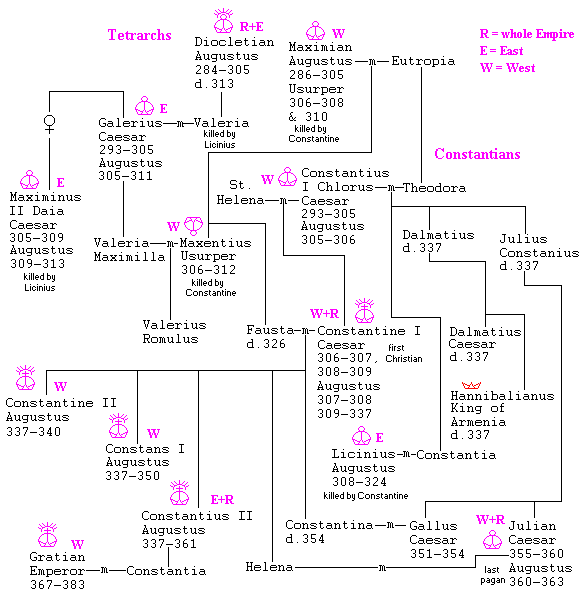
One of the most famous aspects of Diocletian's rule is the famous "Edict on Maximum Prices" of 301 AD. Since Diocletian himself explains the law as needed to prevent some from profiteering off of the basic needs of others, this is turns out to be relevant to many modern debates. The "greed" of those who make a profit while prices rise is still a point of useful political appeal for many politicians and leftist activists. It looks, however, like prices, especially agricultural prices, were rising under Diocletian because the tax burden had become so large that many people simply abandoned their farms -- Diocletian also tried forbidding this. Since Dioceltian himself was not a sympathetic person to Christian writers, the charge of "greed" tends to get turned around, as the contemporary writer Lactantius, appointed by Diocletian himself as a professor of Latin literature in Nicomedia, the capital, says, "...Diocletian with his insatiable greed..." Lactantius' account of bureaucratic excess and behavior could apply in many modern situations:
The number of recipients began to exceed the number of contributors by so much that, with farmers' resources exhausted by the enormous size of the requisitions, fields became deserted and cultivated land was turned into forest. To ensure that terror was universal, provinces too were cut into fragments; many governors and even more officials were imposed on individual regions, almost on individual cities, and to these were added numerous accountants, controllers and prefects' deputies. The activities of all these people were very rarely civil... [J.J. Wilkes, Diocletian's Palace, Split: Residence of a Retired Roman Emperor, op. cit., p.5]
Not only now are there whole countries where the dependent classes exceed the numbers of the productive classes (e.g. Italy or France), but in the United States the fate of the Social Security system will probably be sealed when the number of beneficiaries exceeds the number of contributors. These modern systems, although voted in by popular majorities who like "free lunch" welfare politics, are run by bureaucrats whose behavior, of course, is "very rarely civil" either to contributors or beneficiaries. And modern bureaucrats are protected from accountability by "Civil Service" status and their own politically active and powerful public employee labor unions. Yet politicians rarely characterize or criticize such people for their own self-interest or greed, although this phenomenon is now well understood and described in Public Choice economics. While the behavior of the bureaucrats is understandable, the harshest truth is that, with sovereignty no longer invested in a autocrat like Diocletian, the ultimate "greed" today is derived from the voters.
The map reflects some recent developments in scholarship. Previously, the
Goths were regarded as already divided into the Visigoths and Ostrogoths, with the
Ostrogoths developing an "empire" that was thought to have stretched all the way
back to the Baltic Sea. This culminated under King Ermanaric (i.e. "King [riks]
Herman," where "Herman" itself is from [h]er[i], "army," and man, "man"), who
committed suicide when defeated and subjugated by the Huns around 370. Now it
looks like, for all their divisions, the Goths were not divided, or identified,
in the terms that later became familiar for the Kingdoms in Spain and Italy.
Ermanaric was King of the Greuthungi, and it is unlikely that he ruled a
domain that stretched to the Baltic. Indeed, it doesn't even look like it even
reached the Don in the east. The Goths who were granted asylum on Roman
territory in 376 were the Tervingi, led by Alavivus and Fritigern. After
their revolt, however, the Greuthungi joined the Tervingi. With some other
Gothic groups, these all became the Visigoths. The Ostrogoths developed
later, around a core led by the Amal dynasty. These changes in view are now
recently explained by Peter Heather in The Fall of the Roman Empire
[Oxford, 2006]. Although the Huns subjugated all the Goths but the Visigoths,
the Goths nevertheless exercised considerable cultural influence on them. Thus,
we find Attila with a Gothic name, "Little Father." But while atta was
the Gothic word for "father," it is curious that ata is still the
Turkish word for "father." Indeed, adda was Sumerian for
"father." Winfred P. Lehmann (A Gothic Etymological Dictionary, E.J.
Brill, Leiden, 1986, p.46) explains these correspondences as a coincidence of
"nursery words" -- "No need to assume borrowing in spite of earlier
attestations, such as Hitt[ite] attas, which Puhvel [Hittite
etymological dictionary, 1984] derives 'from infantile language'" [p.46].
This strikes me as a bit unsatisfactory, though perhaps no more than the
alternative: that this is another fragment of evidence for a connection
between Indo-European and
Altaic languages, and Sumerian.
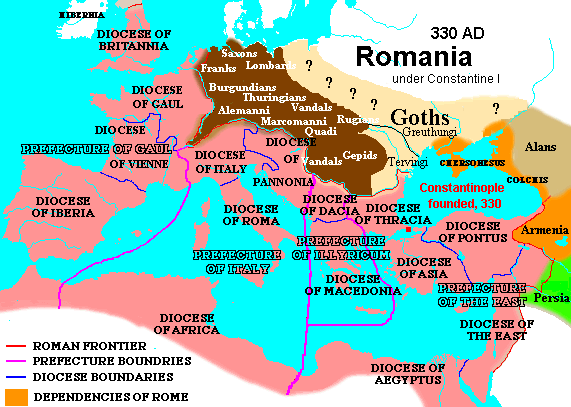
| 2. CONSTANTIANS | |
|---|---|
| Constantius I Chlorus Fl. Valerius Constantius |
293-306 W |
| Constantine I the Great Fl. Valerius Constantinus |
306-337 W+E |
| Christianity legalized, 312; Ecumenical Council I, Nicaea I, Nicene Creed, 325; Constantinople, Roma Nova, founded, construction begun, 4 November 328; Constantinople dedicated, 11 May 330 | |
| Constantine II Fl. Claudius Contantinus |
337-340 W |
| Constans I Fl. Julius Constans |
337-350 W |
| [Magnentius Fl. Magnus Magnentius] |
350-353 W |
| Constantius II Fl. Julius Constantius |
337-361 E+W |
| Gallus Fl. Claudius Constantius Gallus |
351-354 E, Caesar |
| Julian the Apostate Fl. Claudius Julianus |
355-360 W, Caesar; 360-363, Augustus |
| non-dynastic | |
| Jovian Fl. Jovianus |
363-364 |
 The earliest mention of anything of the sort, by Lactantius again,
is that Constantine had a dream where he was shown the "cypher of
Christ," the Greek letters Chi and Rho, which he caused to be put
on the shields of his soldiers. Later versions thus increase the dramatic and
miraculous elements of the event, using what later would become the most
symbolic of Christianity, the Cross. Using a Christian symbol in any form,
however, and for any reason, would have been dramatic enough. Constantine's
Empire went to his three sons, who might have shared it with their cousins, but
killed them instead. The sons, however, ended up with no heirs themselves, and
the last family member on the throne, Julian, was one of the cousins who had
escaped the massacre. Julian, whose own writings have been preserved, is one of
the better known but stranger figures of the century. Quixotically trying to
restore paganism, he only seemed to demonstrate that the old gods were spent and
nobody's heart was really in it anymore. Although apparently a fine enough
military commander against the Franks, Julian's short reign ended with another
Quixotic effort, against Persia. It was not so much the war itself as the ill
conceived scale of the invasion, which left Julian all but stranded with his
army, deep in Mesopotamia, with the Persians avoiding battle but constantly
harassing him. Somehow this had not happened to Alexander, Trajan, Heraclius, or the forces
of the Caliph Omar. It cost
Julian his life, and his religious cause, since the Christian Jovian was then
chosen by the Army.
The earliest mention of anything of the sort, by Lactantius again,
is that Constantine had a dream where he was shown the "cypher of
Christ," the Greek letters Chi and Rho, which he caused to be put
on the shields of his soldiers. Later versions thus increase the dramatic and
miraculous elements of the event, using what later would become the most
symbolic of Christianity, the Cross. Using a Christian symbol in any form,
however, and for any reason, would have been dramatic enough. Constantine's
Empire went to his three sons, who might have shared it with their cousins, but
killed them instead. The sons, however, ended up with no heirs themselves, and
the last family member on the throne, Julian, was one of the cousins who had
escaped the massacre. Julian, whose own writings have been preserved, is one of
the better known but stranger figures of the century. Quixotically trying to
restore paganism, he only seemed to demonstrate that the old gods were spent and
nobody's heart was really in it anymore. Although apparently a fine enough
military commander against the Franks, Julian's short reign ended with another
Quixotic effort, against Persia. It was not so much the war itself as the ill
conceived scale of the invasion, which left Julian all but stranded with his
army, deep in Mesopotamia, with the Persians avoiding battle but constantly
harassing him. Somehow this had not happened to Alexander, Trajan, Heraclius, or the forces
of the Caliph Omar. It cost
Julian his life, and his religious cause, since the Christian Jovian was then
chosen by the Army.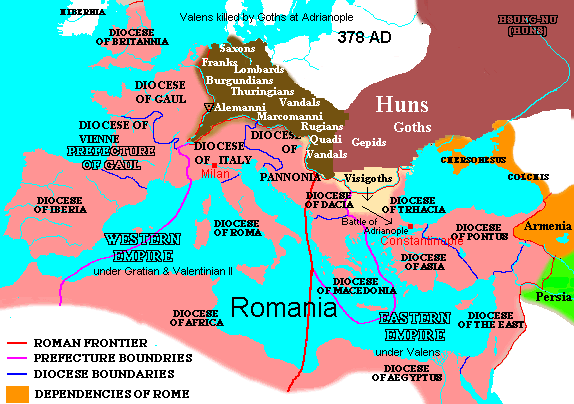
378
AD
| 3. VALENTIANS | |||
|---|---|---|---|
| Valentinian I Fl. Valentinianus |
364-375 W | Valens Fl. Valens |
364-378 E |
| Gratian Fl. Gratianus |
367-383 W | great earthquake in Crete, 365; defeated and killed by the Visigoths, Battle of Adrianople, 378 | |
| Theodosius I, the Great Fl. Theodosius |
379-395 E | ||
| [Magnus Maximus] | 383-388 W | ||
| Valentinian II Fl. Valentinianus |
375-392 W | ||
| [Eugenius Fl. Eugenius] |
392-394 W | ||
|
| |||
A great earthquake on Crete in 365, which thrust up the coast some 20 feet, has recently become a matter of interest for modern geologists. An account of it by Ammianus Marcellinus includes what may be the first detailed description in history of the phenomenon of a tsunami:
...the solid frame of the earth shuddered and trembled, and the sea was moved from its bed and went rolling back. The abyss of the deep was laid open; various types of marine creatures could be seen stuck in the slime, and huge mountains and valleys which had been hidden since the creation in the depths of the waves then, one must suppose, saw the light of the sun for the first time. [Ammianus Marcellinus, The Later Roman Empire, (A.D.354-378), Penguin Classics, 1986, p.333]
Not realizing that the sea would come back, people wandered down to the revealed places. As the water "burst in fury" and surged up onto the land on its return, thousands were killed, towns were leveled, and "the whole face of the earth was changed" [ibid.]. As far away as Alexandria, the tidal wave tossed ships onto the tops of buildings; and Ammianus himself later inspected a decaying ship that had been carried inland ad secundum lapidem, "to the second milestone," near Mothone (or Methone) in the Peloponnesus. Edward Gibbon, contemptuous of the Late Empire and its historian, and apparently never having heard of such phenomena, didn't believe Ammianus:
Such is the bad taste of Ammianus (xxvi.10), that it is not easy to distinguish his facts from his metaphors. Yet he positively affirms that he saw the rotten carcass of a ship, ad secundum lapidem, at Methone, or Modon, in Peloponnesus. [The Decline & Fall of the Roman Empire, Volume I, Modern Library, p.899].
Tsunamis are not so rare, however, that it is not in the living memory of
many to have seen the seafloor bared or ships thrown about in just the manner
described, most recently in Indonesia in 2004. The modern
historian might do well to consider how the death and destruction of the great
earthquake may have weakened the resources of the area on the crucial eve of the
struggle with the Visigoths.
B. CRISIS OF THE FIFTH CENTURY, 379-476, 97 Years

The map shows the key incursions that would fatally undermine the Western
Empire. After the death of Theodosius I, the Visigoths begin to move around in
the Balkans. In the course of dealing with this, the Rhine frontier becomes
stripped of troops. When the Suevi, Alans, and Vandals crossed the frozen Rhine
on New Year's Eve of 407, nothing stood in their way when they looted their way
across Gaul and Spain. As they settled down in Spain, the Visigoths arrived in
Italy. Later in 407, the usurper Constantine took his troops out of Britain,
simultaneously to secure Gaul and to establish himself as Emperor. Honorius,
secure in Ravenna (as Rome, after a fashion, burned), had to tell the British
(410) they were on their own.
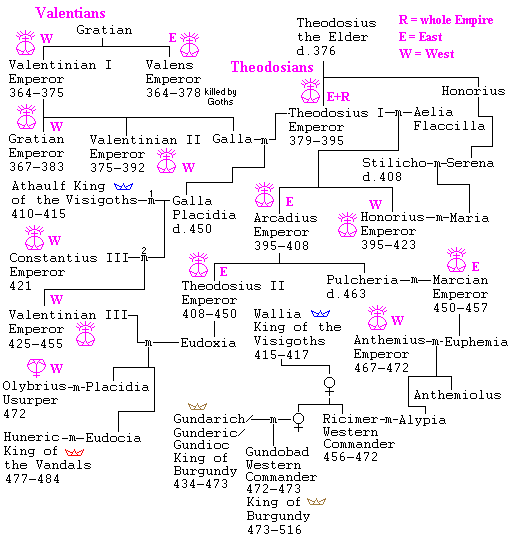
One of the most interesting people in the diagram is
the Empress Galla Placidia, the daughter of Theodosius I, the wife of
Constantius III, and the mother of Valentinian III. With Honorius and
Constantius she was buried in the chapel of Saints Nazarius and Celsus in
Ravenna. J.B. Bury (History of the Later Roman Empire Vol. 1, Dover 1958,
p. 263) says that "her embalmed body in Imperial robes seated on a chair of
cypress wood could be seen through a hole in the back till A.D. 1577, when all the contents of the tomb were accidentally
burned thourgh the carelessness of children." Mosaics in Ravenna from this
period already show the books of the Bible bound in codices, i.e.
familiar bound books rather than scrolls.
| 1. THEODOSIANS, WEST |
WESTERN COMMANDERS |
1. THEODOSIANS, EAST | |||
|---|---|---|---|---|---|
| 394-395, West |
Fl. Theodosius |
379-395, East | |||
| Council II, Constantinople I, Arianism condemned, 381; Destruction of the Serapeum, 391; Abolition of the Olympic Games, 394 (?) | |||||
| Honorius Fl. Honorius |
395-423 W | Stilicho | 395-408 | Arcadius Fl. Arcadius |
395-408 E |
| Suevi, Vandals, & Alans cross Rhine, 1 January 407 | |||||
| Constantius III Fl. Constantius |
410-421 | Theodosius II Fl. Theodosius |
408-450 E | ||
| 421 W | |||||
| Gladiatorial combat ended in Colosseum, 404; Rome sacked by Visigoths, 410; Gaul recovered from Constantine "III," 411; Visigoths destroy Alans and Siling Vandals in Spain, 416 | |||||
| [Constantine "III"] |
407-411 in Britain, Gaul & Spain |
Castinus | 422-425 | ||
| John Johannes |
423-425 W | defeated by Vandals in Spain, 422 | |||
| Valentinian III Fl. Placius Valentinianus |
425-455 W | Felix | 425-430 | ||
| Aëtius Fl. Aëtius |
430-454 | ||||
| Vandals invade
Africa, 428; Council III, Ephesus, Nestorianism condemned, 431; Vandals
repulsed from Carthage, 435; Vandals take Carthage, 439; expedition against Vandals cancelled, 441 | |||||
| Attila the Hun halted at Châlons, 451; Rome sacked by Vandals, 455 |
Marcian | 450-457 E | |||
| Council IV, Chalcedon, Monophysitism condemned, 451 | |||||
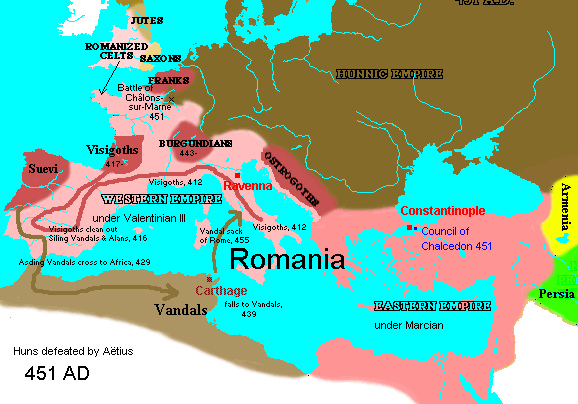
On the map, the Visigoths have actually become allies of the Romans. In
return for cleaning (most of) the Germans out of Spain, they are legally settled
in Aquitaine. Two German tribes, however, are left unmolested. The Suevi establish
themselves, for centuries, in Galicia, and the Asding Vandals cross over into
Africa. Of all the blows the Roman power, the latter would prove to be one of
the worst. Rome could no longer draw grain from North Africa. Much worse, the
crafty Vandal King
Gaiseric ("King Caesar") built a fleet after securing Carthage in 439. He then
did what the Carthaginians so many
centuries earlier had not been able to do: secure control of the seas. In
455 they did what Hannibal could only have dreamed of, arriving at Rome by sea,
breaking into and looting the city, and carrying the booty back to Carthage.
Meanwhile, around the same year, Hengest the Jute, followed by Angles and Saxons, founded the
Kingdom of Kent.
It is noteworthy that the Venerable Bede (673-735) numbered Theodosius II as the 45th and Marcian as the 46th Emperors since Augustus. This is considerably less than the count we might make now and it interestingly implies that Bede possessed a sort of "official" list from which many ephemeral Emperors were excluded [note]. After Roman Britain disappeared from history, when the usurper Constantine "III" took his troops to Gaul, Bede's History of the English Church and People is just about the first that we then hear of it, three hundred years later. What events filled that time became strongly mythologized, especially around the figure of King Arthur. Bede does not mention Arthur, but he does talk about a British leader against the Angles, Ambrosius Aurelius, who gained a period of peace after defeating the invaders at Badon Hill in about 493 (or 518). This becomes an element of the Arthur story. I suspect that the vividness of the Arthur stories, like that of the Greek epics and of the Mahâbhârata in India, is an artifact of a literate society that for a time lost its literacy but remembered, after a fashion, what it was like. The literature on the problem of Arthur and Britain in this period is vast. Two of the more interesting recent books might be The Discovery of King Arthur by Geoffrey Ashe [Guild Publishing, London, 1985] and From Scythia to Camelot, A Radical Reassessment of the Legends of King Arthur, the Knights of the Round Table, and the Holy Grail by C. Scott Littleton and Linda A. Malcor [Garland Publshing, Inc, New York, 1994]. Littleton and Malcor made the significant discovery that the scene of Arthur's death in Mallory's Morte d'Arthur, where the sword Excalibur was thrown into a lake, occurs in almost identical terms in the legends of the Ossetians in the Caucasus. There is a possible connection, since the Ossetians are descendants of the Alans, and Marcus Aurelius had settled a tribe of Alans, the Iazyges, whom he had defeated in 175 and taken into Roman service, in the north of Britain, where many of them settled at Bremetenacum Veteranorum, south of Lancaster. The legion to which the Iazyges were assigned, the VI Legion Victrix, was commanded by one Lucius Artorius Castus. "Artorius" looks like the Latin source of the name "Arthur." There is nothing certain about the speculations and disputes over all this, however, except that they will be endless [note].
| 2. LAST WESTERN EMPERORS [names in brackets not recognized by East] |
WESTERN COMMANDERS | ||
|---|---|---|---|
| [Petronius Maximus] | 455 W | ||
| Avitus Eparchius Avitus |
455-456 W | Ricimer | 456-472 |
| Majorian Julius Valerius Maiorianus |
457-461 W | ||
| expedition against Vandals fails, 461 | |||
| [Libius Severus] | 461-465 W | ||
| interregnum | 465-467 W | ||
| Anthemius Procopius Anthemius |
467-472 W | ||
| Joint E/W expedition against Vandals fails, 468 | |||
| [Olybrius Anicius Olybrius] |
472 W | ||
| interregnum | 472-473 W | Gundobad, King of Burgundy |
472-474 |
| [Glycerius] | 473-474 W | ||
| Julius Nepos | 474-480 W | Ecdicius | 474-475 |
| son of Avitus | |||
| deposed in Ravenna, retreats to Dalmatia, 475 |
Orestes | 475-476 | |
| [Romulus "Augustulus"] | |||
| 475-476 W | |||
|
|
476-493 | ||
| deposes Orestes & Augustulus, 476; Nepos
killed, 480; defeated, besieged, & killed by Theodoric, 489-493 | |||
In 2007, we have a movie, The Last Legion, that is about Romulus
Augustulus, Odoacer, et al. This is an extensively fictionalized and even
silly version of events, where Romulus Augustulus flees to Britain and becomes,
well, King Arthur -- with Ben Kingsley as some sort of Merlin. Since the project
is clearly a fantasy, it does not merit much notice, except for the points that
would give people the wrong idea about the era. The worst part of the story may
be that it has it that Odoacer was a Goth attacking Rome. Odoacer was not a
Goth, but from a lesser German tribe, the Sciri, and he was not attacking Rome,
but simply a member of the (barbarized) Roman army. Odoacer in fact was
eventually deposed (from Ravenna, of course) by Goths, the Ostrogoths
under Theodoric. The distortion is certainly made to preserve the image of Rome
(the City) being conquered by barbarian hordes. At the same time, we get the
notion that Romulus Augustulus is somehow the descendant or heir of Julius
Caesar. There is no evidence of this, Caesar himself had no descendants, and the
other heirs were pretty much wiped out by 69 AD. The Eastern Empire does come in
for mention in the movie, but only so that it can absurdly contribute a female
warrior, played by an actress from India, to the defense of Rome. Hollywood (or,
in this case, the Euro Italian-French-British co-producers) should save this
stuff for the coming remake of Conan the Barbarian.
Little is known about the Roman pocket in the north of Gaul. We hear about
Aegidius, the magister militum per Gallias, apparently appointed
by Majorian. This is noteworthy, since the commander of Roman forces in Gaul
hitherto had been only the magister equitum, Master of Horses instead of
Soldiers. Bury speculates that Aegidius held both titles [J.B. Bury, History
of the Later Roman Empire, Volume I, Dover Publications, 1958, p.333].
Aegidius did not accept the fall of Majorian or recognize Libius Severus, but he
was preoccupied fighting the Visigoths until his death in 464. He was followed
by someone we only know as the Count (comes) Paul. "Count"
("companion" of the Emperor) is actually a high title, but Bury supposes he must
have also held the "Master" titles also. If Paul styled himself "Count,"
however, this may have just been one step short of claiming the Purple. Ricimer
appointed his own magister militum for Gaul, Gundioc, the King of Burgundy (434-473).
Both Aegidius and Paul had the help of the Franks, who remained loyal
Roman allies, against the Visigoths and Burgundians. That changed when a new
Frankish King, Clovis (Chlodwig), succeeded his father in 481. Meanwhile, Paul
had been followed by the son of Aegidius, Syagrius. The Franks actually
called him rex Romanorum, a good indication that his realm and authority
were seen as quite independent -- indeed, there was no longer a Western Emperor
at that point. It is not known what Syagrius called himself. Clovis defeated him
at Soissons in 486. Syagrius fled to the Visigoths, who returned him for
execution by Clovis. This was the end of Roman Gaul, 541 years after Caesar had completed its
conquest in 56 BC -- or perhaps 531 years since the defeat, capture, and death
of the rebel Vercingetorix in 46 BC. Now the dominance of the Franks would
begin, and in time Gaul would take their name.
C. THE EAST ALONE, 476-518, 42 Years
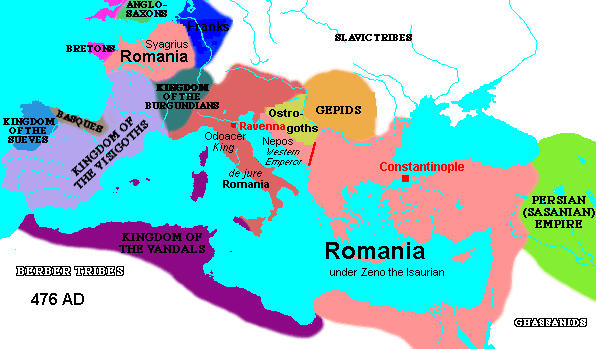
| 1. LEONINES | |
|---|---|
| Leo I | 457-474 E |
| Joint E/W expedition against Vandals fails, 468 | |
| Leo II | 473-474 E |
| Zeno the Isaurian (Tarasikodissa) |
474-491 E+W |
| [Basiliscus] | 475-476 E |
| Anastasius I | 491-518 |
| reforms coinage, 498 | |
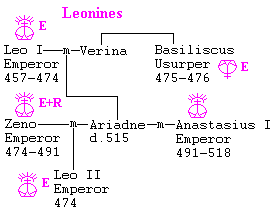 had rendered the Western Army useless. A last chance to recoup
things for the whole Empire came in 468, after Leo had gotten Ricimer to accept
the Theodosian relative Anthemius as Western Emperor. A joint amphibious
campaign was put together to recover Africa from the Vandals. This should have
succeeded, but it failed through a combination of incompetence, treachery, and
bad luck. Ricimer may not have really wanted it to succeed, and it wasn't long
before he got rid of Anthemius. After Odoacer decided not to bother with a
Western Emperor, Leo's Isaurian son-in-law, Zeno, found himself as the first
Emperor of a "united" Empire since Theodosius I, but little was left of the
West. Only Odoacer in Italy vaguely acknowledged the Emperor's suzerainty -- we
don't know what allegiance to Constantinople, if any, remained in the Roman
pocket in northern Gaul. Nothing was done about this at the time, and
Anastasius, by temperament or by wisdom, concentrated on allowing the East to
rest and build up its strength. Part of that involved reforming the coinage, which is one of the
benchmarks for the beginning of "Byzantine" history.
had rendered the Western Army useless. A last chance to recoup
things for the whole Empire came in 468, after Leo had gotten Ricimer to accept
the Theodosian relative Anthemius as Western Emperor. A joint amphibious
campaign was put together to recover Africa from the Vandals. This should have
succeeded, but it failed through a combination of incompetence, treachery, and
bad luck. Ricimer may not have really wanted it to succeed, and it wasn't long
before he got rid of Anthemius. After Odoacer decided not to bother with a
Western Emperor, Leo's Isaurian son-in-law, Zeno, found himself as the first
Emperor of a "united" Empire since Theodosius I, but little was left of the
West. Only Odoacer in Italy vaguely acknowledged the Emperor's suzerainty -- we
don't know what allegiance to Constantinople, if any, remained in the Roman
pocket in northern Gaul. Nothing was done about this at the time, and
Anastasius, by temperament or by wisdom, concentrated on allowing the East to
rest and build up its strength. Part of that involved reforming the coinage, which is one of the
benchmarks for the beginning of "Byzantine" history. 
On the map we see the classic form of the German successor Kingdoms of the Western Empire. By 493 Theodoric the Ostrogoth, invited by the Emperor Anastasius, had taken out Odoacer in Italy. This was just in time to save the Visigoths, who were defeated by the Franks in 507 and pushed out of Gaul. The result has the look of a nice balance of power, but there is no telling how long that might have lasted. What upset things was not any internal development, but a most unexpected revival and return of Roman power. In the beloved story of the "Fall" of Rome, this sequel is usually what gets overlooked.
Also noteworthy as a benchmark for the beginning of Byzantine history in the time of the Leonines is the apparent disappearance of the traditional Roman tria nomina, the three names of praenômen, nômen, and cognômen, which have been given with previous Emperors. The last Emperor with three full names may have been Majorian, Julius Valerius Majorianus. In general, the Valentian and Theodosian Emperors only had two names, e.g. Valens, Fl. Valens, and Theodosius I & II, both Fl. Theodosius. From Marcian onward there is no evidence of any traditional Roman nomenclature. Why is this happening? Well, even though it had been some time since the nômen had lost its connection to the actual ancestral gens (the clan), and all the names were becoming like titles, the system of the tria nomina still bore an essential connection to the Roman family cult of ancestor worship. No Confucian venerated ancestors in a household shrine more devoutly than the pious Roman. But this could not survive with the adoption of Christianity. A Christian receives a single Christian name. Indeed, it is a while before we get names, like Michael or John, that look more Christian than Roman and Greek, like Jovian, Leo, or Heraclius (still commemorating Heracles -- and so Hera); but the trend is obvious. Indeed, the names beginning with the Valentians look like the perfunctory addition of "Flavius" to the single basic name of the Emperors -- even of Aëtius, "Flavius Aëtius." Eventually we get the return of surnames, at first for nobility. The first Dynasty with a family name will be the Ducases in the 11th century. It took a few more centuries before surnames became common among European Christians of all classes.
Another momentous transition is in architecture. The lovely temples of Classical antiquity, like jewels in the landscape, disappear. Christian churches of the period often look like piles of bowls or dark fruitcakes. Or we simply get the basilica, a Roman courthouse. Churches often are not even visible from a distance, because they may be packed around with other buildings. Why is this happening? Were Christians just anaesthetic? No. The aesthetic was certainly changing, but the most important difference was just the difference in purpose between a temple and a church. A temple was the house of a god, with little space inside but for the god and a few priests. It was not supposed to contain a body of worshipers. The public side of the temple was the exterior, the visible sign of the god's presence. With a church, however, the purpose was not to house God, whose presence was ineffable, but to house the congregation, the ekklêsía, the "assembly" that gave its name in many modern languages for "church" (which itself seems to be from kyriakos, "of the Lord"). The public side of a church is thus the interior, not the exterior, and the outwardly ugliest early churches often contain marvelous inner spaces, with rich decoration. These quickly become awesome spaces, as in Sancta Sophia, for centuries the greatest church of Christendom. Roman domes could do what most Roman temples did not try to do. As it happens there was a precedent for this. Hadrian's Pantheon in Rome is undistinguished and unremarkable from the outside yet contains a wonderful interior under the largest dome of pre-modern engineering. The dome of Sancta Sophia is smaller but used more dramatically. The Pantheon is essentially one large, really nice room. Sancta Sophia holds a vast space -- the 184 foot rise of the dome on its piers can easily contain the 151 foot Statue of Liberty.
Eventually, a form of church evolved that transformed the basilica into a building with a monumental external face and a monumental internal space. These would be the Romanesque and Gothic cathedrals, but it would be centuries before the technology could handle the spidery supports, of walls pierced with windows and held by buttresses, that both size and relatively lightness required. Then the basilica and the dome would be combined, to produce in the Renaissance the new largest church in Christendom, St. Peter's in Rome. But this would happen as culturally Francia surpassed Romania. The instructive comparison is with the practice in Islâm, where the purpose of a mosque was similar to that of a church. This can be seen in the Omayyad Mosque in Damascus, based on Syrian churches, which is all but invisible from the outside, hidden in the midst of the city, but contains two marvelous spaces, a courtyard and the lovely interior of the prayer hall, with mosaics as in churches of the time. On the other hand, a monument of the same era, the Dome of the Rock in Jerusalem, stands conspicuously like a pagan temple, high on the Temple Mount itself. But the purpose of the Dome is more like a temple. It was built less for a congregation than for the Rock itself, commemorating the Temple of Solomon and the site of the Prophet Muh.ammad's "dream journey" to heaven. Finally, the Ottoman mosques of Sinan (c.1500-1588), based on the model of Sancta Sophia, produce the monumental Islâmic equivalent of the cathedral.
D. RETURNING TO THE WEST, 518-610, 92 years
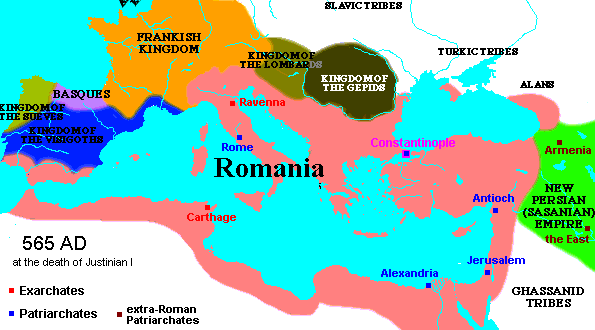
565
AD
| 1. JUSTINIANS | |
|---|---|
| Justin I | 518-527 |
| Justinian I | 527-565 |
| Plato's Academy closed,
529; North Africa regained, 533; Rome regained, 536; end of dating by Consuls, 537;  Plague, 541-545; Plague, 541-545;Ostrogoths defeated, 552; Council V, Constantinople II, Monophysitism condemned again, 553; Andalusia regained, 554 | |
| Justin II | 565-578 |
| Lombards Invade Italy, 568 | |
| Tiberius II | 574-578, Caesar; 578-582, Augustus |
| Sack of Athens by Slavs, 582 | |
| Maurice | 582-602 |
| non-dynastic | |
| Phocas | 602-610 |
The arrival of the  Plague in Egypt in October 541 was the beginning of an
epidemic that cost the Empire perhaps 200,000 citizens. The percentages of
people who died in Europe may compare with those of the Black Death in the 14th
century, though by then the population of Europe had grown much larger. But the
Plague was not the only problem. The climate was changing. After what is now
called the "Roman Warming," we get into the "Dark Ages Cooling." The tree ring
record of 540 in Ireland is that "the trees stopped growing." The historian
Procopius said that, "[t]he sun gave forth its light without brightness, like
the moon during the whole year and it seemed exceedingly like the sun in
eclipse, for the beams it shed were not clear, nor such as it is accustomed to
shed" [cf. S. Fred Singer & Dennis T. Avery, Unstoppable Global Warming, Every
1,500 Years, Rowman & Littlefield, 2007, p.101]. Other records give
similar accounts. The dimness of the sun may be from increased, thin cloud
cover, from changes in solar output, or other causes. Whichever, the weather
would be colder and the growing season shorter for some time. This would
adversely impact the population at a time when the lack would gravely affect the
fate of the Empire. Without the manpower to put down the Ostrogoths more swiftly
and effectively, Justinian would devastate Italy in a way that would not have
otherwise been necessary and that not been effected by the original "barbarian
invasions" as such.
Plague in Egypt in October 541 was the beginning of an
epidemic that cost the Empire perhaps 200,000 citizens. The percentages of
people who died in Europe may compare with those of the Black Death in the 14th
century, though by then the population of Europe had grown much larger. But the
Plague was not the only problem. The climate was changing. After what is now
called the "Roman Warming," we get into the "Dark Ages Cooling." The tree ring
record of 540 in Ireland is that "the trees stopped growing." The historian
Procopius said that, "[t]he sun gave forth its light without brightness, like
the moon during the whole year and it seemed exceedingly like the sun in
eclipse, for the beams it shed were not clear, nor such as it is accustomed to
shed" [cf. S. Fred Singer & Dennis T. Avery, Unstoppable Global Warming, Every
1,500 Years, Rowman & Littlefield, 2007, p.101]. Other records give
similar accounts. The dimness of the sun may be from increased, thin cloud
cover, from changes in solar output, or other causes. Whichever, the weather
would be colder and the growing season shorter for some time. This would
adversely impact the population at a time when the lack would gravely affect the
fate of the Empire. Without the manpower to put down the Ostrogoths more swiftly
and effectively, Justinian would devastate Italy in a way that would not have
otherwise been necessary and that not been effected by the original "barbarian
invasions" as such.
With the return of Roman power to the West, new arrangements of government emerge. Justinian abolished the dioceses, but now Italy and Africa are ruled under a new rubric, the "Exarchate" ("out-rule"). Ravenna, still the capital of Italy under the Ostrogoths, becomes a Roman capital again, not of a Western Empire, but just for the governor of Italy, the "Exarch." Justinian lavished classic artwork on the city which survives until today. Indeed, the most familiar portraits of Justinian and Theodora are from mosaics in the Church of San Vitale. The Exarchate continued until the fall of the city to the Lombards in 751. Nevertheless, the form of the Exarchate across central Italy, a corridor held between the Lombards in the north and those in the south, survived as the "Donation" of the Frankish King Pepin to the Pope -- the Papal States, whose history ran from 754 to 1870, 1116 years. Thus, although politically insignificant after 751, Ravenna nevertheless casts a kind of shadow deep into modern history. In Africa, the Exarchate was centered at Carthage, which enters its last phase as a player in Roman history. With less to show for its life in this period, the city fell to the Arabs in 698. By then, Carthage had had so much history, perhaps it just could not bear any more.
The office of the Roman Consuls, the chief executive officers of the Roman Republic, and dating by them,
continued under the Empire until Justinian, who replaced them with dating by
Regal years. They can be examined on a popup
page. As the end of an institution that began at the very beginning of the
Republic, it is hard exaggerate the symbolic importance of this event. The Roman
state is now a monarchy in nearly every detail.
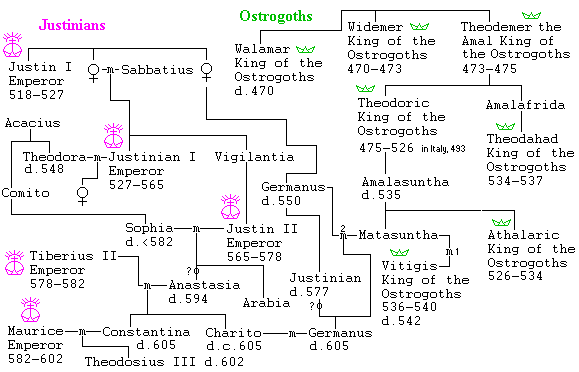
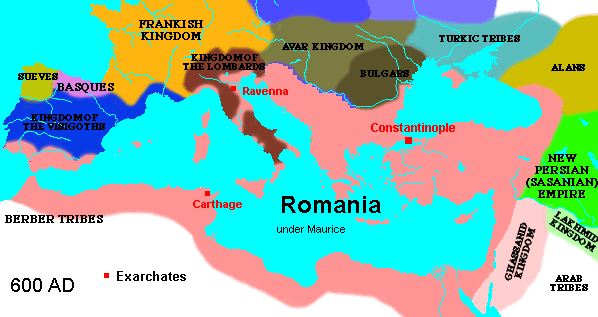
| 3. GHASSANIDS | |||
|---|---|---|---|
| Jafnah I ibn Amr | 220-265 | ||
| 'Amr I ibn Jafnah | 265-270 | ||
| Tha'labah ibn Amr | 270-287 | ||
| al-Harith I ibn Th'alabah | 287-307 | ||
| Jabalah I ibn al-Harith I | 307-317 | ||
| al-Harith II ibn Jabalah "ibn Maria" | 317-327 | ||
| al-Mundhir I Senior ibn al-Harith II | 327-330 | al-Aiham ibn al-Harith II | 327-330 |
| al-Mundhir II Junior ibn al-Harith II | 327-340 | al-Nu'man I ibn al-Harith II | 327-342 |
| Jabalah II ibn al-Harith II | 327-361 | 'Amr II ibn al-Harith II | 330-356 |
| Jafnah II ibn al-Mundhir I | 361-391 | ||
| al-Nu'man II ibn al-Mundhir I | 361-362 | ||
| al-Nu'man III ibn 'Amr ibn al-Mundhir I | 391-418 | ||
| Jabalah III ibn al-Nu'man | 418-434 | ||
| al-Nu'man IV ibn al-Aiham | 434-455 | al-Harith III ibn al-Aiham | 434-456 |
| al-Nu'man V ibn al-Harith | 434-453 | ||
| al-Mundhir II ibn al-Nu'man | 453-472 | ||
| 'Amr III ibn al-Nu'man | 453-486 | Hijr ibn al-Nu'man | 453-465 |
| al-Harith IV ibn Hijr | 486-512 | ||
| Jabalah IV ibn al-Harith | 512-529 | ||
| al-Harith V ibn Jabalah | 529-569 | ||
| al-Mundhir III ibn al-Harith | 569-581 | Abu Kirab al-Nu'man ibn al-Harith | 570-582 |
| al-Nu'man VI ibn al-Mundhir | 582-583 | ||
| al-Harith VI ibn al-Harith | 583 | al-Nu'man VII ibn al-Harith Abu Kirab | 583-? |
| direct Roman rule, 584-before 614 | |||
| al-Aiham ibn Jabalah | ?-614 | ||
| al-Mundhir IV ibn Jabalah | 614-? | ||
| Sharahil ibn Jabalah | ?-618 | ||
| Amr IV ibn Jabalah | 618-628 | ||
| Jabalah V ibn al-Harith | 628-632 | ||
| Jabalah VI ibn al-Aiham | 632-638 | ||
| Arab Conquest, 638 | |||
The Ghassanids were an Arab tribe occupying the hinterland behind Syria
and Jordan. This was the area that had previously seen rule by the Nabataeans and then by Palmyra. Evidently it
was difficult for the Romans to maintain direct rule over an area whose
inhabitants might largely be pastoral and nomadic. Indirect rule ended up
accomplished by an alliance with the Ghassanids.
In the time of Justinian the Ghassanids became organized enough to be called a "kingdom" by historians, and they become an important part of Roman frontier defense. They might also be said to represent the first entry of the Arabs into Mediterranian history. If they constitute a pre-Islamic move north of Arab people, then both the Romans and the Persians converted the threat of nomadic encroachment into elements of the pre-existing balance of power between Romania and Persia. For the Persians, indeed, had their own client Arab tribe, the Lakhmids, who occupied the hinterland west of the Euphrates. The rivalry between Ghassanids and Lakhmids was not just as proxies for the Powers, but, as can be imagined, the two tribes had become rivals anyway, and there was also a religious dimension. The Ghassanids were Christians, and the Lakhmids had remained pagan.
While the religion of the Ghassanids in general would be expected to be a
unifying factor with respect to Rome, there developed a difficulty. The
Ghassanids became Monophysites. This was not something that Justinian would let
stand in the way of sensible policy, but later Emperors began a harassment like
that inflicted on the Copts and the Syrian Orthodox. Since the
Ghassanids were rather like the keystone in the defensive arch based on Egypt
and Syria, the disaffection of these populations seriously weakened the Roman
frontier. This was already evident during the Persian invasion of 607-616, and
nothing had been done to heal it by the time of the  Arab invasion of 636. Soon the Ghassanids converted to Islam and
disappeared from history.
Arab invasion of 636. Soon the Ghassanids converted to Islam and
disappeared from history.
The list here is entirely from Bruce R. Gordon's Regnal
Chronologies. Despite the treatment of the Ghassanids in many Byzantine
histories, which often give rulers of related states, I have not seen a list in
any history. Since the names of the Ghassanids include the familiar Arabic
patronynmic element, ibn, the genealogy of the dynasty could actually be
constructed without too much difficulty. It will also be noted that brothers
often rule simultaneously, as with the several sons of al-Harith II who begin
ruling in 327. Al-Harith II himself, with the epithet "ibn Maria" and living in
the time of Constantine, may well be the tribal chief who converted to
Christianity.
 III. THIRD EMPIRE, MIDDLE "ROMANIA," EARLY "BYZANTIUM," 610 AD-1059
AD, Era of Diocletian 327-776, 449 years
III. THIRD EMPIRE, MIDDLE "ROMANIA," EARLY "BYZANTIUM," 610 AD-1059
AD, Era of Diocletian 327-776, 449 years
Once out of nature I shall never take
My bodily form from any natural thing,
But such a form as Grecian goldsmiths make
Of hammered gold and gold enamelling
To keep a drowsy Emperor awake;
Or set upon a golden bough to sing
To lords and ladies of Byzantium
Of what is past, or passing, or to come.
William Butler Yeats (1865-1939), "Sailing to Byzantium," alluding to the mechanical birds reported at the Macedonian court.
To most people thinking of the "Roman Empire," we are well into terra incognita here. Yet in 610 the character and problems of the Roman Empire would not have been unfamiliar to Theodosius the Great. A Persian invasion was nothing new. How far it got, all the way to Egypt and the Bosporus, was. Meanwhile, the collapse of the Danube frontier was not now the doing of Germans but of Slavs and Steppe people -- the latter beginning with the Altaic Avars, whose kin would dominate Central Asia in the Middle Ages. The Persians were miraculously defeated; but before the Danube could be regained or the Lombards overcome in Italy, a Bolt from the Blue changed everything. The Arabs, bringing a new religion, Islâm, created an entirely new world, which both broke the momentum of Roman recovery and divided the Mediterranean world in a way whose outlines persist until today. Nevertheless, the Empire, restricted to Greece and Anatolia, rode out the flood. It must have been a hard nut, since the Arab Empire otherwise flowed easily all the way to China and the Atlantic. It was hard enough, indeed, that by the end of the "Third Empire" it had been in better health than any Islamic state. The promise of new ascendency, however, was brief, both for internal and external reasons.
A. THE ADVENT OF ISLAM, 610-802, 192 years
| 1. HERACLIANS | |
|---|---|
| Heraclius | 610-641 |
| invasion and conquest of Syria, Egypt, & Anatolia by Shâh Khusro II, 607-616; his defeat, 623-628; Salona destroyed by Avars, residents move to Spalatum, 620; Cartagena falls to Visigoths, 624; Avar Siege of Constantinople, 626; occupation of Armenia, 633; Palestine lost to the Caliph 'Umar, 636; Syria lost, 640; Egypt invaded, 640 | |
| Constantine III & Heracleon |
641 |
| Constans II Pogonatus | 641-668, last Emperor to visit Rome as a possession |
| Egypt lost, 642; Genoa (Liguria) lost to Lombards, 642; campaign against the Lombards, 663 | |
| Constantine IV | 668-685 |
| Siege of Constantinople by the Caliph Mu'âwiya, 674-677; Council VI, Constantinople III, Monotheletism condemned, 680-681 | |
| Justinian II Rhinotmetus | 685-695, 705-711 |
| Loss of Armenia, 693 | |
| non-dynastic | |
| Leontius | 695-698 |
| Carthage falls, 698 | |
| Tiberius III | 698-705 |
| Philippicus Bardanes (Vardan) |
711-713 |
| Anastasius II | 713-715 |
| Theodosius III | 715-717 |
 Heraclius began to use the title of the defeated monarch, the
traditional Persian "Great King." Thus Basileus, the Greek word for
"King," became the mediaeval Greek word for "Emperor" -- as Greek now (or
hereabouts) replaces Latin as the Court language. But then, barely eight years
after this exhausting victory, the Arabs, united by Islâm, appeared out of the
desert and quickly conquered Syria, Palestine, and Mesopotamia. Jerusalem would
never be recovered, except temporarily by the Crusaders. Old and
ill, Heraclius had to watch his life's work largely melt away, while people said
it was the Judgment of God because he had married his niece. But a core for the
Empire had been saved.
Heraclius began to use the title of the defeated monarch, the
traditional Persian "Great King." Thus Basileus, the Greek word for
"King," became the mediaeval Greek word for "Emperor" -- as Greek now (or
hereabouts) replaces Latin as the Court language. But then, barely eight years
after this exhausting victory, the Arabs, united by Islâm, appeared out of the
desert and quickly conquered Syria, Palestine, and Mesopotamia. Jerusalem would
never be recovered, except temporarily by the Crusaders. Old and
ill, Heraclius had to watch his life's work largely melt away, while people said
it was the Judgment of God because he had married his niece. But a core for the
Empire had been saved. 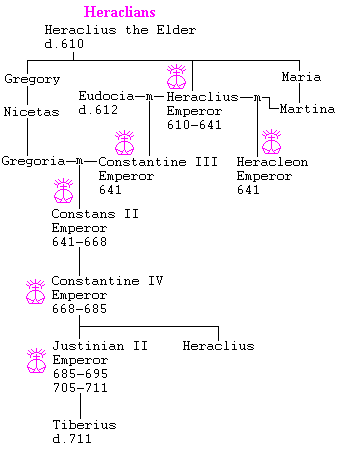
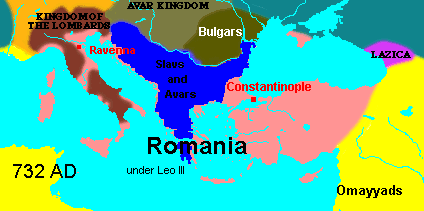 The maps of Romania now become much smaller. Egypt, Palestine,
Spain, and North Africa are gone forever. Footholds in Italy and the Balkans
remain. Greece and the Balkans would be recovered in time, but everything in
Italy would eventually be lost also. For the time being, the heartland of the
Empire will be Asia Minor. Although this would provide the resources for
revival, even for colonization back into Greece, it was still open to Arab
raids. They could not be precluded for a couple of centuries.
The maps of Romania now become much smaller. Egypt, Palestine,
Spain, and North Africa are gone forever. Footholds in Italy and the Balkans
remain. Greece and the Balkans would be recovered in time, but everything in
Italy would eventually be lost also. For the time being, the heartland of the
Empire will be Asia Minor. Although this would provide the resources for
revival, even for colonization back into Greece, it was still open to Arab
raids. They could not be precluded for a couple of centuries.
| 3. SYRIANS (ISAURIANS) | |
|---|---|
| Leo III | 717-741 |
| Siege of Constantinople by the Caliphs Sulaymân & 'Umar II, 717-718 Tax Revolt in Italy, end of Imperial authority in Exarchate, Exarch Paulicius assassinated, 727; Edict establishing Iconoclasm, 730 | |
| Constantine V Copronymus |
741-775 |
| Ravenna Falls to Lombards, 751; Iconoclast Council, 754 | |
| Leo IV the Khazar | 775-780 |
| Constantine VI | 780-797 |
| Irene | 780-790, Regent |
| 792-802 | |
| Council VII, Nicaea II, Iconoclasm condemned, 787; Black Sea freezes, winter of 800-801 | |
The prohibition of religious images began the Iconoclasm controversy.
One way to understand it is to realize that the conflict between Islâm and
Christendom was not just a contest of arms but, mutatis mutandis, an
ideological struggle. Christians were not being accused, to be sure, of
oppressing the workers, but they were being accused of being polytheists
(because of the Trinity) and idolaters (for making and venerating images).
Indeed, some Islâmic attitudes are familiar from later religious ideological
conflict, since disgust and condemnation of a priesthood and celibacy, not to
mention the use of images, could later draw sympathy from Protestantism. The
Thousand and One Nights derives great humor from the notion that the
incense burned by Christians (but not, of course, by later Protestants) was made
from the dung of bishops. 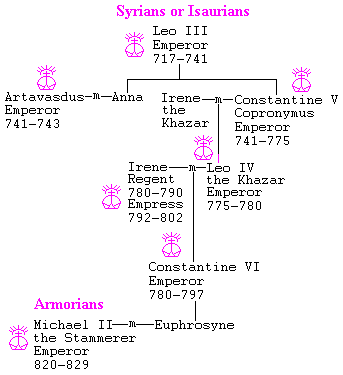
Since Leo III is considered to have come
from either Syria or the nearby Isauria, his concern about this issue is
supposed to have resulted from his sensitivity to the effect of Islâmic charges
on the previously Christian populations of the areas, like Syria, conquered by
Islâm. Conversions did not have to be effected by force, which was prohibited by
the Qur'ân anyway, but by powerful persuasion (and, easily understood in
modern terms, tax incentives). So Leo, a sort of proto-Protestant, decided to
clean up Christianity's act. This did not find any traction in the West,
however. The Latin Church felt no sting from Islâmic ideology. Leo's successes
against the Arabs, obvious evidence of the favor of God, became associated with
Iconoclasm. After images were restored by Irene, and military reverses seemed to
follow, the favor of God was apparently withdrawn. The final Iconoclast period (815-843) was of such
mixed military fortunes that worries about the favor of God faded, as Papal
support for images had never faltered.
The final fall of Ravenna to the Lombards in 751 led to the intervention of
the Franks in Italy,
at the urging of the Pope. Romania would never return to Central or Northern
Italy. This was on the watch of Constantine V, who came to be called
"Copronymus," "Name of Dung" -- certainly one the harshest, crudest epithets in
the history of royalty. As Frankish power waxed, the Pope took the step of
crowning the Frankish King Charles as Emperor in 800. This was during the reign
of Irene, who had taken the throne exclusively for herself, the only Empress
ever to do so, by having her son Constantine VI blinded (he died, too). Although
Irene restored the images and reconciled the Eastern and Western Churches, the
Pope decided to arrogate the authority of crowning a proper, male Emperor to
himself (later justified with the fraudulent "Donation of Constantine" document,
by which Constantine I had supposedly given the entire Western Empire to the
Pope). While Charlemagne even offered to marry Irene, who could have regarded
him as only the rudest of barbarians, this all signaled a fundamental parting of
the ways between the Latin Europe of Pope and Franks (Francia) and the Greek
Europe of Romania. Note the parallels between the reign of Irene and that of the
slightly earlier Empress Wu (685-705) of T'ang Dynasty China.
Because she did restore the Icons, Irene was later venerated as far away as the
St. Catherine's Monastery at Mount Sinai -- although by then Sinai had been lost
to Romania for almost two hundred years. She does not seem to have gotten as
much credit closer to home, perhaps because Iconoclasm returned for a while.
| 4. DOGES (DUKES) OF VENICE, 727-1797 | |
|---|---|
| Orso (Ursus) Ipato |
727-738 |
| Teodato (Deusdedit) Ipato |
742, 744-736 |
| Galla Gaulo | 756 |
| Domenico Monegaurio | 756-765 |
| Maurizio I Galbaio | 765-787 |
| Giovanni and Maurizio II Galbaio |
787-802 |
| Obelerio Antenorio | 802-811 |
| Venetia & Dalmatia submit to Franks, 806; Roman fleet reestablishes authority, 807 | |
| Beato | 808-811 |
| Angello Partecipazio | 811-827 |
| Giustiniano Partecipazio | 827-829 |
| Giovanni (I) Partecipazio | 829-836 |
| Pietro Tradonico | 836-864 |
| Orso I Badoer (I Partecipazio) |
864-881 |
| Giovanni Badoer (II Partecipazio) |
881-888 |
| Venice effectively independent, 886 | |
| Pietro I Candiano | 887 |
| Pietro Tribuno | 888-912 |
| Orso II Badoer (II Partecipazio) |
912-932 |
| Pietro II Candiano | 932-939 |
| Pietro Badoer (Partecipazio) |
939-942 |
| Pietro III Candiano | 942-959 |
| Pietro IV Candiano | 959-976 |
| Pietro I Orseolo | 976-978 |
| Vitale Candiano | 978-979 |
| Tribuno Menio (Memmo) |
979-991 |
| Pietro II Orseolo | 991-1008 |
| Ottone Orseolo | 1008-1026, 1030-1032 |
| Pietro Centranico (Barbolano) |
1026-1030 |
| Domenico Flabianico | 1032-1043 |
| Domenico Contarini | 1043-1070 |
| Domenico Silvio (Selvo) | 1070-1084 |
| Trade concession with Romania, 1082; construction of St. Mark's begun | |
| Vitale Falier | 1084-1096 |
| relics of St. Mark deposited in completed St. Mark's cathedral, 1094 | |
| Vitale I Michiel (Michel) | 1096-1101 |
| Ordelafo Falier | 1101-1118 |
| Domenico Michiel | 1118-1129 |
| Pietro Polani | 1129-1148 |
| Domenico Morosini | 1148-1155 |
| Vitale II Michiel | 1155-1172 |
| all Venetians arrested in Romania, 1171 | |
| Sebastiano Ziani | 1172-1178 |
| Orio Mastropiero (Malipiero) |
1178-1192 |
| Enrico Dandolo | 1192-1205 |
| Fourth Crusade, 1202-1204; Constantinople falls to Crusaders & Venetians, 1204; Venice ceded 3/8 of Romania | |
| Pietro Ziani | 1205-1229 |
| Giacomo Tiepolo | 1229-1249 |
| Marino Morosini | 1249-1253 |
| Reniero Zeno | 1253-1268 |
| Restoration of Greek rule in Constantinople, 1261 | |
| Lorenzo Tiepolo | 1268-1275 |
| Jacopo Contarini | 1275-1280 |
| Giovanni Dandolo | 1280-1289 |
| Venetians mint Ducats after Roman debasement, 1284 | |
| Pietro Gradenigo | 1289-1311 |
| Venetian fleet destroyed by Genoa at Curzola, Marco Polo captured, 1298 | |
| Marino Zorzi | 1311-1312 |
| Giovanni Soranzo | 1312-1328 |
| Francesco Dandolo | 1328-1339 |
| Bartolomeo Gradenigo | 1339-1342 |
| Andrea Dandolo | 1343-1354 |
Crown Jewels of Romania pawned,  1343; Black Death arrives at Venice, 1347; War
with Genoa, 1350-1355 1343; Black Death arrives at Venice, 1347; War
with Genoa, 1350-1355 | |
| Marino Falier | 1354-1355 |
| Giovanni Gradenigo | 1355-1356 |
| Giovanni Dolfin | 1356-1361 |
| Lorenzo Celsi | 1361-1365 |
| Marco Corner | 1365-1368 |
| Corfu acquired, 1368 | |
| Andrea Contarini | 1368-1382 |
| Michele Morosini | 1382 |
| Antonio Venier | 1382-1400 |
| Michele Steno | 1400-1413 |
| Tommaso Mocenigo | 1414-1423 |
| Francesco Foscari | 1423-1457 |
| Thessalonica ceded by Romania, 1423, captured by Turks, 1430; Patriarch of Grado becomes Patriarch of Venice, 1451; Constantinople falls to Turks, Venetian baillie executed, others executed, enslaved, ransomed, 1453 | |
| Pasquale Malipiero | 1457-1462 |
| Cristoforo Moro | 1462-1471 |
| Euboia (Negroponte) falls to Turks, 1470 | |
| Nicolò Tron | 1471-1473 |
| Nicolò Marcello | 1473-1474 |
| Pietro Mocenigo | 1474-1476 |
| Andrea Vendramin | 1476-1478 |
| Giovanni Mocenigo | 1478-1485 |
| Marco Barbarigo | 1485-1486 |
| Agostino Barbarigo | 1486-1501 |
| Cyprus passes to Venice, 1489; Modon & Coron in Morea fall to Turks, 1500 | |
| Leonardo Loredan | 1501-1521 |
| Antonio Grimani | 1521-1523 |
| Andrea Gritti | 1523-1538 |
| Pietro Lando | 1539-1545 |
| Monembasia falls to Turks, 1540 | |
| Francesco Donato | 1545-1553 |
| Marcantonio Trevisan | 1553-1554 |
| Francesco Venier | 1554-1556 |
| Lorenzo Priuli | 1556-1559 |
| Girolamo Priuli | 1559-1567 |
| Pietro Loredan | 1567-1570 |
| Alvise I Mocenigo | 1570-1577 |
| Turkish Conquest of Cyprus, 1571; Battle of Lepanto, naval defeat of Turkey by Spain, Venice, & Malta, 1571 | |
| Sebastiano Venier | 1577-1578 |
| Nicolò da Ponte | 1578-1585 |
| Pasquale Cicogna | 1585-1595 |
| Marino Grimani | 1595-1605 |
| Leonardo Donato | 1606-1612 |
| Marcantonio Memmo | 1612-1615 |
| Giovanni Bembo | 1615-1618 |
| Nicolò Donato | 1618 |
| Antonio Priuli | 1618-1623 |
| Francesco Contarini | 1623-1624 |
| Giovanni Corner | 1625-1629 |
| Nicolò Contarini | 1630-1631 |
| Francesco Erizzo | 1631-1646 |
| Francesco Molin | 1646-1655 |
| Carlo Contarini | 1655-1656 |
| Francesco Corner | 1656 |
| Bertucci (Albertuccio) Valier |
1656-1658 |
| Giovanni Pesaro | 1658-1659 |
| Domenico Contarini | 1659-1675 |
| Conquest of Crete by Turkey, 1669 | |
| Nicolò Sagredo | 1675-1676 |
| Luigi Contarini | 1676-1684 |
| Marcantonio Giustinian | 1684-1688 |
| Parthenon destroyed in explosion under Venetian bombardment, 1687 | |
| Francesco Morosini | 1688-1694 |
| Silvestro Valier | 1694-1700 |
| Alvise II Mocenigo | 1700-1709 |
| Giovanni II Corner | 1709-1722 |
| Alvise III Mocenigo | 1722-1732 |
| Carlo Ruzzini | 1732-1735 |
| Alvise Pisani | 1735-1741 |
| Pietro Grimani | 1741-1752 |
| Francesco Loredan | 1752-1762 |
| Marco Foscarini | 1762-1763 |
| Alvise IV Mocenigo | 1763-1778 |
| Paolo Renier | 1779-1789 |
| Lodovico Manin | 1789-1797, d. 1802 |
| Venice Falls to Napoleon Bonaparte, 1797 | |

Venice was the "Most Serene Republic," or the "Queen of
the Adriatic." The title of Doge derives from that of a late Roman
commander of a military frontier, Dux ("leader").  This is cognate to English "Duke." The Doges were always
elected, from a variety of families, as their names indicate. Over time their
powers were increasingly limited, as Venice evolved into an oligarchic Republic.
The Duke of Venetia at first would have been like many other Romanian officials
in Italy, but Constantinople rarely had occasion or ability to exert direct rule
over Venice, so over time the city drifted into independence, competition, and
eventually belligerence.
This is cognate to English "Duke." The Doges were always
elected, from a variety of families, as their names indicate. Over time their
powers were increasingly limited, as Venice evolved into an oligarchic Republic.
The Duke of Venetia at first would have been like many other Romanian officials
in Italy, but Constantinople rarely had occasion or ability to exert direct rule
over Venice, so over time the city drifted into independence, competition, and
eventually belligerence.
The list of Doges is taken from Byzantium and Venice, A Study in Diplomatic and Cultural Relations, by Donald M. Nicol [Cambridge University Press, 1988, 1999], and Storia di Venezia Volume II, by Eugenio Musatti [4th edition, Fratelli Treves Editori, Milano, 1937]. A complete list can also be found in A History of Venice, by John Julius Norwich [Vintage Books, 1989].
After the Schism of the Eastern and Western Churches (1054), there came to be growing religious hostility between Venice and her metropolis. However, Venice never quite fit in to the political system of Francia. For a while the Republic paid tribute to the Carolingians but quickly enough shook off any obligation. Playing Constantinople and the West against each other, Venice never really acknowledged the authority of the Frankish or German Emperors and in time was relatively safe in its lagoon from attempts to impose imperial authority, whether from East or West. With the decline of Romania, Venice largely pursued its affairs at the expense of Constantinople and only came to be pushed out of the area altogether by the Ottomans.
When Alexius Comnenus signed a pact with Venice in 1082, the Republic became a partner with the now beleaguered Constantinople. During the honeymoon period we get the completion of St. Mark's Cathedral -- a mature Romania seeding its culture into the maturing Venice.
The honeymoon didn't last. The pact gave Venice a choke hold on the trade of Romania and on naval power in Romanian waters -- on at least one occasion Venetians burned Roman warships on the stocks before they could be completed. Although Alexius didn't have much choice at the time, this led to retaliation later. Manuel I arrested all Venetians in 1171 and little but hostile relations followed -- even peaceful exchanges revealed tragic inequality, as when the Imperial Crown Jewels were pawned with Venice in 1343.
The fall of Constantinople to the Fourth Crusade in 1204 was largely engineered by the Doge Enrico Dandolo, who was actually buried in Sancta Sophia. By the settlement with the Crusaders, Venice was ceded 3/8 of the Empire, and the Doge henceforth styled himself quartae partis et dimidiae totius imperii Romaniae Dominator ("Lord of a quarter and a half [of a quarter] of the whole Empire of Romania"). Norwich interestingly translates this as "Lord of ... the Roman Empire" (p.147), but the phrase was imperium Romaniae, "Empire of Romania," not imperium Romanum, "Roman Empire." Venice was obviously not claiming 3/8 of the Empire of Trajan, but of the much reduced mediaeval Romania. This fragmentation of Romania helped Venice maintain her advantages, but it weakened the whole in the face of the eventual Ottoman threat. Venice could neither hold off the Turks nor support a local state strong enough to do so.
When the Michael VIII Palaeologus took Constantinople back from the Crusaders, he conferred commercial advantages, not on Venice, but on her hated rival, Genoa, which, of course, had been Roman until lost to the Lombards in 642. This confirmed that Italy rather than Romania would be the center of trade and naval power in the Christian Mediterranean. Genoa was even granted the city of Galata, just across the Golden Horn from Constantinople itself, in 1267. As the Turks fatally invested Constantinople in 1453, it was Genoa rather than Venice that contributed to its defense -- though Galata itself remained neutral.
The most famous Venetian of the 13th century, and possibly of all history, was Marco Polo (c.1254-c.1324). Polo's business travels with his father and uncle to the China of Qubilai Khan might have gone unrecorded, like the stories of many other such travelers, if he had not been taken prisoner by the Genoese in 1298. Languishing in prison in Genoa, Polo began telling his story to a fellow prisoner. This happened to be the Pisan writer Rustichello (or Rusticiano), who thought that Polo's tales might make a good book and wrote it up, in French. This Divisament dou Monde, "Description of the World," soon to be called Il milione, "The Millions," was more a catalogue of places than a narrative of travels. Nevertheless, it was a sensation -- though people had trouble believing the numbers and scale of the places and domains described. One story about Polo himself is that he was questioned about just this on his deathbed. He replied, "I haven't told the half of it." Now that we know independently about the Mongol Empire, even this anecdote has the ring of truth. China alone was vast beyond the reckoning of 13th century Europe. Although serious questions have been raised about some of Polo's claims, details of his story, like the custom of the Chinese to send things to the dead by burning paper copies of them, are still familiar and unique features of Chinese culture. The legend that Marco introduced noodles from China is now commonly discounted, but there is little doubt that someone did that in this era. The Romans were not eating pasta, but at some point we realize that the Italians are. If we we ask where such a preparation existed previously, the answer is China -- something probably as old as Chinese history and still the traditional alternative to rice in any Chinese (or Japanese, etc.) restaurant.
What seems extraordinary about Venice now is how a mere city had become a Great Power, contending on terms of equality, if not superiority, with all of Romania. The tail wagging the dog indeed. And while Venice was never the equal of Turkey, it was for long one of the major belligerents contesting Ottoman advances. What this reveals is the stark difference in wealth between the cash economy of a commercial republic (Venice began minting gold Ducats in 1284) and, on the one hand, the poverty of subsistent kingdoms, like other Western European states and, on the other hand, the fractured economy of Romania, which had previously perpetuated commercial traditions. Venice was soon joined by other Italian cities, like Pisa and then Genoa, in exercising the power made possible by their wealth.
As commercial life began to grow in the North, the Italians began to lose their advantage. After Flanders and the Netherlands became centers of trade and manufacture, the Dukes of Burgundy first benefited from this wealth, then the Hapsburgs, and finally the Netherlands as an independent power. The latter eventuality is especially revealing. The Netherlands was a commercial republic again as Burgundy and the Hapsburg domains had not been. What's more, Amsterdam became the center of European banking, with that preeminence passing from, as it happened, the cities of Northern Italy (remembered in "Lombard Street" in the City of London). The next financial centers, of Europe and the World, would be London and then New York. In the course of all that history, the apparent power of the Italian cities was punctured like a balloon in 1494, when King Charles VIII of France invaded Italy. This is one of the events regarded as marking the end of the Middle Ages. It certainty revealed the comparative disadvantage into which the Italian powers had fallen. A nice recent movie about this period was Dangerous Beauty (1998), about a popular courtesan who ends up in a tug-of-war between Venetian nobility and the (rather unwelcome in Venice) Holy Inquisition. We happen to notice in the course of the movie that Venice has been expelled from Cyprus by the Turks (1571).
Just as bad or worse for Venice's position was the Age of Discovery. The Italian cities had grown strong on the trade of the Levant, and the new Atlantic powers wanted very much to have a way to avoid their mediation, let alone that of Turkey and Mamlûk Egypt, in the transfer of goods from India and further East to Europe. Columbus, therefore, was out to make an end run. Since he ran into the Americas instead of Asia, this diverted Spanish energies, but for Portugal Vasco da Gama did the job of getting to India around Africa in 1498. This eliminated Italy or the Turks from any central position in world trade. They could only fade, in the most literal sense, into back-waters.
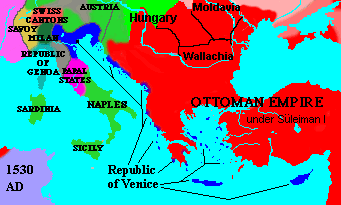
The decline of the Turks in the 17th century allowed a brief Venetian resurgence, whose most striking event, however, was probably the destruction of the Parthenon in 1687, when a Venetian cannonball detonated an Ottoman powder magazine -- the ruin of the Acropolis was not produced by the Goths, the Huns, or any event of the Middle Ages, but by modern warfare. By that time a city state was going to be no match for the colonial and maritime powers that were rapidly becoming modern nation states. Venice lapsed into a kind of 18th century version of Las Vegas, a curiosity and a diversion -- and Las Vegas has now reciprocated with the Venetian Hotel. It was such a Venice that produced the memorable career of Giovanni Casanova (1725-1798), who saw the best and the worse of the City.
After invading Italy and defeating the Austrians, Napoleon had to exert
little enough power to eliminate what had become an anchronism. The French were
a little puzzled by the hostility of the Venetians to their occupation, since
the rousing Republican rhetoric of the French didn't have the effect they
expected -- but it was in a place that was, well, already a Republic. Napoleon,
indeed, might have taken some lessons from the venerable and terrifying Venetian
system of secret police and secret inquisitorial courts. 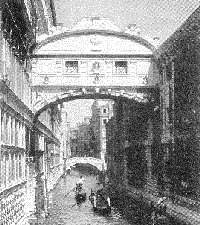 One of the sights of Venice, the "Bridge of Sighs," is a covered way
that secretly transported prisoners back and forth from their secret trials to
their hopeless cells. However hostile to the French, the spirit of Venetian
independence was soon forgotten, and it was the Sardinian Kingdom of Italy that detached Venice
from Austria in 1866. The Venice of the subsequent period appears in Thomas
Mann's Death in Venice (Der Tod in Venedig, 1912), which has been
described as, "a symbol-laden story of aestheticism and decadence..." Venice was just
the place for that.
One of the sights of Venice, the "Bridge of Sighs," is a covered way
that secretly transported prisoners back and forth from their secret trials to
their hopeless cells. However hostile to the French, the spirit of Venetian
independence was soon forgotten, and it was the Sardinian Kingdom of Italy that detached Venice
from Austria in 1866. The Venice of the subsequent period appears in Thomas
Mann's Death in Venice (Der Tod in Venedig, 1912), which has been
described as, "a symbol-laden story of aestheticism and decadence..." Venice was just
the place for that.
On the other hand, the art of Venice, in music -- as with Antonio
Vivaldi (1680-1743) -- painting -- as with Titian, Tiziano Vecilli
(1477-1576) -- and architecture, is an enduring and vivid monument. Part of this
is a hint of the lost beauty of Constantinople, since St. Mark's Cathedral,
crowned with four great horses from the Hippodrome and countless other treasures
looted from Constantinople in 1204, is a copy of the vanished Church of the Holy
Apostles, the burial place of Constantine and his successors (whose site is now
occupied by the Fatih Jamii, the mosque, institute, and burial place of
Meh.med II, the
Conqueror [Fâtih.] of Constantinople). Although decorated with loot, the
present church was completed earlier, in 1094 (or 1071), with the help of
artisans from the still friendly Emperors. The Rialto Bridge across the Grand
Canal, the Campanile bell tower (campana, "bell"), the Lido barrier
island,  and other structures and sites have now contributed their names, if
not their images or functions, in countless modern landscapes. Oxford University
even has its own Bridge of Sighs (right, at Hertford College), though it
apparently was never used for the same purpose as the Venetian (mercifully).
Cambridge University also has a Bridge
of Sighs, across the Cam River (at St. John's College). The Campanile on the
Berkeley campus of the University of California (the
Sather Tower, below right), on the other hand, almost identical in appearance to
the one in Venice, houses a fine carillon, a sort of organ with bells instead of
pipes.
and other structures and sites have now contributed their names, if
not their images or functions, in countless modern landscapes. Oxford University
even has its own Bridge of Sighs (right, at Hertford College), though it
apparently was never used for the same purpose as the Venetian (mercifully).
Cambridge University also has a Bridge
of Sighs, across the Cam River (at St. John's College). The Campanile on the
Berkeley campus of the University of California (the
Sather Tower, below right), on the other hand, almost identical in appearance to
the one in Venice, houses a fine carillon, a sort of organ with bells instead of
pipes.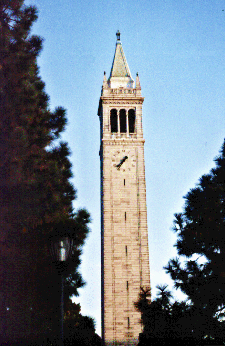
Since 1451, Venice has been the seat of the Patriarchs of Venice, whose story can be examined in a separate popup.
Poised between Francia and Romania, Venice thus preserves much of the beauty and atmosphere that was lost and forgotten after successive catastrophies to Constantinople. The City ended up itself as something out of its time, a Mediaeval Republic in a age of nation states, even as now it is rather like a living museum, slowly sinking into the lagoon that originally gave it refuge.
Indeed, the low muddy islands in the lagoon, once a redoubt, now are Venice's
greatest peril. With zero elevation, the City is vulnerable to high seas, high
tides, and any significant changes in sea level. Pumping out ground water under
the City, long the simplest source of fresh water, threatened to leave it
permanently awash. That danger was soon recognized and attempts have even been
made to restore the water, though that is more difficult. Barriers may soon seal
off the lagoon from the Adriatic, but this raises the problem of discharging the
waste water brought down from inland cities. Any durable solution promises to be
difficult, expensive, and perilous to the traditional character of the City.
Patriarchs of Aquileia, Grado, and Venice
B. REVIVAL AND ASCENDENCY, 802-1059, 257 years
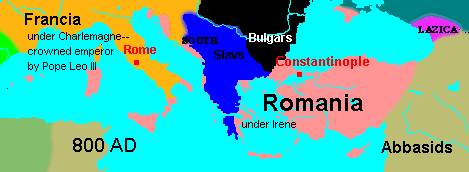 400 years after the opportunity might have originally presented
itself, a German finally claimed the title of Roman Emperor. This was the Frank Charlemagne, in a
move legitimized by the Pope and by the reign of a woman, Irene, in
Constantinople. For a while, Francia looked larger and much more powerful than
Romania, but institutionally it was nowhere as sound or durable. The Empire of
Charlemagne fragmented among his heirs and lapsed into feudalism, a system for
government without cash or literacy. Meanwhile, Romania, with institutional
continuity, commercial culture, and education, began to recover its strength,
despite some severe blows continuing to fall.
400 years after the opportunity might have originally presented
itself, a German finally claimed the title of Roman Emperor. This was the Frank Charlemagne, in a
move legitimized by the Pope and by the reign of a woman, Irene, in
Constantinople. For a while, Francia looked larger and much more powerful than
Romania, but institutionally it was nowhere as sound or durable. The Empire of
Charlemagne fragmented among his heirs and lapsed into feudalism, a system for
government without cash or literacy. Meanwhile, Romania, with institutional
continuity, commercial culture, and education, began to recover its strength,
despite some severe blows continuing to fall.
| 1. NICEPHORANS | |
|---|---|
| Nicephorus I | 802-811 |
| Nicephorus killed in battle by Bulgar Khan Krum, 811 | |
| Stauracius | 811 |
| Michael I Rhangabé | 811-813 |
| Leo V the Armenian | 813-820 |
| Iconoclasm restored, 815; first Varangian (Viking) raids in Anatolia, 818 | |
 Arab raids into Anatolia, the population and the economy of the
empire were actually growing, and Nicephorus was able to start transplanting
colonies of people from the east back into Greece. This soon led to the recovery
of most of the Greek peninsula. Unfortunately for him, the "revival" was not
without its setbacks. Nicephorus ended up killed in battle against the Bulgars, and his son
Stauracius, proclaimed Emperor, turned out to be paralyzed from a spinal wound.
Michael Rhangabe then was inactive and indecisive and was overthrown by Leo the
Armenian, an in-law of the subsequent Amorian dynasty. It would be
some time before the Bulgars could be seriously defeated, much less subdued.
Until then, it would be impossible to restore the Danube border.
Arab raids into Anatolia, the population and the economy of the
empire were actually growing, and Nicephorus was able to start transplanting
colonies of people from the east back into Greece. This soon led to the recovery
of most of the Greek peninsula. Unfortunately for him, the "revival" was not
without its setbacks. Nicephorus ended up killed in battle against the Bulgars, and his son
Stauracius, proclaimed Emperor, turned out to be paralyzed from a spinal wound.
Michael Rhangabe then was inactive and indecisive and was overthrown by Leo the
Armenian, an in-law of the subsequent Amorian dynasty. It would be
some time before the Bulgars could be seriously defeated, much less subdued.
Until then, it would be impossible to restore the Danube border.| 2. AMORIANS (PHRYGIANS) | |
|---|---|
| Michael II the Stammerer |
820-829 |
| Crete lost, 823 Sicily invaded by Aghlabids, 827 | |
| Theophilus I | 829-842 |
| Varangians arrive
at Constantinople, 839 | |
| Michael III | 842-867 |
| Final repudiation of Iconoclasm, 843; Varangians attack Constantinople, 860 | |
| (Theophilus II) | 867 |

The arrival of the Varangians, which meant the Vikings who had come down the
rivers of Russia, ended up
providing a source of mercenaries for what became the Emperor's "Varangian
Guard," whose ranks would later even fill with Englishmen who fled the Norman conquest in
1066. Relations with the Varangians rocked back and forth between war and trade,
mainly depending on what they thought they could get away with. They were
prepared for both. As it happened, the Norsemen were rather less successful
against the Romans than they were against the Franks. We also find the last of
Iconoclasm laid to rest, though one will note even today that the Orthodox
Churches prefer Icons rather than sculpture for sacred images. The resolution of
this conflict removed a point of friction between the Western and the Eastern
Churches. It did reveal, however, how easily such conflict could arise. The
later (1054) Schism of the Churches would be over apparently much more trivial
issues -- the real issue, of course, was simply authority.
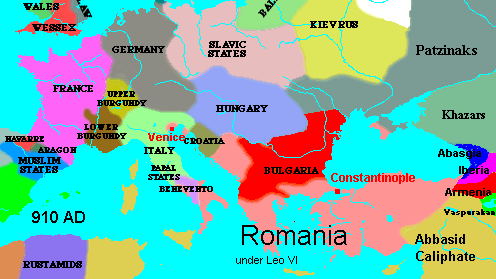 We are approaching the point in European history where the remaining
pagan peoples of Europe will be assimilated to Christian civilization. Bulgaria
will lead the way, but it will soon be following by Hungary, Poland, Russia, and
Scandinavia. The Pechenegs (or Patzinaks), a Turkic steppe people, will remain
pagans until they are swept from history by the Cumans and Mongols. On the east
edge of the map is the Khanate of the Khazars, also Turkic, who actually
converted to Judaism. They would be Roman allies until disappearing in the 11th
century.
We are approaching the point in European history where the remaining
pagan peoples of Europe will be assimilated to Christian civilization. Bulgaria
will lead the way, but it will soon be following by Hungary, Poland, Russia, and
Scandinavia. The Pechenegs (or Patzinaks), a Turkic steppe people, will remain
pagans until they are swept from history by the Cumans and Mongols. On the east
edge of the map is the Khanate of the Khazars, also Turkic, who actually
converted to Judaism. They would be Roman allies until disappearing in the 11th
century.
| 3. BULGARIA BEFORE ROMAN CONQUEST | |
|---|---|
| Asparukh | Qaghan, c.681-701 |
| Tervel | c.701-c.718 |
| Sevar | c.718-750 |
| Kormesios | 750-762 |
| Vinekh | 762-763 |
| Teletz | |
| Umar | 763 |
| Baian | 763-765 |
| Tokt | 765 |
| Telerig | c.765-777 |
| Kardam | c.777-c.803 |
| Krum | c.803-814 |
| Kills Emperor Nicephorus
in battle, 811; uses his skull as a drinking cup | |
| Dukum | 814-815 |
| Ditzveg | 814-816 |
| Omurtag | 814-831 |
| Malamir/Malomir | 831-836 |
| Presijan | 836-852 |
| Boris I/ Emperor Michael I |
Qaghan, 852-870 |
| Emperor/Tsar, 870-889, d.907 | |
| Council VIII, Constantinople IV, 869-870; conversion of Bulgaria announced | |
| Vladimir | 889-893 |
| Simeon I the Great | 893-927 |
| Peter I | 927-969 |
| Boris II | 969-972, d.986 |
| Bulgaria conquered by John I Tzimisces, 971 | |
| Macedonian Bulgaria; state organized in western Bulgaria by the Cometopuli, "Sons of the Count" | |
| Tsar Romanus | figurehead, 986-997; captured, 991 |
| Samuel | 997-1014 |
| Army annihilated by Basil II, 1014 | |
| Gabriel Radomir | 1014-1015 |
| John Vladislav | 1015-1018 |
| Bulgaria annexed by Basil II, 1018 | |
 The Slavs, who had breached the Danube with the Avars, but who had
little in the way of indigenous political organization, then came under the
control of the Bulgars, the next nomadic group to pop off the end of the steppe.
A related people, the Khazars, who remained on the Lower Volga, became long term
Roman allies against the Bulgars. Other related peoples, the Patzinaks and
Cumans, followed the Bulgars off the steppe and into the Balkans, though not
permanently south of the Danube. After the Cumans, the Mongols were the last
steppe people to come into Europe. Through the Middle East, of course, the Turks
(and the Mongols) came off the steppe and ultimately, permanently, into
Azerbaijan, Anatolia, and Thrace.
The Slavs, who had breached the Danube with the Avars, but who had
little in the way of indigenous political organization, then came under the
control of the Bulgars, the next nomadic group to pop off the end of the steppe.
A related people, the Khazars, who remained on the Lower Volga, became long term
Roman allies against the Bulgars. Other related peoples, the Patzinaks and
Cumans, followed the Bulgars off the steppe and into the Balkans, though not
permanently south of the Danube. After the Cumans, the Mongols were the last
steppe people to come into Europe. Through the Middle East, of course, the Turks
(and the Mongols) came off the steppe and ultimately, permanently, into
Azerbaijan, Anatolia, and Thrace.
Fans of Robert E. Howard's (1906-1936) classic pulp fiction character Conan the Barbarian, will find the name of the Bulgar Qaghan Krum somewhat familiar -- it is rather like Conan's own personal god, "Crom." Krum, indeed, seems very Conan-like. Not only was the Emperor Nicephorus killed in battle, but Krum took his skull and turned it into a drinking cup. This sounds like "barbarism" indeed -- though Lord Kitchener (1850-1916) may have had something similar in mind when he removed the body of the Sudanese Mahdi from his tomb, after taking Khartoum in 1898.
More recently, readers of Harry Potter and the Goblet of Fire [J.K.
Rowling, Arthur A. Levine Books, Scholastic, Inc., 2000] will remember that the
champion Bulgarian Quidditch player was none other than Viktor Krum.
What happened to the Bulgars was assimilation. The Patzinaks pushed them off
the steppe, 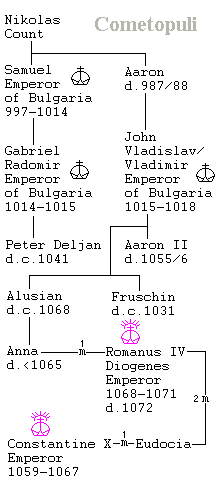 they began to speak the language of their Slavic subjects, and they
began to aspire to the civilization, if not the throne, of Constantinople. The
conversion of the Bulgars, indeed, was a complicated political act, with
sophisticated negotiations that played the Popes off the Emperors. Greek
influence ended up predominating, but the Bulgars continued jealous of their
autonomy -- the precedent of an autocephalous Church set the pattern for other
Orthodox Churches, as in Russia, created under Roman
auspices. The Qaghan Boris took the Christian name Michael (though both names
would be used in the future), but retained a status comparable to the Roman
Emperor. The newly invented
they began to speak the language of their Slavic subjects, and they
began to aspire to the civilization, if not the throne, of Constantinople. The
conversion of the Bulgars, indeed, was a complicated political act, with
sophisticated negotiations that played the Popes off the Emperors. Greek
influence ended up predominating, but the Bulgars continued jealous of their
autonomy -- the precedent of an autocephalous Church set the pattern for other
Orthodox Churches, as in Russia, created under Roman
auspices. The Qaghan Boris took the Christian name Michael (though both names
would be used in the future), but retained a status comparable to the Roman
Emperor. The newly invented  Cyrillic alphabet was used for the Slavic language of the new
national Church. This language, Old Church Slavonic, is the oldest attested
Slavic language and retains features apparently ancestral of most modern Slavic
languages.
Cyrillic alphabet was used for the Slavic language of the new
national Church. This language, Old Church Slavonic, is the oldest attested
Slavic language and retains features apparently ancestral of most modern Slavic
languages.
Although remaining a formidable foe, the Bulgars were probably softened by their assimilation and civilization. As the Empire itself grew in strength, the day came when Bulgaria was defeated and subjugated. The first step merely left it leaderless, as John Tzimisces took Emperor Boris II off to Constantinople. A new state was organized in the west, however, by the sons of the Bulgar governor Count Nicholas. These "Sons of the Count," Cometopuli, eventually got an Emperor back after Boris and his brother Romanus escaped captivity. Boris was accidentally killed, so Romanus became the (largely figurehead) ruler. The Emperor Basil II then smashed and annexed this state, with a ferocity that that might have made Krum (or Conan) proud. Samuel is supposed to have dropped dead when he saw that Basil had blinded all the survivors of the Bulgarian army (leaving every tenth man with one eye to lead the rest). Bulgaria would not reemerge until the Asen brothers led it to independence in 1186. After the Turkish conquest, modern Bulgaria did not emerge until 1878.
Lists of Bulgarian rulers can be found in various Byzantine histories, but
the genealogy here only comes from the Erzählende genealogische Stammtafeln
zur europäischen Geschichte, Volume II, Part 2, Europäiche Kaiser-,
Königs- und Fürstenhäuser II Nord-, Ost- und Südeuropa [Andreas Thiele, R.
G. Fischer Verlag, Part 2, Second Edition, 1997, pp.156-159].
| 4. MACEDONIANS | |
|---|---|
| Basil I | 867-886 |
| Aghlabids sack
Ostia & (suburbs of?) Rome, including the Vatican, 846; Varangians attack Constantinople, 865; Ecumenical Council VIII, Constantinople IV, 869-870 -- reconciles Eastern and Western Churches but is later repudiated by East; conversion of Bulgaria announced. Syracuse falls to Aghlabids 878; Venice effectively independent, 886 | |
| Leo VI the Wise | 886-912 |
| Varangians/Russians attack Constantinople, 907 | |
| Alexander | 886-913 |
| Constantine VII Porphyrogenitus |
913-959 |
| Varangians/Russians attack Constantinople, 941, 944; Treaty, 944 | |
| Romanus I Lecapenus |
919-944 |
| Stephen & Constantine |
944-945 |
| Romanus II | 959-963 |
| Crete recovered, 961; foundation of Great Laura Monastery on Mt. Athos, 963 | |
| Nicephorus II Phocas |
963-969 |
| Cyprus recovered, 964; Cilicia & Tarsus recovered, 965; Antioch recovered from H.amdânids, 969 | |
| John I Tzimisces | 969-976 |
| Russian Prince Sviatoslav defeated, Bulgaria conquered, 971; Charter for Mt. Áthôs, 972 | |
| Basil II Bulgaroctonus |
963-1025 |
| rebellion of Bardas Phocas, 987-988; Varangian Guard, 988; Conversion of Russia, 989; Bulgarian Army annihilated, 1014; Macedonian Bulgaria annexed, 1018 | |
| Constantine VIII | 976-1028 |
| Zoë Porphyrogenita |
1028-1050 |
| Romanus III Argyrus |
1028-1034 |
| Michael IV the Paphlagonian |
1034-1041 |
| beginning of debasement of the solidus | |
| Michael V Calaphates |
1041-1042 |
| Theodora Porphyrogenita |
1042-1056 |
| Constantine IX Monomachus |
1042-1055 |
| Russians attack Constantinople, 1043; occupation of Armenia, 1045; Charter for Mt. Áthôs, Schism between Eastern and Western Churches, 1054 | |
In the early days of the dynasty we get a benchmark on the survival of Classical and later Greek literature. The Bibiotheca of the Patriarch of Constantinople Photius (858-867, 877-886) contains 280 reviews. This is not a catalogue of existing literature, or of a particular library, not even that of Photius. It is a treatment of works familiar to Photius, apart from the mainstream of general education, that Photius is recommending to his brother Tarasius. Thus, popular authors like Homer, Plato, Aristotle, or the Greek playwrights are missing from the list. Photius' treatment ranges from brief descriptions and evaluations to long summaries and discussions. Of the 386 works mentioned by Photius, 239 are theological. Nevertheless, only 43% of the text actually focuses on them. The majority of the text (in a book whose modern edition in Greek is 1600 pages long) is thus secular. For example, in addressing A History of Events After Alexander (in ten books) by the Roman historian Arrian of Nicomedia (an early member of the Second Sophistic), we get a long summary of those very events, which are often obscure enough that every description helps. Although much of Arrian survives, and his Anabasis Alexandri is the best account of the campaigns of Alexander, all we have of A History of Events After Alexander is Photius' summary. Our benchmark is that about half of the works mentioned by Photius, like the Events, are now lost. It is distressing to think of what survived, despite the Dark Ages, and then what later disasters, like the Fourth Crusade, may have cost us. It is hard to imagine an undisturbed Constantinople being subsequently so careless with its literary heritage. At no other Court of the age could visitors have found the nobility quoting Homer. [cf. Photius, The Bibiotheca, A selection translated with notes by N.G. Wilson, Duckworth, London, 1994.] Photius, whose Bibliotheca was only part of his literary output, was a major political figure and himself was responsible for the mission of Cyril and Methodius to convert the Slavs.
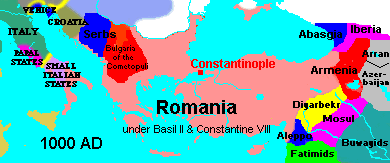
The
map shows Romania in 1000 AD, at the Millennium, with the height of Middle
Romanian power rapidly approaching. The extent of Bulgaria is open to
question. Some sources say it stretched to the Black Sea. Whatever, it will soon
be erased.
The climax of Mediaeval Romania came with the Emperor Basil II Bulgaroctonus ("Bulgar Slayer," Bulgarentöter in German). He also happened to be ruling at the turn of the first Millennium, which is of some interest as we have now seen the year 2000. Christendom had been having a bad time for several centuries, but things were looking up in 1000. After a long minority with in-laws ruling as co-regents, Basil defeated and captured an entire Bulgarian army in 1014. He blinded every prisoner, except for one eye left to every tenth man, so they could lead their fellows home. The Tsar Samuel is supposed to have dropped dead when he beheld the mutilated men returning. Bulgaria only lasted four more years before being annexed.
In our day, the movie, End of Days (Universal, 1999), has Arnold Schwarzenegger personally battling Satan, who is said to be released every thousand years (a somewhat loose reading of the Book of Revelation). This would mean that a similar difficulty occurred in 999, as well as 1999. Arnold wasn't around then, but Basil II was -- not only a great warrior but an Emperor who maintained a monk-like celibacy, and who was seen by most Christians as the principal defender of Christendom, as the Emperors had been since Constantine. Somebody missed a bet for a good movie, or at least a flashback, about that -- End of Days itself could have had a flashback explaining how Satan was easily thwarted in 999 by the undiminished wisdom, strength, and preparedness of Basil, Pope Sylvester II (this was before the Schism), and the Patriarch Sergius II of Constantinople.
The monks of the "Holy Mountain," Hágion Óros, Mt.
Áthôs, could be brought into any story of the Millennium. The Great Laura
Monastery, the first of many in this most sacred place, the Mt. Hiei, 
 , of Orthodox Christianity, had recently been built
(961-963) by St. Athanasius. Tradition holds with some earlier foundations, and
several small hermitages, as well as individual hermits in caves and elsewhere,
certainly had been there for some time; but the Great Laura is the first for
which there is contemporary historical documentation.
, of Orthodox Christianity, had recently been built
(961-963) by St. Athanasius. Tradition holds with some earlier foundations, and
several small hermitages, as well as individual hermits in caves and elsewhere,
certainly had been there for some time; but the Great Laura is the first for
which there is contemporary historical documentation.
Áthôs 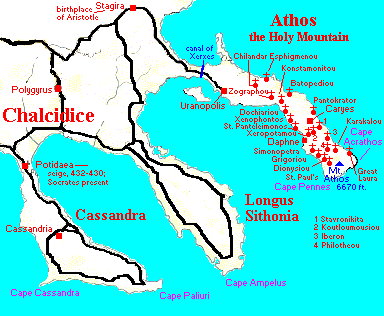 is the most north-eastern of three peninsulas that extend out into
the Aegean Sea from the larger peninsula of the Chalcidice. There are still 20
active monasteries on the Mountain, with a number of smaller settlements and
institutions. The road from the mainland ends at Uranopolis (or
Ouranoupoli, one now usually sees spellings that reflect modern Greek
pronunciation -- I have Latinized many of the names, but the spelling of the
monasteries especially reflects this trend). From there one (men only) must take
a boat down to Daphne. From Daphne a road, recently built, goes up to Caryes
(Karyes, Karyai), the town that is the administrative center of the Mountain, on
the land of the Koutloumousiou Monastery. Although most Greek churches operate
under the authority of the autocephalous Greek Orthodox Church, Mt. Áthôs is
still under the direct jurisdiction of the Patriarch of
Constantinople, i.e. the "Ecumenical" Patriarch in Istanbul. Over the years,
monasteries were founded, not just by Greeks, but by Georgians, Serbs,
Bulgarians, Russians, and even Italians. The Italians are now gone (there being
the Schism and all), but there are also (modern) Romanians present, though they
do not have their own monastery. Mt. Áthôs thus unites all the Orthodox Churches
who share the theology of Constantinople. The mysticism of the theology of Mt.
Áthôs contrasts with the humanism of Mistra -- this is
discussed elsewhere in relation to the Renaissance.
is the most north-eastern of three peninsulas that extend out into
the Aegean Sea from the larger peninsula of the Chalcidice. There are still 20
active monasteries on the Mountain, with a number of smaller settlements and
institutions. The road from the mainland ends at Uranopolis (or
Ouranoupoli, one now usually sees spellings that reflect modern Greek
pronunciation -- I have Latinized many of the names, but the spelling of the
monasteries especially reflects this trend). From there one (men only) must take
a boat down to Daphne. From Daphne a road, recently built, goes up to Caryes
(Karyes, Karyai), the town that is the administrative center of the Mountain, on
the land of the Koutloumousiou Monastery. Although most Greek churches operate
under the authority of the autocephalous Greek Orthodox Church, Mt. Áthôs is
still under the direct jurisdiction of the Patriarch of
Constantinople, i.e. the "Ecumenical" Patriarch in Istanbul. Over the years,
monasteries were founded, not just by Greeks, but by Georgians, Serbs,
Bulgarians, Russians, and even Italians. The Italians are now gone (there being
the Schism and all), but there are also (modern) Romanians present, though they
do not have their own monastery. Mt. Áthôs thus unites all the Orthodox Churches
who share the theology of Constantinople. The mysticism of the theology of Mt.
Áthôs contrasts with the humanism of Mistra -- this is
discussed elsewhere in relation to the Renaissance.
Sadly, the great triumph of Romania was short-lived. The last Emperors of the
Dynasty, all by marriage, squandered the strength of the State, debased the
coinage, and neglected the thematic forces that had been the military foundation
of Romania for four hundred years. Imperial guards of mercenaries, as
Machiavelli could have warned, could not be relied upon in all circumstances,
especially after the finances of the state were messed up. Most symbolically,
the breach between the Eastern and Western Churches in 1054 was the one that
became permanent and henceforth separated the One Holy Roman Catholic and
Apostolic Church into the Pope's Latin Church, usually called "Roman Catholic,"
and the Patriarch of Constantinople's Greek Church, traditionally called "Greek
Orthodox" -- along with the other autocephalous "Orthodox" Churches (Russian,
Bulgarian, Serbian, Romanian, etc.).
The estrangement in religion came at a very bad time. When the Turks invaded
and the Crusading forces arrived from Francia, the Schism was a source
of constant irritation and mistrust. It provided some rationalization for the
seizure of Constantinople by the Fourth Crusade; and later,
when the Churches were apparently reconciled by the Palaeologi, it left most
Greeks so disaffected that their support for their own government was
compromised. Thus, for centuries, Christian forces were divided and weakened in
the continuing confrontation with Islâm.
 Here we see the confusion over the paternity of Leo VI.
Subsequently, in the minorities of Constantine VII, Basil II, and Constantine
VIII, we see multiple reigns from Imperial in-laws. John I and Nicephorus II
were extremely vigorous and successful in retrieving Romanian fortunes, finally
to be sealed by the adult Basil. After the death of Constantine VIII, only
Theodora and Zoë, both nuns, remained of the dynasty. Zoë endured three
marriages to provide male sovereigns. These in-laws were as bad for the Empire
as the earlier ones had been good. After the death of Constantine Monomachus,
Theodora briefly reigned alone at the end of the line.
Here we see the confusion over the paternity of Leo VI.
Subsequently, in the minorities of Constantine VII, Basil II, and Constantine
VIII, we see multiple reigns from Imperial in-laws. John I and Nicephorus II
were extremely vigorous and successful in retrieving Romanian fortunes, finally
to be sealed by the adult Basil. After the death of Constantine VIII, only
Theodora and Zoë, both nuns, remained of the dynasty. Zoë endured three
marriages to provide male sovereigns. These in-laws were as bad for the Empire
as the earlier ones had been good. After the death of Constantine Monomachus,
Theodora briefly reigned alone at the end of the line.
The genealogy of the Macedonians is supplemented here with an abbreviated
tree showing the major foreign marriages of the Dynasty. The marriage of
Constantine VII to the daughter of Hugh of Arles is shown
above, but there are four other marriages noted here.  Two of them are not attested by all sources. Leo VI did have a
daughter Anna (by his second wife), and marrying her to Hugh's predecessor in
Burgundy, while his son married Hugh's daughter, produces a reasonable
reciprocity; but marrying a true Porphyrogenita, a "Born in the Purple"
Princess, to a barbarian king (which is what Louis III would have seemed to
most), is something that some sources say was inconceivable, which is why all
that the Emperor Otto II
got was merely the niece of an Imperial in-law, John Tzimisces.
Theophano was no Porphyrogenita (though some sources can be found referring to
her as John's own daughter, or even as a daughter of Romanus II). St. Vladimir, however,
certainty did marry the Porphyrogenita sister, Anna, of Basil II and Constantine
VIII. Since this attended the conversion of Russia to Christianity (989), with
the material contribution of Russian (Varangian) troops to the Roman Army, it
could well have been thought worth the price. The final marriage here is the
most poorly attested and problematic. Brian
Tompsett's Royal and Noble Genealogy gives a sister "Irene" for the
Empresses Zoë and Theodora, who is said to have married Vsevolod of Kiev,
grandson (by an earlier marriage) of St. Vladimir. I have not seen a single
Macedonian genealogy that lists such an "Irene." This would be of great interest
because their son, Vladimir II, was the grandfather of Ingeborg of Novgorod, who
married (1118) Knut Lavard Eriksson, the father of King Valdemar the Great
of Denmark (1157-1182). Through the intermarriages of the subsequent royalty of
Denmark, we get connections to many of the rulers of Europe. Thus, it is
sometimes said that Queen Elizabeth II of England is a descendant of the Emperor
Basil I. But that would only be true if Irene really was a Macedonian.
Two of them are not attested by all sources. Leo VI did have a
daughter Anna (by his second wife), and marrying her to Hugh's predecessor in
Burgundy, while his son married Hugh's daughter, produces a reasonable
reciprocity; but marrying a true Porphyrogenita, a "Born in the Purple"
Princess, to a barbarian king (which is what Louis III would have seemed to
most), is something that some sources say was inconceivable, which is why all
that the Emperor Otto II
got was merely the niece of an Imperial in-law, John Tzimisces.
Theophano was no Porphyrogenita (though some sources can be found referring to
her as John's own daughter, or even as a daughter of Romanus II). St. Vladimir, however,
certainty did marry the Porphyrogenita sister, Anna, of Basil II and Constantine
VIII. Since this attended the conversion of Russia to Christianity (989), with
the material contribution of Russian (Varangian) troops to the Roman Army, it
could well have been thought worth the price. The final marriage here is the
most poorly attested and problematic. Brian
Tompsett's Royal and Noble Genealogy gives a sister "Irene" for the
Empresses Zoë and Theodora, who is said to have married Vsevolod of Kiev,
grandson (by an earlier marriage) of St. Vladimir. I have not seen a single
Macedonian genealogy that lists such an "Irene." This would be of great interest
because their son, Vladimir II, was the grandfather of Ingeborg of Novgorod, who
married (1118) Knut Lavard Eriksson, the father of King Valdemar the Great
of Denmark (1157-1182). Through the intermarriages of the subsequent royalty of
Denmark, we get connections to many of the rulers of Europe. Thus, it is
sometimes said that Queen Elizabeth II of England is a descendant of the Emperor
Basil I. But that would only be true if Irene really was a Macedonian.
Now, however, I have found a new source with a slightly different claim. The Royal Families of Medieval Scandinavia, Flanders, and Kiev, by Rupert Alen and Anna Marie Dahlquist [Kings River Publications, Kingsburg, CA, 1997], says that Irene (or Irina) was "a daughter of Constantine IX Monomach" [p.160]. That is a lot different. Constantine was the Empress Zoë's third husband. She was already 64 when they married, so there is not much chance that Irene was her child, but Constantine was a widower, and it is not surprising that he would have previous children. Vladimir II is called "Monomakh," which thus sounds like a tribute to his Roman grandfather. This gives us a much more reasonable picture, but it does mean that Queen Elizabeth is not a descendant of Basil I (or Michael III, whatever).
| non-dynastic | |
|---|---|
| Michael VI Stratioticus | 1056-1057 |
| Isaac I Comnenus | 1057-1059 |
 IV. FOURTH EMPIRE, LATE "ROMANIA/BYZANTIUM," 1059 AD-1453 AD, Era of
Diocletian 776-1170, 394 years
IV. FOURTH EMPIRE, LATE "ROMANIA/BYZANTIUM," 1059 AD-1453 AD, Era of
Diocletian 776-1170, 394 years
Then followed a scene of massacre and pillage: on every hand the Greeks were cut down, their horses, palfreys, mules, and other possessions snatched as booty. So great was the number of killed and wounded that no man could count them. A great part of the Greek nobles had fled towards the gate of Blachernae; but by this time it was past six o'clock, and our men had grown weary of fighting and slaughtering. The troops began to assemble in a great square inside Constantinople. Then, convinced that it would take them at least a month to subdue the whole city, with its great churches and palaces, and the people inside it, they decided to settle down near the walls and towers they had aleady captured....Our troops, all utterly worn out and weary, rested quietly that night. But the Emperor [Alexius V] Murzuphlus did not rest; instead, he assembled his forces and said he was going to attack the Franks. However, he did not do as he had announced, but rode along certain streets as far away as possible from those occupied by our army, till he came to a gate called the Golden Gate through which he escaped, and so left the city.
Geoffroy de Villehardouin (d.1218), "The Conquest of Constantinople," Chronicles of the Crusades, Penguin, 1963, p.91
The "Fourth Empire" begins with a blow, from an Islâm reinvigorated by the Turks, which represents not only a further diminution of the Empire, but a portent of the actual collapse and end of the Empire altogether. The catastrophic defeat at Manzikert alienated much of what had for long been the heartland of the Empire, Anatolia. It was a mortal wound, never to be made good; but the Empire nevertheless twice managed to struggle back up into at least local ascendancy, first under the Comneni and then under the Palaeologi. The Comneni had help, of a very dangerous sort, in the form of the Crusaders. Defeat by the Turks was not the cruelest cut of the period. That was when the Crusaders, manipulated by Venice, took Constantinople in 1204. With the Latins, the Empire fragmented into multiple Greek and non-Greek contenders: Nicaea, Epirus, Trebizond, Bulgaria, and Serbia, not to mention the Turks. While the Palaeologi, building on the success of Nicaea, reestablished Greek rule, only Epirus of the other successor states came back under Imperial control. The Empire of Michael VIII did seem to have a chance, but a new Turkish state, of the Ottomans, soon surged into dominance. It took more than a century for the Ottomans to scoop up all the spoils, but, like a slow motion car crash, the outcome has a horrible inevitability.
A. THE ADVENT OF THE TURKS, 1059-1185, 126 years
 1060 AD -- Romanian territory is intact, but the military and
financial foundations of Roman power have been undermined. The coinage is
debased for the first time since Constantine. Resources have been wasted
absorbing Armenia, and the forces of the Armenian themes have been disbanded.
Local Islamic states are no threat, but the Seljuks are on the way.
1060 AD -- Romanian territory is intact, but the military and
financial foundations of Roman power have been undermined. The coinage is
debased for the first time since Constantine. Resources have been wasted
absorbing Armenia, and the forces of the Armenian themes have been disbanded.
Local Islamic states are no threat, but the Seljuks are on the way.
| 1. DUCASES | |
|---|---|
| Constantine X Ducas | 1059-1067 |
| Loss of Armenia, 1064 | |
| Romanus IV Diogenes | 1068-1071 |
| Defeated and Captured by Seljuk Great Sult.ân Alp Arslan, Battle of Manzikert; Bari captured by Normans, 1071 | |
| Michael VII Parapinakes | 1071-1078 |
| Nicephorus III Botaniates | 1078-1081 |
 Catastrophe. The heartland of the Empire in Anatolia is completely
overrun. Only European possessions, secured not long before, enable Romania to
endure and recover, somewhat -- with the dangerous help of the Crusaders.
Catastrophe. The heartland of the Empire in Anatolia is completely
overrun. Only European possessions, secured not long before, enable Romania to
endure and recover, somewhat -- with the dangerous help of the Crusaders.
| 2. SELJUK SULT.ÂNS OF RÛM | |
|---|---|
| Süleyman I ibn Qutalmïsh | 1078-1086 |
| Kilij (Qïlïch) Arslan I | 1092-1107 |
| Malik Shâh | 1107-1116 |
| Mas'ûd I Rukn ad-Dîn | 1116-1156 |
| Kilij Arlsan II | 1156-1192 |
| Myriocephalon, 1176; Konya sacked by Frederick Barbarossa on the Third Crusade, 1190 | |
| Kay Khusraw (Khosru) I | 1192-1196, 1205-1210 |
| Süleyman II | 1196-1204 |
| Kilij Arlsan III 'Izz ad-Dîn | 1204-1205 |
| Kay Kâwûs I | 1210-1220 |
| Kay Qubâdh I 'Alâ' ad-Dîn | 1220-1237 |
| Kay Khusraw II Ghiyâth ad-Dîn | 1237-1246, 1257-1959 |
| Defeated by Mongols, Battle
of Köse Dagh, become vassals, 1243 | |
| Kay Kâwûs II | 1246-1257 |
| Kilij Arslan IV | 1248-1265 |
| Kay Qûbâdh II | 1249-1257 |
| Kay Khosru III Ghiyâth ad-Dîn | 1265-1282 |
| Control by Mongol Governors, 1277 | |
| Mas'ûd II | 1282-1284, 1284-1293, 1294-1301, 1303-1307 |
| Kay Qûbâdh III | 1284, 1293-1294, 1301-1303 |
| Mas'ûd III | 1307 |
| Deposed by Mongols, 1307 | |
 virtually in rebellion against, the Seljuk Great Sult.ân Malik
Shâh (1073-1092), who was even negotiating with Alexius Comnenus for the
withdrawal of the Turks from the region. However, even the Seljuks were in no
position to force such a withdrawal, and Roman resistance was so weak that
Süleyman had no difficulty establishing his capital at Nicaea. The best that
Alexius could do was to keep him back from Nicomedia. Meanwhile, even western
cities like Ephesus were falling. The Turkish position was secure until defeat
by the First Crusade in 1097. Then Alexius was able to recover the western
cities. The Turks fell back on Iconium (Konya), which became their capital for
the rest of the history of the Sultanate of Rûm. Although sacked by Frederick
Barbarosa on the Third Crusade (1190), Konya was lost forever to Romania. The
Sultanate already, however, seemed to have lost its edge. The devastating defeat
of Manuel Comnenus at Myriocephalum (1176) was not followed up, and the
subsequent decline of Romania was mainly from internal weakening and
fragmentation (readying it for the Fourth Crusade). The Sultanate was then
defeated by the Mongols in 1243 and spent the rest of its history in vassalage.
The final fall, in 1307, coincided with a very fragmented, but vigorous, period
of new Turkish states -- the the Oghullar or "sons"
of Rûm.
virtually in rebellion against, the Seljuk Great Sult.ân Malik
Shâh (1073-1092), who was even negotiating with Alexius Comnenus for the
withdrawal of the Turks from the region. However, even the Seljuks were in no
position to force such a withdrawal, and Roman resistance was so weak that
Süleyman had no difficulty establishing his capital at Nicaea. The best that
Alexius could do was to keep him back from Nicomedia. Meanwhile, even western
cities like Ephesus were falling. The Turkish position was secure until defeat
by the First Crusade in 1097. Then Alexius was able to recover the western
cities. The Turks fell back on Iconium (Konya), which became their capital for
the rest of the history of the Sultanate of Rûm. Although sacked by Frederick
Barbarosa on the Third Crusade (1190), Konya was lost forever to Romania. The
Sultanate already, however, seemed to have lost its edge. The devastating defeat
of Manuel Comnenus at Myriocephalum (1176) was not followed up, and the
subsequent decline of Romania was mainly from internal weakening and
fragmentation (readying it for the Fourth Crusade). The Sultanate was then
defeated by the Mongols in 1243 and spent the rest of its history in vassalage.
The final fall, in 1307, coincided with a very fragmented, but vigorous, period
of new Turkish states -- the the Oghullar or "sons"
of Rûm.
This list is from Clifford Edmund Bosworth's The New Islamic Dynasties
[Edinburgh University Press, 1996].
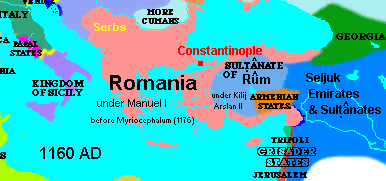 The Empire has recovered as much as it is ever going to, and
actually seems in relatively good shape, with deference all the way from
Jerusalem to Hungary. But the Sultânate of Rûm is a nut that cannot be cracked
-- the true seed of doom for Romania. And Roman trade and shipping is now
dominated by Venice.
The Empire has recovered as much as it is ever going to, and
actually seems in relatively good shape, with deference all the way from
Jerusalem to Hungary. But the Sultânate of Rûm is a nut that cannot be cracked
-- the true seed of doom for Romania. And Roman trade and shipping is now
dominated by Venice.
| 3. COMNENI | |
|---|---|
| Alexius I Comnenus | 1081-1118 |
| Trade concession to Venice,
1082; First Crusade, 1096-1099 | |
| John II | 1118-1143 |
| captures Leon I of Armenia, 1137 | |
| Manuel I | 1143-1180 |
| Second Crusade, 1147-1149; homage of Thoros II of Armenia, Reynald of Antioch, & Baldwin III of Jerusalem, 1158-1159; secures Dalmatia, Croatia, & Bosnia, 1167; all Venetians arrested in Romania, 1171; Myriocephalon, defeat by Kilij Arlsan II, 1176 | |
| Alexius II | 1180-1183 |
| Serbia independent, 1180; Bela III takes Dalmatia, Bosnia, & Sirmium | |
| Andronicus I | 1183-1185 |
| Isaac Comnenus | Emperor on Cyprus, 1185-1191 |
Curiously, in the days of Alexius I the heart of the Roman Army, the
Varangian Guard, had a large element of Saxons, conquerors of Roman
Britain, who now were refugees from the Norman Conquest of England in 1066.
According to Geoffroy de Villehardouin, there were still "Englishmen and Danes"
in the Roman Army when the Fourth Crusade arrived at
Constantinople in 1203. Anna Comnena (d.1153), daughter of Alexius I, wrote a history of her father's
reign, the Alexiad. Most of it was written after she was banished to a
convent by her brother, John II, whom she apparently had tried to assassinate.
This particularly intense form of sibling rivalry was in part the result of
Anna's expectation that she would be closer to the seat of power, i.e. that the
Emperor would be her husband. The birth of John spoiled this, and Anna, perhaps
a feminist before her time, never accepted the wisdom of his succession. She
blamed him for subsequent disasters but, since the Alexiad doesn't cover
his reign, she never quite says what they were. The real disaster,
Myriocephalum, happened after her death to her nephew, Manuel I. One reference
to the Alexiad that I remember from childhood, that Anna says her father
didn't trust the Crusaders because they didn't have beards and smelled of
horses, I have been unable to find in the text. B. THE LATIN EMPIRE, 1185-1261, 76 years


From
the few and questionable foreign marriages of the Macedonians, with the
Comneni we find a large number of well attested ones, many with Crusaders but one making
connections as distant as Spain. I was aware of few of these until a
correspondent, Ann Ferland, began to point them out. The marriage of Maria of
Montpellier, whose mother was Eudocia Comnena, to King Peter II of Aragon led to
all subsequent Kings of Aragon and of Spain.
| 1. ANGELI | |
|---|---|
| Isaac II Angelus | 1185-1195 |
| Bulgaria independent, 1186 Third Crusade, 1189-1192; Cyprus seized from Isaac Comnenus by Richard the Lionheart, given to Guy of Lusignan, 1191 | |
| Alexius III | 1195-1203 |
| Kingdom of Lesser
Armenia independent, 1198-1375 | |
| Isaac II (restored) | 1203-1204 |
| Alexius IV | 1203-1204 |
| Alexius V Mourtzouphlos | 1204 |
| Fourth Crusade, 1202-1204 Constantinope falls to Fourth Crusade, 1204 | |
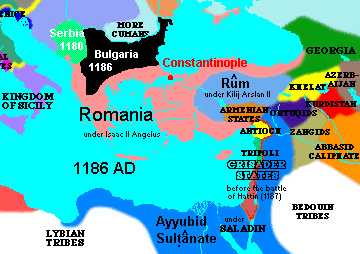
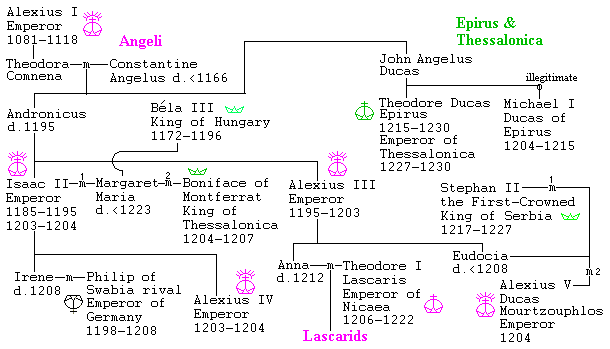
The Angeli continue the foreign marriages of the Comneni. One is particularly
noteworthy. Irene Angelina, daughter of the Isaac II, married a son of
Frederick Barbarossa, Philip of Swabia, who
contended with Otto of Brunswick for the German Empire. They had no sons; but
the marriages of their four daughters are among the most interesting in European
history. In a reconciliation 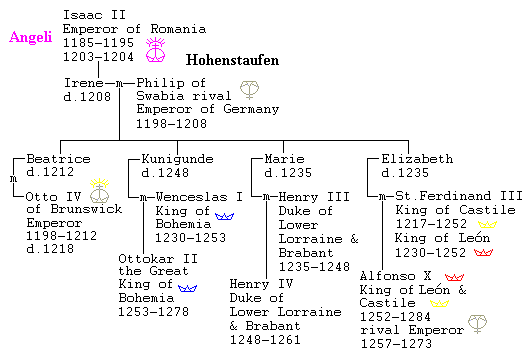 of Philip's feud, the oldest daughter, Beatrice, married Otto
himself. But they had no children. The younger daughters, Kunigunde, Marie, and
Elizabeth, married King Wenceslas I of Bohemia, Duke Henry III of
Lower Lorraine and Brabant, and King &
St. Ferdinand III of Castile and Leon,
respectively. All of these marriages produced children with living modern
descendants, especially among the Hapsburgs and the royal family of Spain, as
can be traced at the linked genealogies. Since Isaac himself was a
great-grandson of Alexius I Comnenus, this means that a large part of modern
European royalty, through this connection alone, have been descendants of the
Angeli and Comneni. My impression is that Roman Imperial descent for recent
royalty has often been claimed through the Macedonians, but the only certain
line, as we have seen,
may be from Macedonian in-laws. On the other hand, descent from the Comneni and
Angeli appears to be well attested and with multiple lines. Another fruitful
line will be from Maria Lascarina, who married Bela IV of Hungary. Since the Lascarids themselves
derive from Anna Angelina, Maria's mother, that connects up to the whole
Comneni-Angeli house. Maria's son, Stephen V of Hungary, had a daughter,
Katalin, who married the Serbian King Stephen
Dragutin, who had a daughter the married a Bosnian Ban, with
many descendants. This line all the way to the Hapsburgs can be examined on a popup.
of Philip's feud, the oldest daughter, Beatrice, married Otto
himself. But they had no children. The younger daughters, Kunigunde, Marie, and
Elizabeth, married King Wenceslas I of Bohemia, Duke Henry III of
Lower Lorraine and Brabant, and King &
St. Ferdinand III of Castile and Leon,
respectively. All of these marriages produced children with living modern
descendants, especially among the Hapsburgs and the royal family of Spain, as
can be traced at the linked genealogies. Since Isaac himself was a
great-grandson of Alexius I Comnenus, this means that a large part of modern
European royalty, through this connection alone, have been descendants of the
Angeli and Comneni. My impression is that Roman Imperial descent for recent
royalty has often been claimed through the Macedonians, but the only certain
line, as we have seen,
may be from Macedonian in-laws. On the other hand, descent from the Comneni and
Angeli appears to be well attested and with multiple lines. Another fruitful
line will be from Maria Lascarina, who married Bela IV of Hungary. Since the Lascarids themselves
derive from Anna Angelina, Maria's mother, that connects up to the whole
Comneni-Angeli house. Maria's son, Stephen V of Hungary, had a daughter,
Katalin, who married the Serbian King Stephen
Dragutin, who had a daughter the married a Bosnian Ban, with
many descendants. This line all the way to the Hapsburgs can be examined on a popup.
| 2. BULGARIA, ASENS | |
|---|---|
| John I Asen | 1186-1196 |
| Peter II Asen | 1196-1197 |
| Kalojan Asen, the Roman Killer |
1197-1207 |
| captures Baldwin I,
1205; kills Boniface of Montferrat, 1207 | |
| Boril | 1207-1218 |
| John II Asen | 1218-1241 |
| Defeated & Captured Theodore Ducas of Epirus, 1230; Mongol invasion, 1242 | |
| Kaloman I | 1242-1246 |
| Michael II Asen | 1246-1257 |
| Kaloman II | 1257-1258 |
| Constantine Tich | 1257-1277 |
| Ivan Mytzes | 1278-c.1264 |
| Ivalio | 1277-1279, d.1280 |
| John III Asen | 1279-1284?, d.<1302 |
| Asens replaced by Terters | |
In 1204, the Pope recognized Kalojan as "King of the Bulgarians and the
Vlachs" (Geoffroy de Villehardouin, calling him "Johanitza," even says "King of
Wallachia and Bulgaria").  Indeed, the Asen brothers, founders of the dynasty, were themselves
Vlachs, i.e. modern Romanians. This is
therefore not a purely ethnic Bulgarian state. It also came close to succeeding
to the throne in Constantinople, though later overpowered by the Mongols, Serbia and, of course, the
Ottomans.
Indeed, the Asen brothers, founders of the dynasty, were themselves
Vlachs, i.e. modern Romanians. This is
therefore not a purely ethnic Bulgarian state. It also came close to succeeding
to the throne in Constantinople, though later overpowered by the Mongols, Serbia and, of course, the
Ottomans.
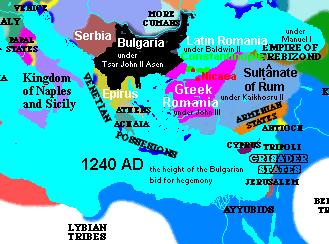
The principal setback to the Bulgarian state was the Mongol invasion of 1242,
which itself was almost an afterthought as the Mongols abandoned the conquests
of Poland and Hungary in 1241 and were returning to Russia. The Chingnizids
needed to go to Mongolia to elect a new Great Khan. What followed
for Bulgaria was a period of internal conflict, between members of the Asen
dynasty and outsiders. Two unrelated usurpers, Constantine Tich and Ivaljo,
figure in the table above. Another unrelated figure, however, Ivan Mytzes,
becomes an Asen in-law and the father of the last Asen Emperor, John III. This
is a confused period, with pretenders contending and dates uncertain. John III
fled to the Mongols and then to Constantinople. He was succeeded in Bulgaria by
his erstwhile minister, George Terter.
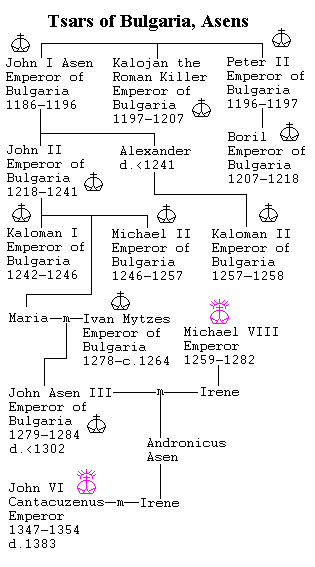
The list of Bulgarian rulers is from various Byzantine sources, including the only source of the genealogy here, which is the Erzählende genealogische Stammtafeln zur europäischen Geschichte, Volume II, Part 2, Europäiche Kaiser-, Königs- und Fürstenhäuser II Nord-, Ost- und Südeuropa [Andreas Thiele, R. G. Fischer Verlag, Part 2, Second Edition, 1997, pp.160-162].
Although John III lost Bulgaria, his descendants figured in affairs in
Constantinople for some time. Since his granddaughter married the Emperor John
VI Cantacuzenus, whose daughter Helena married the Emperor John V, all the
subsequent Palaeologi
are his descendants.
| 3. LATIN EMPERORS AT CONSTANTINOPLE | |
|---|---|
| Baldwin I of Flanders |
1204-1205 |
| Captured by Kalojan Asen, 1205 | |
| Henry of Flanders |
1206-1216 |
| Peter de Courtenay |
1217 |
| Yolanda of Flanders |
1217-1219 |
| Robert I de Courtenay |
1221-1228 |
| John
of Brienne |
1228-1237 |
| Baldwin II | 1228-1261 |
| titular Emperor 1261-1273 | |
| Philip II | titular Emperor 1273-1285 |
| Catherine de Courtenay |
titular Empress 1285-1307 |
| Charles of Valois |
titular Emperor 1301-1313 |
| Catherine of Valois |
titular Empress 1313-1346 |
| Philip II of Tarento |
titular Emperor 1313-1331 |
| Robert II | titular Emperor 1346-1364 |
| Philip III | titular Emperor 1364-1373 |
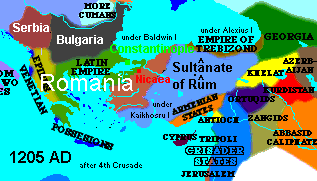 The conquest of Constantinople by the Fourth Crusade did not result
in the establishment of the authority of the Latin Emperors over the whole of
the previous Empire. Greek authority was maintained in three major locations, at
Nicaea, at Trebizond, and in
Epirus, and a
couple of minor locations, at Rhodes, later to fall to Venice, and at the
fortress of Monembasia in the Peloponnesus (Morea), which fell in 1248.
All three major Greek rulers eventually proclaimed themselves emperors, which
means that at one point four rulers were claiming the
The conquest of Constantinople by the Fourth Crusade did not result
in the establishment of the authority of the Latin Emperors over the whole of
the previous Empire. Greek authority was maintained in three major locations, at
Nicaea, at Trebizond, and in
Epirus, and a
couple of minor locations, at Rhodes, later to fall to Venice, and at the
fortress of Monembasia in the Peloponnesus (Morea), which fell in 1248.
All three major Greek rulers eventually proclaimed themselves emperors, which
means that at one point four rulers were claiming the  Imperial dignity within the old Empire -- not to mention the Bulgarian and Serbian Tsars who also
wanted to inherit it. The Emperor at Nicaea was the one to return to Constantinople,
but the Emperor at Trebizond was the last to fall to the Turks.
Imperial dignity within the old Empire -- not to mention the Bulgarian and Serbian Tsars who also
wanted to inherit it. The Emperor at Nicaea was the one to return to Constantinople,
but the Emperor at Trebizond was the last to fall to the Turks.
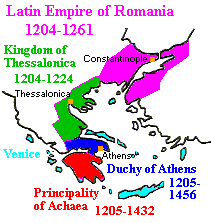 Besides the 3/8 of the whole retained by Venice, including
Adrianople and Gallipoli, the Latin Empire ended up included three significant
feudal dependencies, all subjugated and organized by the leader of the Fourth
Crusade, Boniface the Margrave of Montferrat: the
Kingdom of Thessalonica (1204-1224), with Boniface himself as king, the
Duchy of Athens
(1205-1456), and the Principality of
Achaea (1205-1432). Boniface was denied the Imperial throne by the
Venetian votes, apparently because it was thought that he might make too strong
an Emperor.
Besides the 3/8 of the whole retained by Venice, including
Adrianople and Gallipoli, the Latin Empire ended up included three significant
feudal dependencies, all subjugated and organized by the leader of the Fourth
Crusade, Boniface the Margrave of Montferrat: the
Kingdom of Thessalonica (1204-1224), with Boniface himself as king, the
Duchy of Athens
(1205-1456), and the Principality of
Achaea (1205-1432). Boniface was denied the Imperial throne by the
Venetian votes, apparently because it was thought that he might make too strong
an Emperor.
| Kings of Thessalonica | |
|---|---|
| Boniface of Montferrat |
1204-1207 |
| Demetrius | 1207-1224, d.1230/9 |
| Thessalonica taken by Epirus, 1224 | |
Boniface himself was killed in 1207 and the Kingdom of Thessalonica turned
out to be the most short-lived of the Crusader states in Romania, falling to
Epirus. In 1311 the Duchy of Athens was seized by the Catalan Company, which had
mutinied against the Palaeologi. The Principality of Achaea eventually got mixed
up with the Anjevians
and finally was inherited, much too late, by the Palaeologi in 1432; but the
Duchy of Athens never returned to the control of Greek Romania. It fell
to Meh.med II in 1456.

After the restoration of Greek rule in Constantinople, a claim to the Roman throne passed down through the descendants of Baldwin II. Charles of Anjou, who had his own designs on Romania, married a daughter to Baldwin's son Philip. Later, Charles' grandson Philip married the heiress, Catherine of Valois, of the claim. None of these claimants, however, ever had much of a chance of returning to Constantinople. Many of them, however, were also Princes of Achaea, where their succession and genealogy are given in detail.
The nimbus is not used for the Latin Emperors in the genealogy because, as
Roman Catholics, they would have acknowledged Papal supremacy to a degree that
the Orthodox Emperors in Constantinople never would. Latin Emperors could not be
"Equal to the Apostles."
| 4. DESPOTS OF EPIRUS AND EMPERORS AT THESSALONICA | |
|---|---|
| Michael I Ducas | 1204-1215 |
| Theodore Ducas | 1215-1230 |
| 1227-1230, Emperor in Thessalonica, d.c.1254 | |
| takes Thessalonica,
1224; Defeated & Captured by John II Asen, 1230 | |
| Manuel | 1230-1237, Regent in Thessalonica, d.1241 |
| John | 1237-1242, Emperor in Thessalonica |
| Despot, 1242-1244 | |
| Defeated by John III Ducas Vatatzes, reduced to Despot, 1242 | |
| Demetrius | 1244-1246 |
| Thessalonica falls to John III Ducas Vatatzes, 1246 | |
| Michael II | 1231-1271 |
| Granted title of Despot of Epirus by John III Ducas Vatatzes, 1249 | |
| Nicephorus I | 1271-1296 |
| Thomas | 1296-1318 |
| Nicholas Orsini | 1318-1323 |
| John Orsini | 1323-1335 |
| Nicephorus II | 1335-1337, 1340, & 1355-1359 |
| Epirus absorbed by Andronicus III, 1337, 1340 | |
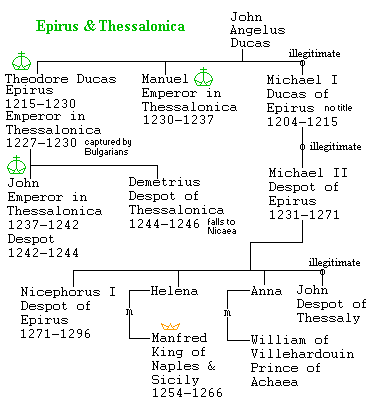

Epirus
itself proved difficult for either Nicaea or the Palaeologi to subdue and rule,
so the despots continued there for a while, continuing under some rulers
unrelated to the Ducases. By the time Andronicus III was able to annex the
territory, the Empire as a whole was too far gone for it to have helped very
much.
| 5. EMPERORS AT TREBIZOND | |
|---|---|
| Alexius I Comnenus | 1204-1222 |
| Andronicus I Gidus | 1222-1235 |
| John I Axuch | 1235-1238 |
| Manuel I | 1238-1263 |
| Andronicus II | 1263-1266 |
| George | 1266-1280 |
| John II | 1280-1297 |
| Alexius II | 1297-1330 |
| Andronicus III | 1330-1332 |
| Manuel II | 1332 |
| Basil | 1332-1340 |
| Irene Palaeologina | 1340-1341 |
| Anna Comnena | 1341, 1341-1342 |
| Michael | 1341, 1344-1349 |
| John III | 1342-1344 |
| Alexius III | 1349-1390 |
| Manuel III | 1390-1416 |
| Alexius IV | 1416-1429 |
| John IV | 1429-1459 |
| David | 1459-1461 |
| Trebizond falls to Meh.med II, 1461 | |
A very poor excuse for an "empire," Trebizond spent much of its existence in vassalage to the Mongols and Turks who ruled the plateau behind it. It started, however, with an heir to the Comneni and a reasonable ambition of moving on to Constantinople. After realistic chances of that past, Trebizond ended up with the dubious honor of being the last of the Greek states to fall to the Ottomans, in 1461.
Lists of the Emperors of Trebizond can be found in various Byzantine histories, but the genealogy here only comes from the Erzählende genealogische Stammtafeln zur europäischen Geschichte, Volume III, Europäiche Kaiser-, Königs- und Fürstenhäuser, Ergänzungsband [Andreas Thiele, R. G. Fischer Verlag, Second Edition, 2001, pp.235-236].

1354
AD
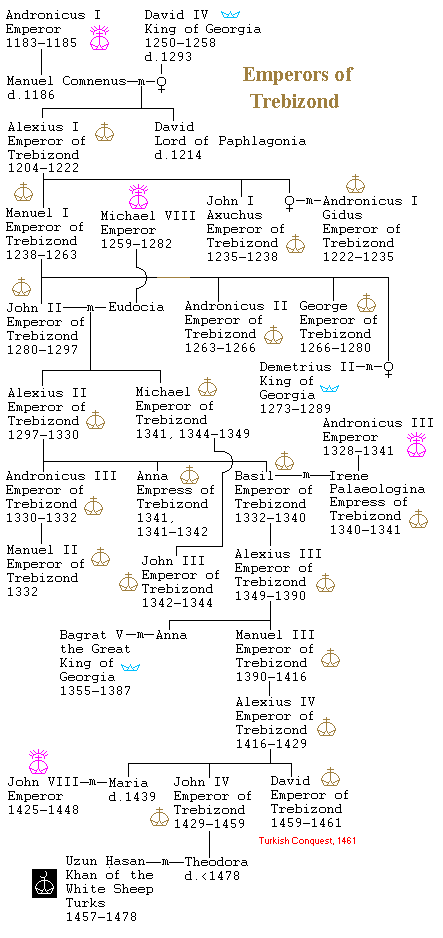
In the genealogy of the Comneni of Trebizond, there are noteworthy marriages
to Kings of Georgia.
There is also the interesting episode of Irene, daughter of Andronicus III Palaeologus, briefly
succeeding her husband Basil as ruling Empress. She was then succeeded by her
sister-in-law Anna. Most extraordinary is a marriage at the end of line. A
daughter, Theodora, of Emperor John IV married Uzun H.asan, a Khan of the White Sheep Turks
(1457-1478), the very Khan who conquered the Black Sheep Turks in 1469 and
created a regional state that stretched from Eastern Anatolia, where the White
Sheep Turks originated, into Eastern Irân. This continued until the Safavids came to power in
1508.
| 6. LASCARIDS, EMPERORS AT NICAEA | |
|---|---|
| Constantine Lascaris |
1204 |
| Theodore I Lascaris |
1206-1222 |
| John III Ducas Vatatzes |
1222-1254 |
| Theodore II | 1254-1258 |
| John IV | 1258-1261 |
C. THE LAST DAYS, 1261-1453, 192 years
| 1. SERBIA | |
|---|---|
| Tichomir | Great Prince, 1168-1169 |
| Stephan I Nemanja | 1169-1196, d.1200 |
| Serbia independent, 1180 | |
| Stephan II the First-Crowned |
1196-1217 |
| King of Serbia, 1217-1228 | |
| Stephan III Radoslav | 1228-1234 |
| Stephan IV Vladislav | 1234-1243 |
| Stephan Urosh I | 1243-1276 |
| Stephan Dragutin | 1276-1282 |
| Stephan Urosh II Milutin |
1282-1321 |
| Stephan Urosh III Dechanski |
1321-1331 |
| Stephen Urosh IV Dushan |
1331-1345 |
| Tsar of the Serbs and the Romans, 1345-1355 | |
| Stephen Urosh V the Weak |
1355-1371 |
| defeat by Murâd I at Crnomen, 1371; collapse of dynasty & authority | |
| Stephan Lazar I | Prince, 1371-1389 |
| battle of Kosovo, "Field of the Blackbirds," defeat by Murâd I, 1389 | |
| Stephan Lazar II Lazarevich |
Despot, 1389-1427 |
| Turkish vassal, 1396 | |
| George Brankovich | 1427-1456 |
| Lazar III Brankovich | 1456-1458 |
| Helene Palaeologina | Regent, 1458-1459, d.1473 |
| annexed by Turkey, 1459 | |
 The Golden Age of Serbia. Independence from Romania and then the
passing of the most vigorous days of Bulgaria meant an opportunity for a Serbian
bid for the Imperium.
The Golden Age of Serbia. Independence from Romania and then the
passing of the most vigorous days of Bulgaria meant an opportunity for a Serbian
bid for the Imperium.
This opportunity was seized by Stephan Dushan, who ended up with most of the western Balkans and was crowned Tsar of the Serbs and Romans by the autocephalous Serbian Patriarch whom he had just installed (1346) at Pec. His long reign, however, was not quite long enough, and his death set off the kind of internal dissentions that had ruined many another state in Romania.

Then, all too soon, the Ottomans arrived. Defeats in 1371 and 1389 crushed Serbia. The agony of the Battle of Kosovo in 1389, the "Field of the Blackbirds," still echoes today in the fierceness of the attachment of modern Serbs for the area, now largely populated by Albanians. As it happened, the Sult.ân Murâd I died at Kosovo, but his son, Bâyezîd the "Thunderbolt," was, if anything, even more vigorous than his father. In 1396 Bâyezîd destroyed a Crusade, led by the King of Hungary and future Emperor Sigismund, at Nicopolis (Nikopol). Not even Bâyezîd's defeat and capture by Tamerlane (1402) revived Serbian prospects.
Lists of Serbian rulers can be found in various Byzantine histories, but the
genealogy here only comes from the Erzählende genealogische Stammtafeln zur
europäischen Geschichte, Volume II, Part 2, Europäiche Kaiser-, Königs-
und Fürstenhäuser II Nord-, Ost- und Südeuropa [Andreas Thiele, R. G.
Fischer Verlag, Part 2, Second Edition, 1997, pp.143-149].

The dynasty of Stephan Dushan is followed by two families of princes. Stephen
Lazar and his son endured the Turkish defeat and conquest and were reduced to
despots. They were followed by the Bronkoviches, father and son. The wife of
Lazar III Brankovich, Helene, was a daughter of Thomas Palaeologus (d.1465),
Despot of the Morea and brother of the last Roman Emperor, Constantine XI. After the
death of Lazar, Helene was Regent of Serbia until the Turkish annexation.
| 3. BULGARIA, TERTERS | |
|---|---|
| George I Terter |
1280-1292, d.c.1304 |
| Mongol vassal, 1285 | |
| Smilech | 1292-1295/8 |
| Caka/Tshaka | 1295/8-1298/9 |
| Theodore Svetoslav |
1298/9-1322 |
| George II | 1322-1323 |
| SHISHMANS | |
| Michael III Shishman |
1323-1330 |
| John IV Stephan |
1330-1331 |
| John V Alexander |
1331-1371 |
| John Sracimir | 1355-1371, d.1396 |
| John VI Shishman |
1360-1393, d.1395 |
| disintegration of state, 1385; Ottoman vassalage, 1387, 1388, Conquest, 1396 | |
 The second Bulgarian dynasty of the period was always at a
disadvantage, ground between the Mongols, Serbs, Hungary, and the Ottomans.
The second Bulgarian dynasty of the period was always at a
disadvantage, ground between the Mongols, Serbs, Hungary, and the Ottomans. conquest and annexation came in the same year (1396) as the Sult.ân
Bâyezîd's defeat of a Crusade, led by the King of Hungary and future Emperor Sigismund, at
Nicopolis (Nikopol), where John Sracimir was killed.
conquest and annexation came in the same year (1396) as the Sult.ân
Bâyezîd's defeat of a Crusade, led by the King of Hungary and future Emperor Sigismund, at
Nicopolis (Nikopol), where John Sracimir was killed.
Over time, the Turks clearly regarded Bulgaria as strategically more important than Serbia or the Romanian principalities, and no local autonomy was allowed at all until the Russo-Turkish War of 1876-1878 and the Congress of Berlin (1878) forced it. Even then Bulgaria was divided and full independence did not come until 1908. Meanwhile, a fair number of Bulgarians had converted to Islâm. Since they were regarded as traitors by Christian Bulgarians, many of them migrated to Turkey, where they still live.
The list of Bulgarian rulers is from various Byzantine sources, including the
only source of the genealogy here, which is the Erzählende genealogische
Stammtafeln zur europäischen Geschichte, Volume II, Part 2, Europäiche
Kaiser-, Königs- und Fürstenhäuser II Nord-, Ost- und Südeuropa [Andreas
Thiele, R. G. Fischer Verlag, Part 2, Second Edition, 1997, pp.162-163].
| 5. PALAEOLOGI | |
|---|---|
| Michael VIII Palaeologus | 1259-1282 |
| Prince of Achaea captured, 1259; Restoration of Greek rule in Constantinople, 1261; Laconia & Monembasia (soon Despotate of Morea) ceded as ransom for the Prince of Achaea, 1261; Genoese granted Galata, 1267; Anjevians defeated, 1281; the Sicilian Vespers, 30 March 1282 -- Sicily revolts against & massacres the French; end of Anjevian threat | |
| Andronicus II | 1282-1328 |
| reduction of army & navy; Venetians mint Ducats after Roman debasement, 1284; defeat by Amir 'Osmân at Bapheus near Nicomedia, Ottoman conquest begins, 1302; Catalan Company hired, 1303, revolts, 1305; Ephesus lost to Beg of Aydïn, 1304; Knights of the Hospital of St. John of Jerusalem, the Hospitalers, on Rhodes, 1308-1523; Prusa [Bursa] lost, 1326 | |
| Michael IX | heir of Andronicus, 1295-1320 |
| Andronicus III | 1321-1341 |
| defeat by Orkhân, 1329; Nicaea [I.znik] lost, 1331; Nicomedia [I.zmid] lost, 1337; Epirus annexed, 1337, 1340 | |
| John V | 1341-1376, 1379-1391 |
Umur
I, Beg of Aydïn & ally of John Cantacuzenus, defeated by Venice
& Romania, looses harbor of Smyrna, 1344; Grand Duke of Moscow
contributes money to repair St. Sophia, 1346; Black Death arrives at Constantinople,
1347 1346; Black Death arrives at Constantinople,
1347 | |
| John VI Cantacuzenus | regent, 1341 |
| 1341-1354, abdicated | |
| Civil War, 1341-1347; Crown Jewels pawned to Venice, 1343; Bubonic Plague, 1347; revenue of Galata seven times that of Constantinople, 1348; Genoese from Galata burn Roman shipyard, 1348; War between Venice & Genoa, 1350-1355; Kallipolis [Gelibolu] lost, 1354, Ottoman foothold in Europe; John V visits Hungary, first Emperor to visit a foreign court, 1365; Adrianople [Edirne] lost, 1369; John goes to Rome & Venice, 1369-1371; Empire Vassal of Murâd I | |
| Andronicus IV | 1376-1379; heir, 1381-1385 |
| Thessalonica lost, 1387 | |
| Manuel Cantacuzenus, Despot of Morea | 1348-1380 |
| Matthew Cantacuzenus, Despot of Morea | 1354-1383 |
| 1380-1383 | |
| Demetrius Cantacuzenus, Despot of Morea | 1383 |
| John VII | 1390, flees to Bâyezîd I; regent, 1399-1403 |
| Philadelphia lost, 1390 | |
| Theodore I Palaeologus, Despot of Morea | 1383-1407 |
| Manuel II | 1391-1425 |
| Russian Church stops mention of Emperor, 1392; Ottoman vassalage repudiated, 1394; siege of Constantinople, 1394-1402; Battle of Nicopolis, Sigismund of Hungary defeated by Bâyezîd I, 1396; Emperor travels to Italy, France, England, 1400-1403; Thessalonica returned, 1403, ceded to Venice, 1423; Siege of Constantinople by Murad II, 1422 | |
| Theodore II Palaeologus, Despot of Morea | 1407-1443 |
| John VIII | 1425-1448 |
| attends the Church Council at Ferrara & Florence, 1439-1440; Crusade of Varna, defeated, Vadislav of Hungary & Poland killed, 1444 | |
| Constantine XI Dragases | Despot of Morea 1428-1449 |
| 1449-1453 | |
| Constantinople [I.stanbul] falls to Meh.med II, 1453 | |
| Thomas, Despot of Morea | 1428-1460 |
| Principality of Achaea inherited, 1432; Mistra, Morea, falls to Meh.med II, 1460; last piece of Romania, the fortress of Monembasia, ceded to the Pope, 1461; daughter Zoë marries Ivan III of Russia | |

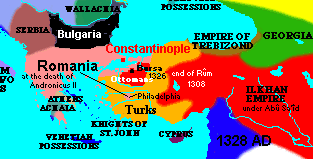


 there were 14th century banners that would have evolved into a
proper flag for Romania, given the chance. We find a field with a Cross, like
many Crusader banners and flags, with the addition of curious devices, which
look like images and mirror-images of something between the letter B, the
letter E, and broken links of a chain. These are sometimes said to have
already been used by Constantine I and have
been variously interpreted. One possibility is that they are stylized forms of
Crescent Moons, originally symbolic of the divine patroness of Byzantium,
the goddess Artemis. The stylized forms have been inherited in the arms of
there were 14th century banners that would have evolved into a
proper flag for Romania, given the chance. We find a field with a Cross, like
many Crusader banners and flags, with the addition of curious devices, which
look like images and mirror-images of something between the letter B, the
letter E, and broken links of a chain. These are sometimes said to have
already been used by Constantine I and have
been variously interpreted. One possibility is that they are stylized forms of
Crescent Moons, originally symbolic of the divine patroness of Byzantium,
the goddess Artemis. The stylized forms have been inherited in the arms of  Serbia, and crescents are used as a Serb national
symbol, seen at left -- something that has probably become a sign of terror to
non-Serbs in Croatia, Bosnia, and Kosovo. If it was the Crescent that was
originally used in Constantinople,
Serbia, and crescents are used as a Serb national
symbol, seen at left -- something that has probably become a sign of terror to
non-Serbs in Croatia, Bosnia, and Kosovo. If it was the Crescent that was
originally used in Constantinople,  this may have been directly inherited by Turkey. A Crescent is now
commonly taken as symbolic of Islâm, but this may not antedate the
Turkish flag. The star on the Turkish flag is sometimes said to be Romanian
also, symbolizing the Virgin Mary, but it does not occur on the earliest Turkish
flags. However, Whitney Smith
this may have been directly inherited by Turkey. A Crescent is now
commonly taken as symbolic of Islâm, but this may not antedate the
Turkish flag. The star on the Turkish flag is sometimes said to be Romanian
also, symbolizing the Virgin Mary, but it does not occur on the earliest Turkish
flags. However, Whitney Smith  [Flags Through the Ages and Across the World, McGraw-Hill,
1975] shows a flag identified only as "medieval Russian" that shows a cross with
four crescents and four stars also (p. 174). The crescents are oriented
differently, but this design seems too elaborate not to have Roman antecedents.
The
[Flags Through the Ages and Across the World, McGraw-Hill,
1975] shows a flag identified only as "medieval Russian" that shows a cross with
four crescents and four stars also (p. 174). The crescents are oriented
differently, but this design seems too elaborate not to have Roman antecedents.
The  double headed Eagle is also a Romanian device, said to have
been introduced by Michael
VIII Palaeologus, with the two heads looking towards the Anatolian and
European halves of the Empire, as the Emperor did from Constantinople. Or,
Donald M. Nicol [Byzantium and Venice, a Study in Diplomatic and Cultural
Relations, Cambridge University Press, 1999, p. 249] says, it was adopted by
Andronicus II to symbolize the division of authority with his grandson,
Andronicus III -- though it far outlasted that particular division. Eagles were
used by many to imply Roman antecedents, but the double headed eagle was adopted
in particular by the Holy
Roman Empire, by Imperial Russia, and by the Serbs. It also occurred on
the flag used by George Castriota, or Skanderbeg, when he drove the Turks
out of Albania, between 1443 and 1463. Thus, when Albania became independent
from Turkey, Skanderbeg's flag was revived.
double headed Eagle is also a Romanian device, said to have
been introduced by Michael
VIII Palaeologus, with the two heads looking towards the Anatolian and
European halves of the Empire, as the Emperor did from Constantinople. Or,
Donald M. Nicol [Byzantium and Venice, a Study in Diplomatic and Cultural
Relations, Cambridge University Press, 1999, p. 249] says, it was adopted by
Andronicus II to symbolize the division of authority with his grandson,
Andronicus III -- though it far outlasted that particular division. Eagles were
used by many to imply Roman antecedents, but the double headed eagle was adopted
in particular by the Holy
Roman Empire, by Imperial Russia, and by the Serbs. It also occurred on
the flag used by George Castriota, or Skanderbeg, when he drove the Turks
out of Albania, between 1443 and 1463. Thus, when Albania became independent
from Turkey, Skanderbeg's flag was revived. 
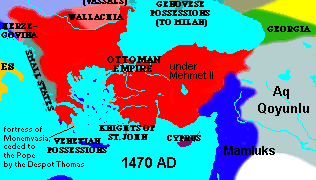
The Fall of Constantinople, on May 29, 1453, is one of the most formative,
epochal, colorful, and dramatic episodes in world history. As the final end of
the Roman Empire, it was a much more revolutionary and catastrophic change than
the "fall" of the Western Empire in 476, in which power remained in the same
hands of the current magister militum. That the greatest Christian city
of the Middle Ages should pass to Islâm held a symbolism that was lost on none.
But the defenders had little active help from a Europe that four hundred years
earlier had launched armies all the way to Jerusalem. The most active help was
from an unofficial Italian contingent from Genoa, led by the
accomplished soldier Giovanni Giustiniani Longo. Giustiniani was perhaps
militarily the most effective leader of the defense. When he was wounded and
left the walls, one is then not surprised to learn that the city fell on that
day. As the last Emperor's name, Constantine XI, recalls the founder of the
city, Giustiniani's name echoes the Emperor, Justinian, who recovered Genoa
itself from the Ostrogoths. But it was only the introduction of cannon that made
the breach in the Long Walls possible at all.
 Because of all that it is a little puzzling that there has never
been, to my knowledge, a Hollywood movie about the event. This may have been in
great measure because of the scale of the location. The Theodosian Land Walls of
Constantinople are 6.5 kilometers long, almost 4 miles. Since the ruins of the
walls could not be used, and the whole length could not be built (as the whole
Alamo was build by John Wayne for The Alamo), it would have been
necessary to use models, which, with the older technology, would have looked
very cheesy. Models now, however, can look much, much better -- the models for
Lord of the Rings (2001) even came to be called "big-atures" instead of
"miniatures" they were so large; and even better than that, shots can be done
digitally. This would also work for the other problem, which would be showing
the general situation of the city between the Sea of Marmara, the Bosporus, and
the Golden Horn. A live shot of the modern buildings would not help. Now,
however, the whole thing could be done digitally, or live shots could be
digitalized and edited, to remove modern buildings and render mediaeval ones.
This would also help with scenes in Sancta Sophia. The movie
would have to show church services there, but my understanding is that these are
not allowed in the modern building, even though it is now a secularized museum
rather than the mosque it became at the Conquest (there is a small Islamic
chapel, but not a Christian one). No problem. All we need is a photograph, and
Industrial Light and Magic can put Constantine XI and the whole gang right into
it with all the paraphernalia of the Greek Orthodox Church. Even so, it is
questionable how interested Hollywood will ever be, even after Gladiator,
and even when the legendary material, like the Virgin Mary retrieving her Icon,
or the various versions of the death of Constantine, simply cry out for
cinematic representation. With the present conflicts involving Islâm, some might consider
the whole topic inflammatory; and it is very possible that Turkey would not
allow location filming for such a movie.
Because of all that it is a little puzzling that there has never
been, to my knowledge, a Hollywood movie about the event. This may have been in
great measure because of the scale of the location. The Theodosian Land Walls of
Constantinople are 6.5 kilometers long, almost 4 miles. Since the ruins of the
walls could not be used, and the whole length could not be built (as the whole
Alamo was build by John Wayne for The Alamo), it would have been
necessary to use models, which, with the older technology, would have looked
very cheesy. Models now, however, can look much, much better -- the models for
Lord of the Rings (2001) even came to be called "big-atures" instead of
"miniatures" they were so large; and even better than that, shots can be done
digitally. This would also work for the other problem, which would be showing
the general situation of the city between the Sea of Marmara, the Bosporus, and
the Golden Horn. A live shot of the modern buildings would not help. Now,
however, the whole thing could be done digitally, or live shots could be
digitalized and edited, to remove modern buildings and render mediaeval ones.
This would also help with scenes in Sancta Sophia. The movie
would have to show church services there, but my understanding is that these are
not allowed in the modern building, even though it is now a secularized museum
rather than the mosque it became at the Conquest (there is a small Islamic
chapel, but not a Christian one). No problem. All we need is a photograph, and
Industrial Light and Magic can put Constantine XI and the whole gang right into
it with all the paraphernalia of the Greek Orthodox Church. Even so, it is
questionable how interested Hollywood will ever be, even after Gladiator,
and even when the legendary material, like the Virgin Mary retrieving her Icon,
or the various versions of the death of Constantine, simply cry out for
cinematic representation. With the present conflicts involving Islâm, some might consider
the whole topic inflammatory; and it is very possible that Turkey would not
allow location filming for such a movie.
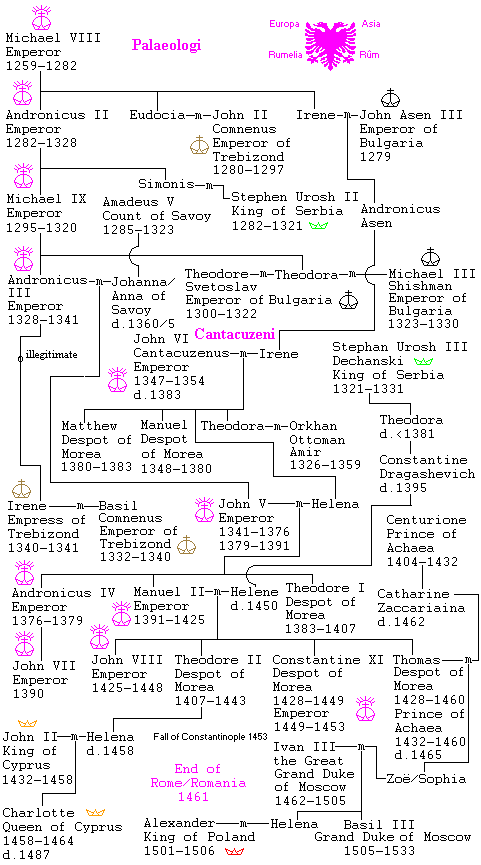 The surname Palaeologus survives today, but it is not clear that any
modern Palaeologi are descendants of the Imperial family. In the genealogy, we
see considerable intermarriage outside the Empire, even to Tsars of Bulgaria.
The marriage of Zoë-Sophia to Ivan III of Moscow is the one most filled with
portent, but the last Russian Tsar to be their
descendant was Theodore I (1584-1598).
The surname Palaeologus survives today, but it is not clear that any
modern Palaeologi are descendants of the Imperial family. In the genealogy, we
see considerable intermarriage outside the Empire, even to Tsars of Bulgaria.
The marriage of Zoë-Sophia to Ivan III of Moscow is the one most filled with
portent, but the last Russian Tsar to be their
descendant was Theodore I (1584-1598).
John Julius Norwich (Byzantium, The Decline and Fall, Knopf, 1996,
pp.447-448) notes that there is buried in St. Leonard's church in Landulph,
Cornwall, England a "Theodore Paleologus" (d.1636) from Italy, who is said to
have been a direct descendant of John, son of Thomas, Despot of the Morea.
However, Thomas is not known to have had a son John, and so the claim of
descent, regardless of any other merits, is questionable. Theodore had a son
Ferdinand, who died in Barbados in 1678. Ferdinand had a son "Theodorious," who
returned to England and died in 1693, leaving a daughter, "Godscall," whose fate
is unknown.
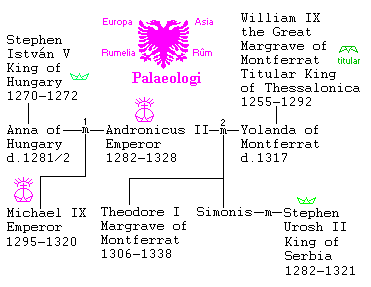 What John Norwich seems to have missed is that there were undoubted
lines of Palaeologi (Paleologhi) in Italy, descended from the Emperor
Andronicus II, whose second wife was Yolanda, the Heiress of the Margraves of
Montferrat. While Andronicus's eldest son succeeded in Constantinople, his son
by Yolanda, Theodore, succeeded to Montferrat. The main line of the Palaeologi
of Montferrat
continued until the death of the Marchioness Margaret in 1556. But branch lines
continued much longer, perhaps even to the 20th century. This is covered in the
Erzählende genealogische Stammtafeln zur europäischen Geschichte, Volume
II, Part 2, Europäiche Kaiser-, Königs- und Fürstenhäuser II Nord-, Ost- und
Südeuropa [Andreas Thiele, R. G. Fischer Verlag, Part 2, Second Edition,
1997, pp.260-261], which, however, only indicates that the lines continue after
the 16th century. The Theodore buried in Cornwall could very well have simply
gotten confused about his genealogy. He might have been a genuine
Paleologo from Italy.
What John Norwich seems to have missed is that there were undoubted
lines of Palaeologi (Paleologhi) in Italy, descended from the Emperor
Andronicus II, whose second wife was Yolanda, the Heiress of the Margraves of
Montferrat. While Andronicus's eldest son succeeded in Constantinople, his son
by Yolanda, Theodore, succeeded to Montferrat. The main line of the Palaeologi
of Montferrat
continued until the death of the Marchioness Margaret in 1556. But branch lines
continued much longer, perhaps even to the 20th century. This is covered in the
Erzählende genealogische Stammtafeln zur europäischen Geschichte, Volume
II, Part 2, Europäiche Kaiser-, Königs- und Fürstenhäuser II Nord-, Ost- und
Südeuropa [Andreas Thiele, R. G. Fischer Verlag, Part 2, Second Edition,
1997, pp.260-261], which, however, only indicates that the lines continue after
the 16th century. The Theodore buried in Cornwall could very well have simply
gotten confused about his genealogy. He might have been a genuine
Paleologo from Italy.
While there may or may not be surviving Imperial Palaeologi, Constantine XI
lives on in legend. When the Turks had manifestly broken through and the Fall of
the City imminent, the Emperor reportedly threw off the Imperial Regalia and
disappeared into the thick of the fight. There is no doubt that he died. A body
was later identified and a head displayed, but some doubt remains about the
identification. A story arose that Constantine sleeps under the Golden
Gate (like Barbarossa under the
Kyffhäuser), or that he would reenter the City through that Gate. Generations of
Turkish government took these stories with sufficient seriousness that the
Golden Gate remains bricked up to this very day.
| 6. ROMANIANS | |||
|---|---|---|---|
| WALLACHIA | MOLDAVIA | ||
| Tihomir | c.1290-1310 | ||
| Ioan Basarab I | Voivode, Prince 1317-1352 | ||
| Nicholas Alexander | 1352-1364 | Dragosh | Voivode, Prince 1352-1353 |
| Sas | 1354-1358 | ||
| Balc | 1359 | ||
| Bogdan I the Founder |
Prince 1359-1365 | ||
| Vladislav I Vlaicu | 1364-1377 | Latcu | 1365-1373 |
| Costea | 1373-1375 | ||
| Radu I | 1377-1383 | Petru I al Mushatei |
1375-1391 |
| Dan I | 1383-1386 | ||
| Mircea the Old | 1386-1418 | Roman I | 1391-1394 |
| Stephen I | 1394-1399 | ||
| Vlad I | part, 1394-1397 |
Ologul (Iuga) | 1399-1400 |
| Michael I | 1418-1420 | Alexander the Good |
1400-1432 |
| Dan II | 1420-1431 | Ilias, Elias | 1432-1433, 1435-1442 |
| Radu II the Poor | 1421, 1423, & 1447 | ||
| Alexander I | 1431-1436 | ||
| Vlad II Dracul | 1436-1442, 1443, 1447 |
Stephen II | 1433-1447 |
| Mircea | 1442 | Petru II | 1444-1445, 1447, 1448-1449 |
| Basarab II | 1442-1443 | Roman II | 1447-1448 |
| Iancu de Hunedoara (János Hunyadi) |
Prince of Transylvania, 1441-1456 |
Ciubar | 1448-1449 |
| Regent of Hungary, 1446-1456 | |||
| 1447 | |||
| Vladslav II | 1447-1448, 1448-1456 |
Alexandrel | 1449, 1452-1454, 1455 |
| Bogdan II | 1449-1451 | ||
| Vlad III Tepesh, the Impaler |
1448, 1456-1462, 1476 |
Petru Aron | 1451-1452, 1454-1455, 1455-1457, d.1469 |
| Radu I cel Frumos | 1462-1475 | Stephen III the Great |
1457-1504 |
| Basarab Laiota | 1473, 1474-1475, 1476-1477 | ||
| Basarab Tepelush | 1477-1481, 1481-1482 | ||
| Vlad Calugarul | 1481, 1482-1495 | ||
| Radu II cel Mare, the Great |
1495-1508 | Bodgan III the Blind |
1504-1517 |
| Mihnea cel Rau | 1508-1509, d.1510 | ||
| Mircea | 1509-1510 | ||
| Vlad cel Tinar | 1510-1512 | ||
| Neagoe Basarab | 1512-1521 | Shtefanita | 1517-1527 |
| Teodosie | 1521 | ||
| Vlad (Dragomir Calugarul) |
1521, d.1522 | ||
| Radu III de la Afumati |
1522-1523, 1524, 1524-1525, 1525-1529 | ||
| Valdislav III | 1523, 1524, 1525 | ||
| Radu IV Badica | 1523-1524 | Petru Raresh | 1527-1538, 1541-1546 |
| Moise | 1529-1530 | Ottoman Conquest, 1538 | |
| Vlad Înecatul | 1530-1532 | Ilias, Elias | 1546-1551, 1562 |
| Vlad Vintila | 1532-1535 | Stephen IV | 1551-1552 |
| Radu Paisie | 1535-1545 | Ioan Joldea | 1552 |
| Mircea Ciobanul | 1545-1552, 1553-1554, 1558-1559 |
Alexandru Lapushneanu |
1552-1561, 1564-1568, 1568 |
| Radu Ilie | 1552-1553 | Despot Voda (Iacob Basilikos Heraklides/Eraclid) |
1561-1563 |
| Patrascu cel Bun (the Kind) |
1554-1557 | Sephen Tomsha | 1563-1564 |
| Petru cel Tinar | 1559-1568, d.1569 |
Bogdan Laprushneanu |
1568-1572 |
| Alexander II | 1568-1574, 1574-1577 |
Ion Voda (John the Terrible) |
1572-1574 |
| Vintila | 1574 | Petru Schiopul (the Lame) |
1574-1577, 1578-1579, 1582-1591, 1594 |
| Mihnea Turcitul | 1577-1583, 1585-1591, d.1601 |
Ioan Potcoava | 1577 |
| Petru Cercel | 1583-1585, d.1590 |
Iancu Sasul | 1579-1582 |
| Stephen Surdul | 1591-1592 | Aron the Terrible | 1592-1595, d.1597 |
| Alexander cel Rau | 1592-1593 | Stefan Razvan | 1595 |
| Ieremia Moghila | 1595-1600 | ||
| 1593-1601 | Michael II the Brave | 1600, d.1601 | |
| Radu VII (IV) Serban |
1601-1611 | Ottoman Control, 1600 | |
| Ottoman Control,
1611; Lines of Princes Continued | |||
The Principalities of Wallachia and Moldavia are the first Vlach/Romanian states that we see north of the Danube. They appear in the period after incursions from nomadic Steppe empires ceased. They were never subject to the Roman Emperors in Constantinople, and they occupied territories that had been abandoned by the Roman Empire in the Third Century, or never occupied by it in the first place. The arrival of the Turks subjected them to Ottoman suzerainty, but this was of varying rigor. The lines of Princes continued, but by 1711 the Sult.ân began to sell the seats to Greek tax farmers, a destructive practice that continued until 1821.
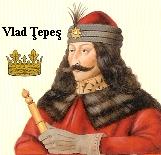
The most famous person in these lines is certainly Prince Vlad the
Impaler of Wallachia. In legend and horror, one might almost say romance,
this cruel man has grown into the paradigmatic vampire, Count Dracula,
though his home has been slightly relocated, from Wallachia to Transylvania and the
Carpathian Mountains (between Transylvania and Moldavia). Until recently, I was
under the impression that Prince Vlad Dracul (1436-1442, 1443, 1447) was Vlad
the Impaler. However, a Romanian correspondent has pointed out that Prince Vlad
the Impaler was not Vlad Dracul but instead Prince Vlad T,epesh
(1448, 1456-1462, 1476, also "Vlad Draculea"), his son. This seems to be the
case, and I have corrected the table accordingly. This correspondent also
pointed out the interesting career of Iancu de Hunedoara (János Hunyadi) as
Prince of Transylvania and Regent of Hungary, for which links have been
installed.
The title of these rulers was Voivode, a word that we even find in Bram Stoker (Dracula, Penguin Books, 1897, 1993, p.309). This term no longer appears in convenient Romanian or Hungarian dictionaries, for any of its meanings (c.f. NTC's Romanian and English Dictonary, Andreí Bantas, NTC Publishing Group, 1995; Hippocrene Concise Dictionary, Hungarian, Hungarian-English, English-Hungarian, Géza Takács, Hippocrene Books, 1996; or Hippocrene Standard Dictionary, English-Hungarian Dictionary, T. Magay & L. Kiss, Hippocrene Books, 1995). Those meanings began with "duke" or "prince" and ultimately declined to merely "governor," which would have been appropriate to Wallachia or Moldavia under the Turks. This word is actually of Slavic origin, and is thus discussed under Eastern Europe.
The Vlach language of the Principalities, not a written language in the
Middle Ages, came to be written in the Cyrillic alphabet . The unified country itself became first "Roumania," later further
Latinized into "România," and soon the Cyrillic alphabet was traded in for the
Latin alphabet, as the Roman roots of the people were increasingly emphasized.
In contrast to the original Romania, i.e. the Roman Empire, the
north-of-the-Danube state might usefully be characterized as "Lesser Romania,"
on analogy to "Lesser
Armenia" in the Taurus; but this would probably be considered insulting by
modern Romanians. Perhaps "Later Romania" would be better, like the Later Han Dynasty -- making
the Empire into the "Former Romania," like the Former Han Dynasty. The issue
of România and the Vlach language and people is discussed further in "The Vlach Connection and Further
Reflections on Roman History."
. The unified country itself became first "Roumania," later further
Latinized into "România," and soon the Cyrillic alphabet was traded in for the
Latin alphabet, as the Roman roots of the people were increasingly emphasized.
In contrast to the original Romania, i.e. the Roman Empire, the
north-of-the-Danube state might usefully be characterized as "Lesser Romania,"
on analogy to "Lesser
Armenia" in the Taurus; but this would probably be considered insulting by
modern Romanians. Perhaps "Later Romania" would be better, like the Later Han Dynasty -- making
the Empire into the "Former Romania," like the Former Han Dynasty. The issue
of România and the Vlach language and people is discussed further in "The Vlach Connection and Further
Reflections on Roman History."
The list of Princes here was originally taken from Kingdoms of Europe, by Gene Gurney [Crown Publishers, New York, 1982]. Gurney left many gaps, but it was a long time before I could do better. Now I have updated the list from the Regentenlisten und Stammtafeln zur Geschichte Europas, by Michael F. Feldkamp [Philipp Reclam, Stuttgart, 2002, pp.142-144 & 259-261]. Feldkamp gives very detailed information but unfortunately only until 1601. Subsequent Princes are thus only from Gurney.
 Rome and Romania is continued in The Ottoman Sultans, 1290-1924 AD,
Successors of Rome:
Germania, 395-774, Successors of Rome: Francia,
447-present, Successors of
Rome: The Periphery of Francia, and Successors of Rome: Russia,
862-present.
Rome and Romania is continued in The Ottoman Sultans, 1290-1924 AD,
Successors of Rome:
Germania, 395-774, Successors of Rome: Francia,
447-present, Successors of
Rome: The Periphery of Francia, and Successors of Rome: Russia,
862-present.
Bede identifies several Emperors by number. This includes Claudius, #4, Marcus Aurelius, #14, Diocletian, #33, Gratian, #40, Arcadius, #43, Honorius, #44, Theodosius II, #45, Marcian, #46, and Maurice, #54. This numbering works if we eliminate three of the four Emperors of 69 AD, the ephemeral Emperors of 193 and 218, a couple of them from the Third Century, most of the Tetrarchy and Constantian coregents, and, most importantly, all of the Western Emperors after Honorius. The latter is especially striking because Bede mentions Valentinian III: "In the year of our Lord 449, Marcian became Emperor with Valentinian and fourty-sixth successor to Augustus" [Bede, A History of the English Church and People, Penguin Classics, translated by Leo Sherley-Price, 1955, 1964, p.55]. Since Theodosius II was already identified as the 45th Emperor, there is no number left for Valentinian (Emperor since 425), let alone Constantius III or John, who had been legitimate Emperors of the West. From Marcian to Maurice, the numbers only work if we then ignore all the rest of the Western Emperors, out of nine of which four were even recognized by the East. So Bede doesn't recognize any.
Although writing in the 7th and 8th centuries (673-735), in the days of multiple Anglo-Saxon kingdoms in Britain, Bede nevertheless had a strong sense of the continued existence of the Roman Empire. He knows that the Empire is now centered in Christian Constantinople, and his awareness of this is strong enough that it actually erases the existence of the last Western Emperors. The idea common now that the Roman Empire fell in 476, wouldn't have made sense to Bede. He didn't even recognize the Emperor who "fell," Romulus Augustulus, as a successor of Augustus (neither did the East, for that matter). Ephemeral and puppet Emperors (whether in the 2nd or 5th centuries) don't make the cut in his reckoning. This is of a piece with most of the rest of Mediaeval opinion and perception, East and West. Since the Schism of 1054 between the Latin and the Greek Churches had not occurred yet, Bede would have seen the contemporary Emperor (a late Heraclian, mostly) invested with all the aura and authority of Constantine the Great.
The 2004 movie King Arthur uses some of Littleton and Malcor's information to rework the Arthur legend into something like real history. However, its use of it, and of other history, although meriting an A for effort, involves some confusions and anachronisms. In the movie, the Iazyges are called "Sarmatians," which they were, but the more general name obscures the unique experience of the Iazyges in being settled and assimilated as Roman soldiers. Indeed, that circumstance is ignored, as the movie shows the Sarmatians apparently still living out on the steppe (in yurts) and somehow still obliged in the 5th century to furnish draftees to the Roman army. The Romans, however, were never in any position to send press gangs out onto the steppe, and such a foray in the 5th century, through Germans and Huns, is unbelievable. Nor is there any reason why Sarmatians well beyond Roman borders should pay any attention to obligations assumed three centuries previously. But the plot of the movie requires that the Saramatians feel exiled during their service in Britain. Instead, the Iazyges, men, women, and children, would have all been settled in Britain; and by the fourth century they would have felt as Roman and/or British as anyone. The yearning of Arthur's men to go home is thus a purely fictional device. That Arthur himself still bears the name of Artorius Castus, his ancestor, is a fictional device also, but actually a rather clever and not impossible one.
The background offered in the movie about Sarmatian service in the Roman army leaves out that this involved the war fought by Marcus Aurelius featured in the movie Gladiator. A tribute to Gladiator might have been made but isn't. Instead, we get a gross anachronism, as the shields of what would have been Marcus's army in 175 AD already bear the Chi-Rho symbol of Constantine's Christianity. This may have just been a matter of economy in the prop department, where all the shields were prepared for the 5th century army. However, even this was a mistake, since we know from the Notitia Dignitatum that there were a great many designs used on Roman shields in the Christian Empire, including, remarkably, the first attested instance of the Chinese swirling Yin-Yang symbol. Shields were unique and distinctive to the units.
Beyond this, almost all the history in the movie is confused. The Western Emperor is not even mentioned, and the Pope is portrayed as directing political and military events. This is what Mediaeval Popes wanted to do, but it has nothing to do with the 5th or 6th centuries, when the Popes had no such power and would not have imagined that they did. Actual Italian Romans are portrayed unpleasantly, which creates a distinction (and a conflict) that wouldn't have existed in Late Antiquity. In general, Romans were Romans -- the movie perpetuates the idea that "Rome" meant the City, when this limitation was long gone. More importantly, the Romans never deliberately withdrew from Britain, and certainly not as late or as callously as shown in the movie. The usurper Constantine (407-411) stripped Britain of legions in order to invade Gaul and seize the Throne. When he was defeated, Honorius had to inform the British that, with the Suevi, Vandals, and Alans raging across Gaul and Spain, the forces simply did not exist to re-garrison Britain. Since the battle of Badon Hill is supposed to have happened eighty to a hundred years later, there is a fair bit of history that the movie reduces, in effect, to a couple of days. Finally, we have Saxons so confused or foolish as to land in Britain north of Hadrian's Wall. This would not have done them much good (as is obvious in the movie) and was way, way out of their way. The Saxons, Angles, and Jutes all crossed the North Sea and landed well south of the Wall. Only Vikings from Norway would later show any interest in the future Scotland. Finally, an early sequence in the movie has Arthur venturing north of the Wall to retrieve a Roman settler. What is this guy doing there? And how could his estate survive, surrounded by hostile Picts, especially when he treats the locals with appalling cruelty? This doesn't pass minimal standards of credibility.
The latter device may have some historical connection. We are told that St. Patrick wrote a letter to Ceretic (or Coroticus), a Briton or Roman governing the local tribe of the British Damnonii, complaining about his practice of selling Irish captives as slaves to the Picts. Ceretic was the beginning of the British Kings of Strathclyde. This is the right era, since Ceretic is supposed to have reigned c.450's-470's, while St. Patrick died in 461, and the right place, north of Hadrian's Wall. If this is what the movie is referring to, it fails to distinguish between Britons, Picts, and Irish; and Ceretic is certainly in no need of being rescued by Romans for cruelty to those he ruled. The cruelty would have been to one set of pagans (i.e. the Irish in Scotland, the Scots, who were still pagan until converted by St. Columba [d.597], although St. Patrick was meanwhile converting the Irish in Ireland) being sold to another set of pagans (the Picts). Although St. Patrick's solicitude for the Irish anywhere is understandable, Christians in general did not worry about enslaving pagans -- which is why the word "slave" is derived from "Slav," who were enslaved long before they converted to Christianity.
The peculiar or anachronistic devices in the movie all serve to create dramatic tension and conflict, which is well within understandable poet license. In this it is perhaps moderately successful, but some distortions seem gratuitous, especially the negative impression left of Christianity. Pagans were generally tolerated at the time (not tortured or starved to death), but the Army and probably the Britons were overwhelming Christian. That Arthur found himself on the wrong side of one of the obscure contemporary theological disputes is a cute touch (based on the British monk Pelagius, whose teaching was condemned in 418) but is obviously introduced merely as a device to alienate him from the Church and from Rome. This fits the plot of the movie but cannot have had much to do with the substantive problems facing 5th century Britons. The matter in dispute, free will versus predestination, was never wholly settled to the complete denial of one or the other. Indeed, Catholic orthodoxy was more favorable to free will than Protestants like John Calvin would be later.
Sancta Sophia is  Latin for "Saint Sophia" or, since sophía is Greek for
"wisdom," "Sacred Wisdom." This is not the form of the name usually seen.
Justinian spoke Latin, but in time
Latin for "Saint Sophia" or, since sophía is Greek for
"wisdom," "Sacred Wisdom." This is not the form of the name usually seen.
Justinian spoke Latin, but in time  Greek became the Court language at Constantinople. In Greek the
Church was Hágia Sophía, which locally would have been the name used from
the beginning. As Mediaeval Greek developed, however, the "h" ceased to be
pronounced and the "g" softened into a "y." This later pronunciation is even
preserved in the Turkish name of the Church, Aya Sofya. For many years,
the version I seem to remember seeing was Santa Sophia, which would have
to be Italian. Because of the later Italian influence in Romania, this version
of the name certainly would have been used. Or, I may have just been seeing "St.
Sophia" and thought of it as Santa because of living amid all the Spanish
place names in California,
where sancta has also become santa (e.g. Santa Barbara, Santa
Maria, Santa Cruz, etc.).
Greek became the Court language at Constantinople. In Greek the
Church was Hágia Sophía, which locally would have been the name used from
the beginning. As Mediaeval Greek developed, however, the "h" ceased to be
pronounced and the "g" softened into a "y." This later pronunciation is even
preserved in the Turkish name of the Church, Aya Sofya. For many years,
the version I seem to remember seeing was Santa Sophia, which would have
to be Italian. Because of the later Italian influence in Romania, this version
of the name certainly would have been used. Or, I may have just been seeing "St.
Sophia" and thought of it as Santa because of living amid all the Spanish
place names in California,
where sancta has also become santa (e.g. Santa Barbara, Santa
Maria, Santa Cruz, etc.).